Early Los Angeles City Views (1800s)
| Historical Photos of Early Los Angeles |
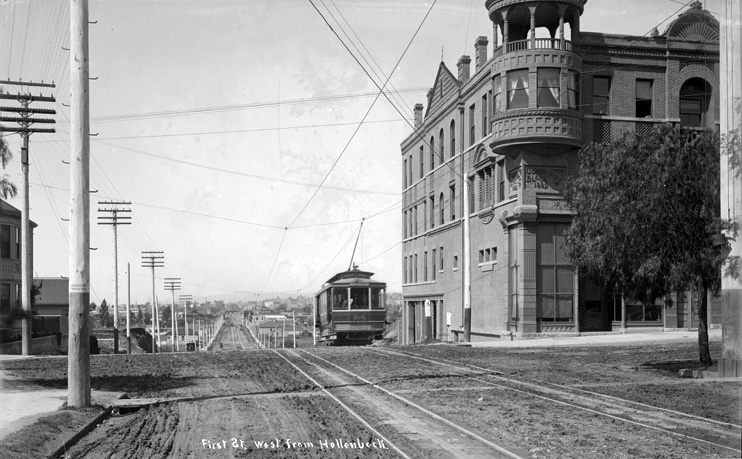 |
|
| (ca. 1895)* - View looking west on 1st Street at Boyle Avenue. An electric streetcar passes by the Boyle Hotel located on the northwest corner. |
Historical Notes In 1858, Irish-born Andrew A. Boyle (1818–1871) came to Los Angeles from San Francisco (having also previously lived in New Orleans and Texas after his 1832 migration to America.) Boyle built the first brick house east of the Los Angeles River and cultivated the Lopez vineyards, manufacturing and selling wine under the Paredon Blanco name. He also operated a shoe store in Los Angeles and was a member of the city council. After Andrew Boyle's death in early 1871, his property passed to his only daughter and her husband, William Henry Workman (1839–1918), a saddler and rising politician in town. As the first growth boom was underway in the Los Angeles area, Workman decided to subdivide part of Paredon Blanco. In Spring 1875, he partnered with banker and real estate speculator Isaias W. Hellman and John Lazzarovich, who was married to a member of the Lopez family, and announced the creation of the new neighborhood of Boyle Heights. Before long, the growth boom ended, largely because of the failure of the bank co-owned by Workman's uncle, William Workman (1799–1876), owner of the Rancho La Puente in the eastern San Gabriel Valley. It was not until the next development boom, which took place during Workman's tenure as mayor in the 1887-88 period, that Boyle Heights grew rapidly and became a desirable residential area for middle and upper middle class Angelenos. Some large Victorian-era homes still survive in Boyle Heights as testament to the late nineteenth-century status the neighborhood possessed. |
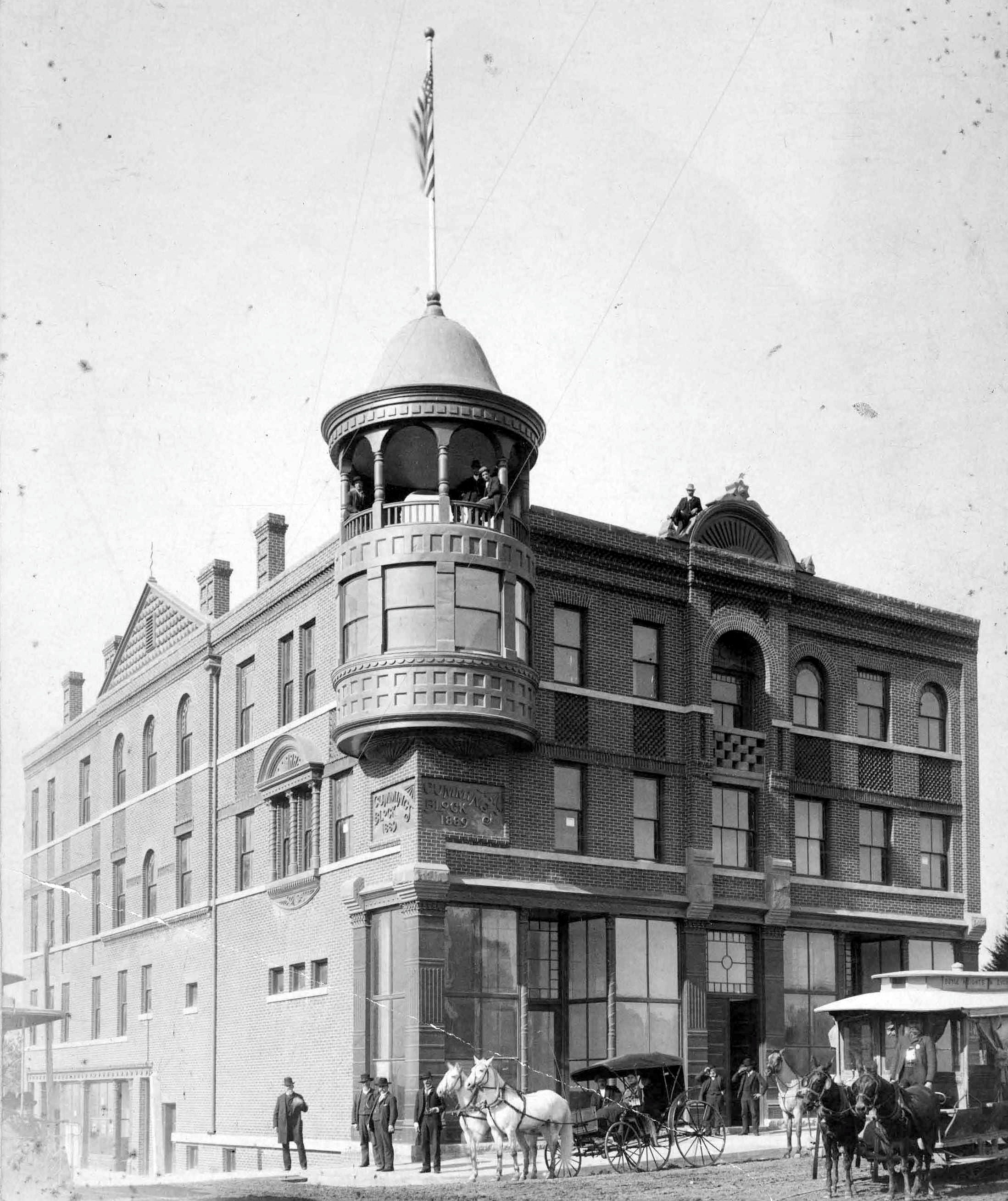 |
|
| (1889)* - View of the Boyle Hotel-Cummings Block on the northwest corner of 1st and Bolye Ave. A horse-drawn carriage is parked at the curb while a group of men stand behind it on the sidewalk. A horse-drawn streetcar is in the lower right. Also, several men can be seen on the building roof balcony and parapet. |
Historical Notes Located at the corner of Boyle Avenue and E. First Street in Boyle Heights, the Boyle Hotel, also known as the Cummings Block, is one of the oldest remaining commercial structures in Los Angeles and is significant for its many layers of history. Designed by architect W. R. Norton and built in 1889 for community leaders George Cummings and his wife Maria del Sacramento Lopez, this Victorian-era hotel became a social and political center for the community and encouraged the residential and commercial development of Boyle Heights. The building features decorative patterned brickwork, cast iron storefront columns, and a corner turret with an open belvedere. |
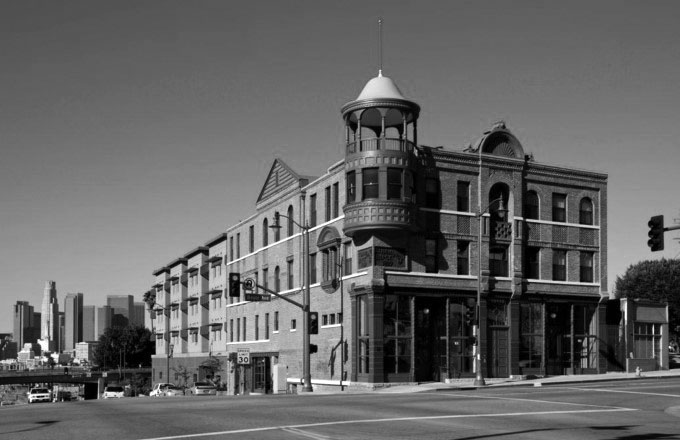 |
|
| (2012)#*^ - View looking west on 1st Street at Boyle Avenue shortly after the building was renovated. |
Historical Notes In 2012, renovation of the relic of Victorian-era Boyle Hotel was completed with a turret, arches and a domed cupola crowning the four-story brick building. The East Los Angeles Community Corp., a nonprofit developer, restored the Victorian Italianate-style building, as part of an approximately $25 million project to transform the former hotel into affordable housing. #^^ |
Then and Now
.jpg) |
 |
| (1895 vs 2012) - Looking west on 1st Street at Boyle Avenue. Comparison by Jack Feldman. |
Historical Notes In the twentieth century, the building became associated with the many mariachi musicians who rented rooms in the hotel and gathered in the adjacent plaza to await customers. Although the condition of the building deteriorated through the years and some of the decorative elements were removed, the Boyle Hotel underwent a full-scale rehabilitation that renovated the interior for use as apartments and restored missing architectural elements, such as the upper portion of the corner turret. |
Then and Now
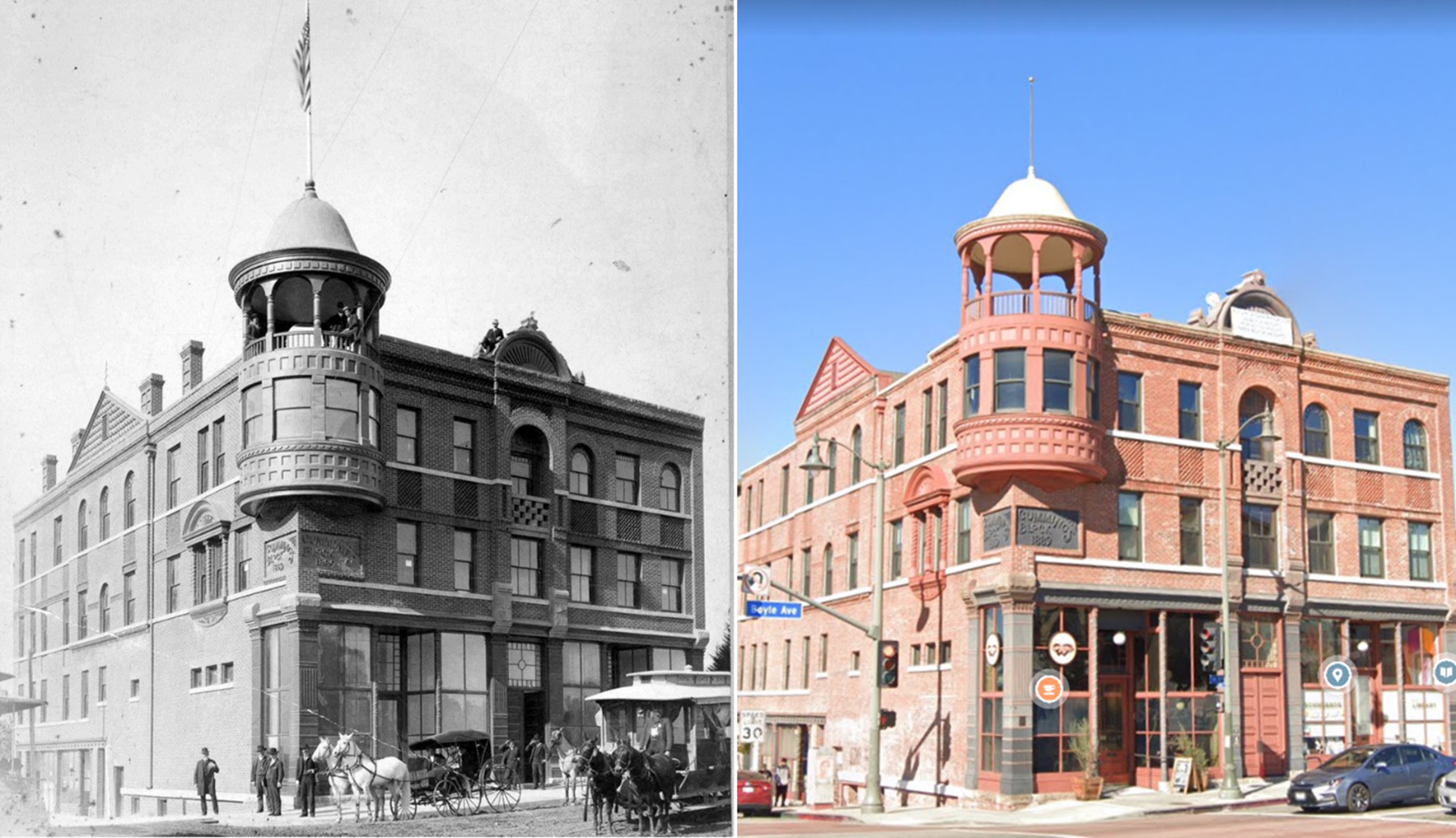 |
|
| (1889 vs 2023)* - Boyle Hotel, NW corner of Boyle and 1st in Boyle Heights. Photo comparison by Jack Feldman. |
Then and Now
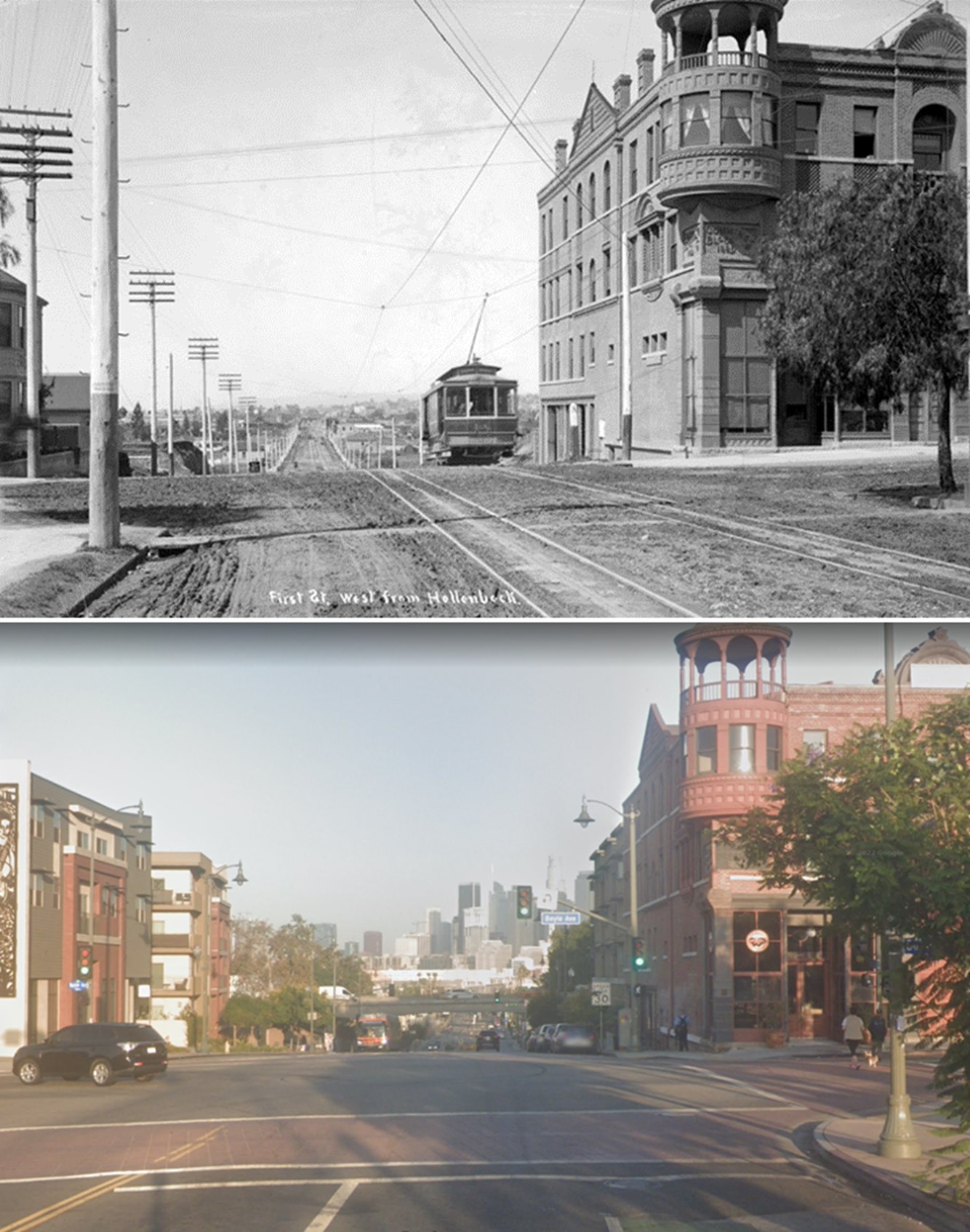 |
|
| (1895 vs 2022)* - Looking west on 1st Street at Boyle Avenue. Photo comparison by Jack Feldman. |
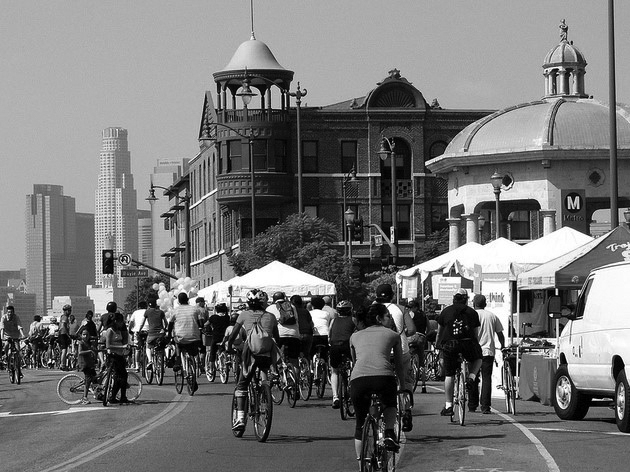 |
|
| (2014)^# – Weekend bike riders head west on 1st Street at Boyle Avenue. The beautiful Boyle Hotel stands tall on the corner with the downtown skyline in the background. Photo by Victoria Bernal |
Historical Notes The Boyle Hotel was declared Los Angeles Historic-Cultural Monument #891 in 2007. |
* * * * * |
Horse-Drawn Streetcars
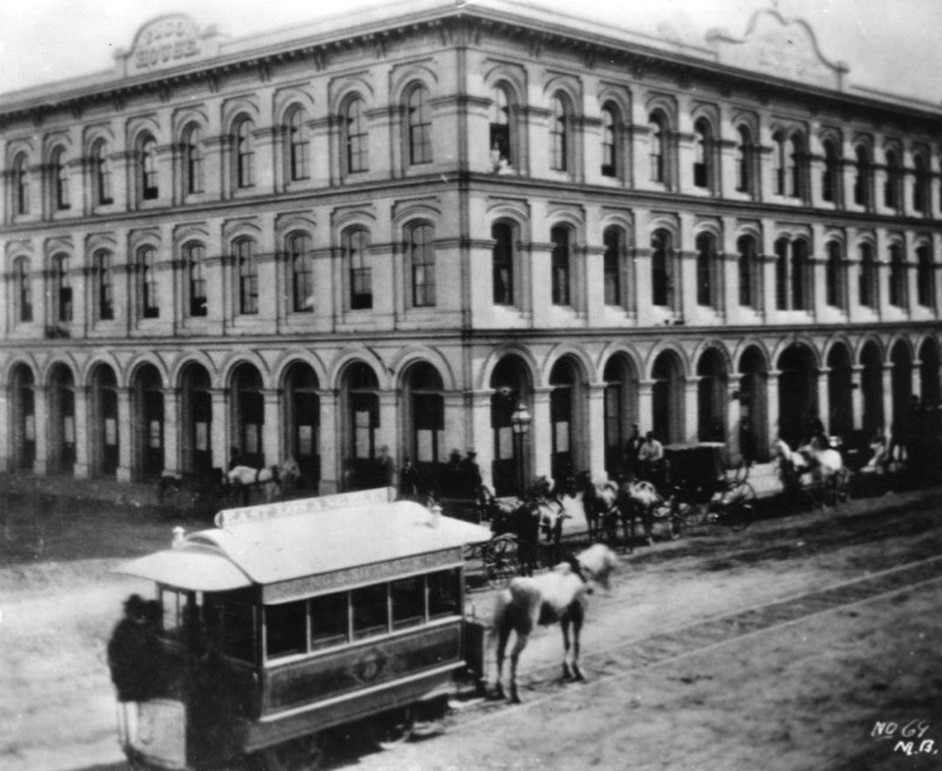 |
|
| (1870s)* - View showing one of the first horse-drawn streetcars in Los Angeles in front of the Pico House, across the street of the LA Plaza. It was part of Spring & Sixth Railway. |
Historical Notes Los Angeles' first streetcars were horse-drawn, as steam locomotives were deemed too dirty and dangerous for city streets, and cable car technology was still new and costly. Electric-powered traction railways were not yet available. On July 1, 1874, the horse-drawn cars of the Spring and Sixth Street Railroad, founded by lawyer Robert M. Widney, became the first streetcars to operate in Los Angeles, running hourly on weekdays from 6:30 a.m. to 10 p.m. Passengers paid a ten-cent fare to ride the one-and-a-half-mile route from Temple and Spring south to Sixth, then west to Figueroa. The city's streetcar network quickly expanded, with new railways and extended lines radiating from The Plaza, the central hub. |
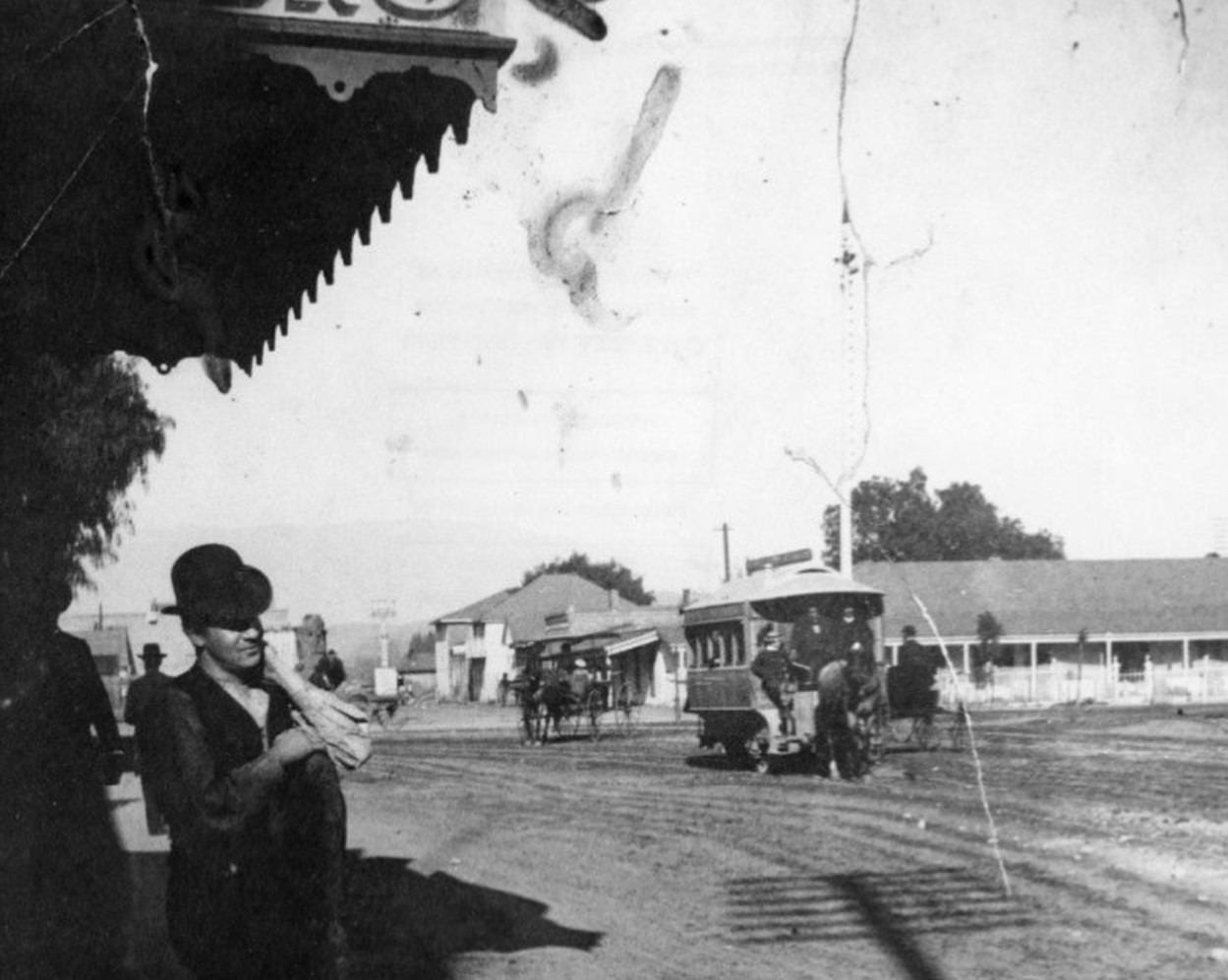 |
|
| (1882)* - A man wearing a bowler hat (aka derby) gazes out towards the Los Angeles Plaza. A horse-drawn streetcar, one of Los Angeles’ first modes of public transportation is seen to the right. |
Historical Notes In the 1880s, horse-drawn streetcars were a crucial part of Los Angeles' urban transportation, especially around the historic LA Plaza. Operating from 1874 to about 1888, these streetcars, or horsecars, served as the main public transit before electric streetcars emerged. The LA Plaza was the central hub for these streetcars, enabling efficient movement across the city. Typical horsecars featured open compartments, transverse seats, a center aisle, and platforms for the driver and conductor, accommodating around 30 passengers. |
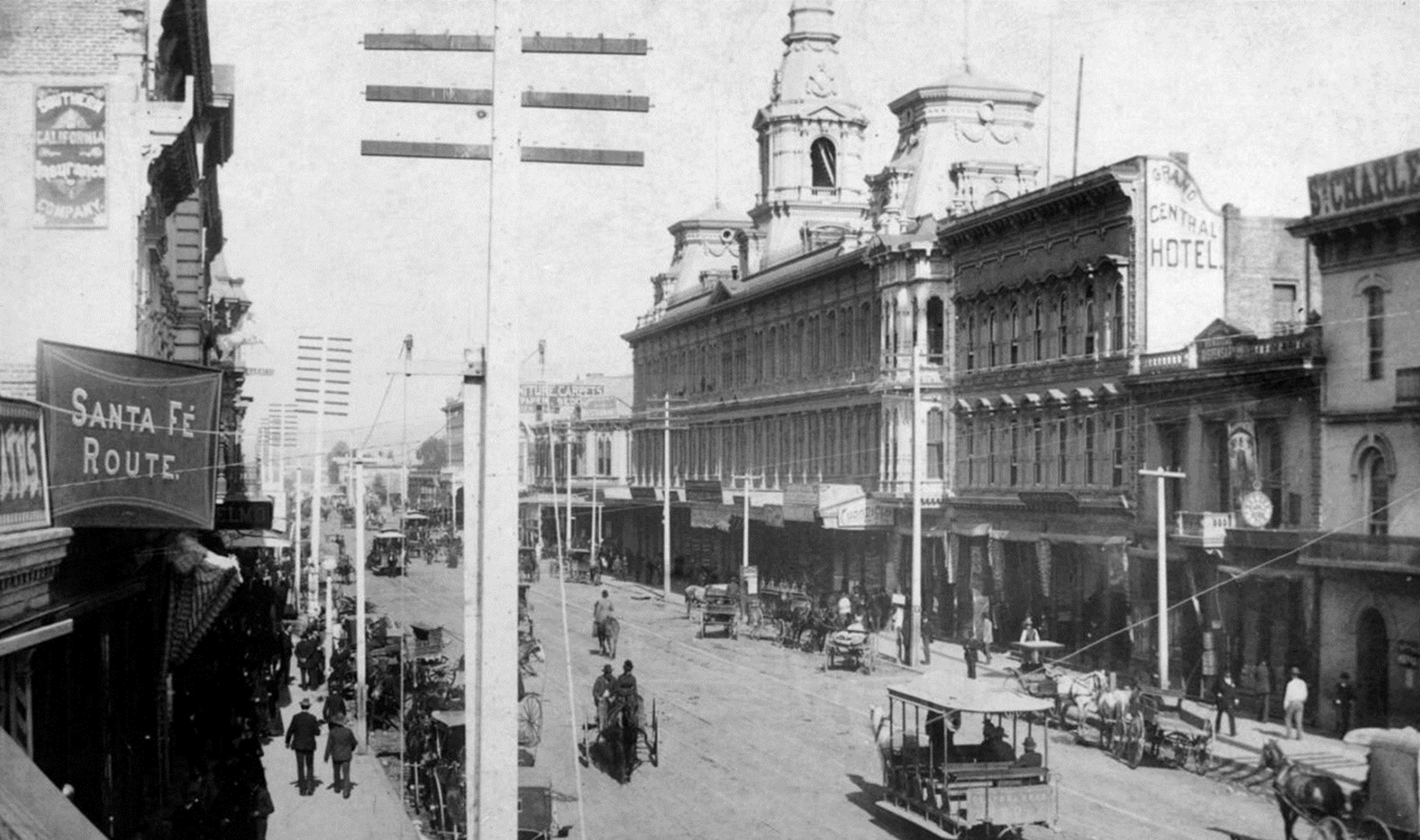 |
|
| (1888)* – A view looking north on the 300 block of Main Street, featuring horse-drawn streetcars, wagons, and a man on horseback. The ornate Baker Block stands at center right, while the St. Charles Hotel, one of LA’s first hotels, is visible at far right. |
Historical Notes In 1888, the 300 block of North Main Street was a bustling hub at the heart of Los Angeles' commercial district, reflecting the city’s rapid transformation. Once considered the uptown commercial center, it featured a mix of hotels, banks, and other businesses, including the Farmers & Merchants Bank in the Pico Building, Los Angeles' first incorporated bank. Horse-drawn streetcars dominated the busy streets, while the introduction of telephones and telegraphs showcased the city’s embrace of new communication technologies. As the population surged from 11,183 in 1880 to 50,395 by 1890, the area became a focal point for expanding transportation networks and new neighborhoods, symbolizing Los Angeles’ shift from a small town to a thriving metropolis Click HERE to see more in Early Views of the 300 Block of North Main Street. |
 |
|
| (1889)* - Before being run by electric lines, the cable cars were pulled by horses. Shown here is the horse barn at 12th and Olive Streets which ran the "red line", running from Broadway out E. 1st St. to Boyle Heights, Broadway to 7th, west on 7th to Westlake Park. The sign on the barn reads "Los Angeles Cable Railway Co." |
Historical Notes In 1887, there were several streetcar lines operating in the Los Angeles area almost all utilizing horses and mules as motive power. That year the Los Angeles Cable Railway Company purchased most of these lines and began to expand the streetcar system with electric-powered streetcars. |
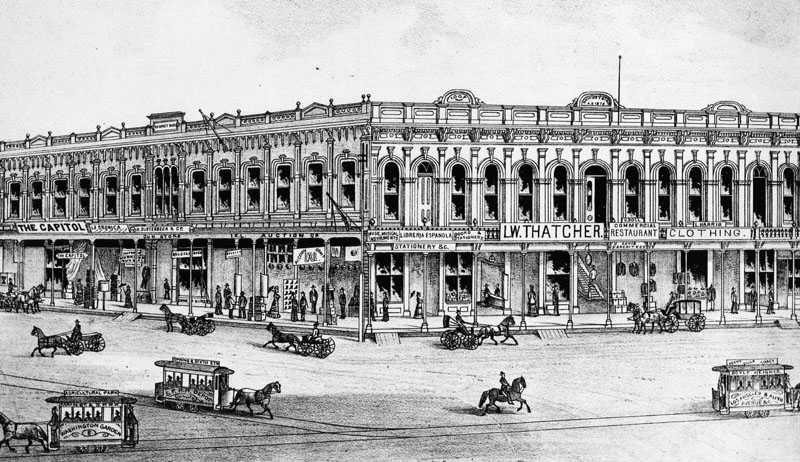 |
|
| (ca. 1880s)* - Drawing of the Downey Block on the northwest corner of Main and Temple Streets. Various horse-drawn vehicles are seen on the street, including horse-drawn streetcars to Agricultural Park/Washington Garden, Spring & 6th Streets/S.P.R.R. Depot, and Boyle Heights/Los Angeles and Aliso Avenue/Perry Villa Tract. |
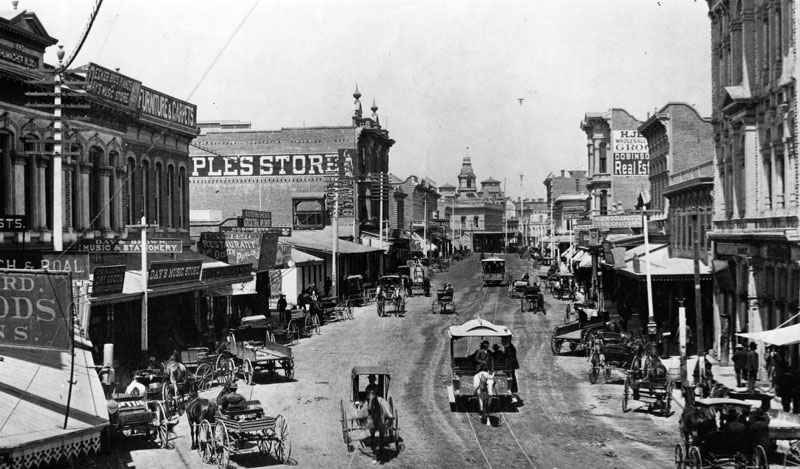 |
|
| (1885)* - Spring Street near First looking north. Hamburger & Son's People's Store is seen in mid-block. The copula of the Baker Block (built in 1878) can be seen in the distance. Horse-drawn streetcars and wagons are seen throughout. |
Historical Notes The first streetcar line on Spring Street began operation on July 1, 1874, with the introduction of the Spring and Sixth Street Railroad. These were horse-drawn cars that ran on rails embedded in the street. By 1887, electric streetcars started replacing horse-drawn vehicles on Spring Street. The Los Angeles Electric Railway began electrifying lines around this time. |
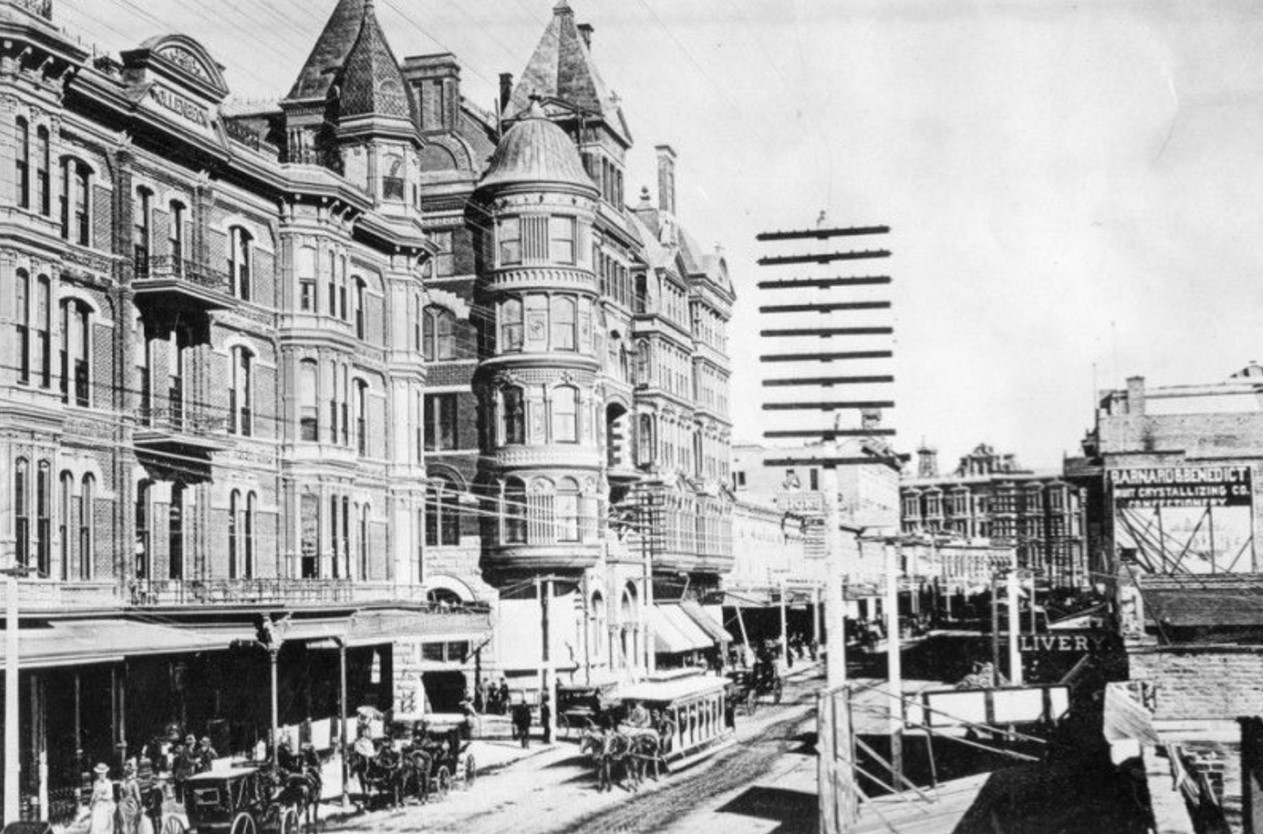 |
|
| (1888)* - View of Spring Street at 2nd Street, looking north. The Hollenbeck Hotel is on the left (southwest corner). The Bryson-Bonebrake Block can be seen across the street on the northwest corner. A horse-drawn streetcar is in the middle of the street and two horse-drawn carriages are seen parked at the curb. |
Historical Notes Horse-drawn streetcars remained the primary mode of public transportation through the 1880s, at their peak rolling through much of the booming city of Los Angeles. But soon technological innovation would doom the horse-powered street railway with the introduction of electric cable streetcars. |
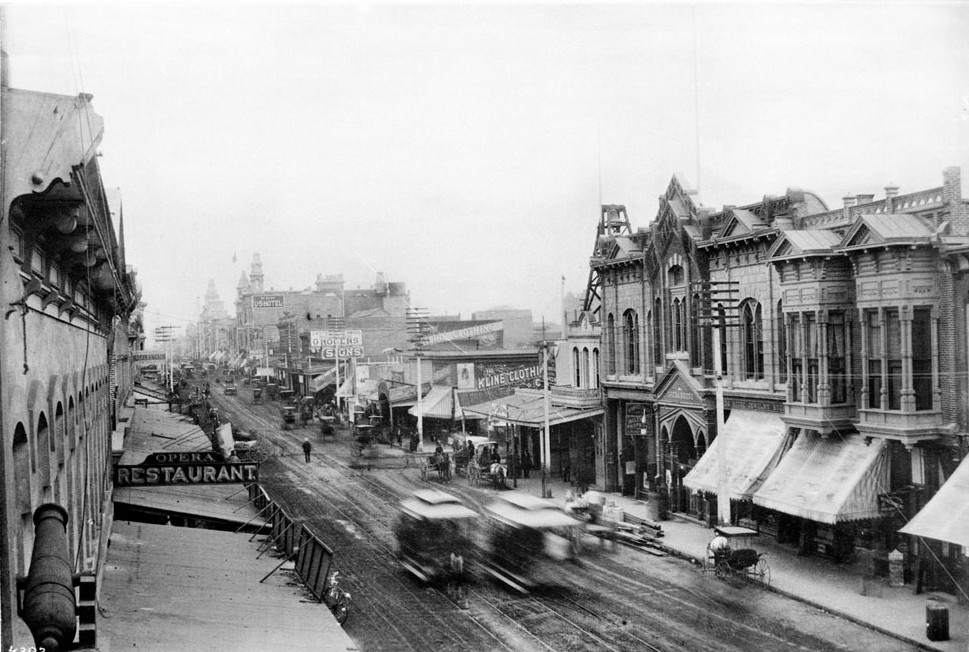 |
|
| (ca. 1888)* - View looking north on Main Street from 2nd Street showing horse-drawn streetcars passing each other in the center of the road. A cannon is visible on the parapet at the lower left of the photo. Streetcars and numerous horse-drawn wagons and carriages move up and down the dirt street or are parked along the curb. The sign on the left reads: OPERA RESTAURANT. |
Historical Notes The era of horse-drawn streetcars in Los Angeles was relatively short-lived. By 1885, cable cars began to replace horse-drawn vehicles, especially on hilly routes. The transition to electric streetcars started in 1887 with the Los Angeles Electric Railway. By 1897, the last horse railway in Los Angeles, the Main Street and Agricultural Park Street Railroad, converted to electric power. |
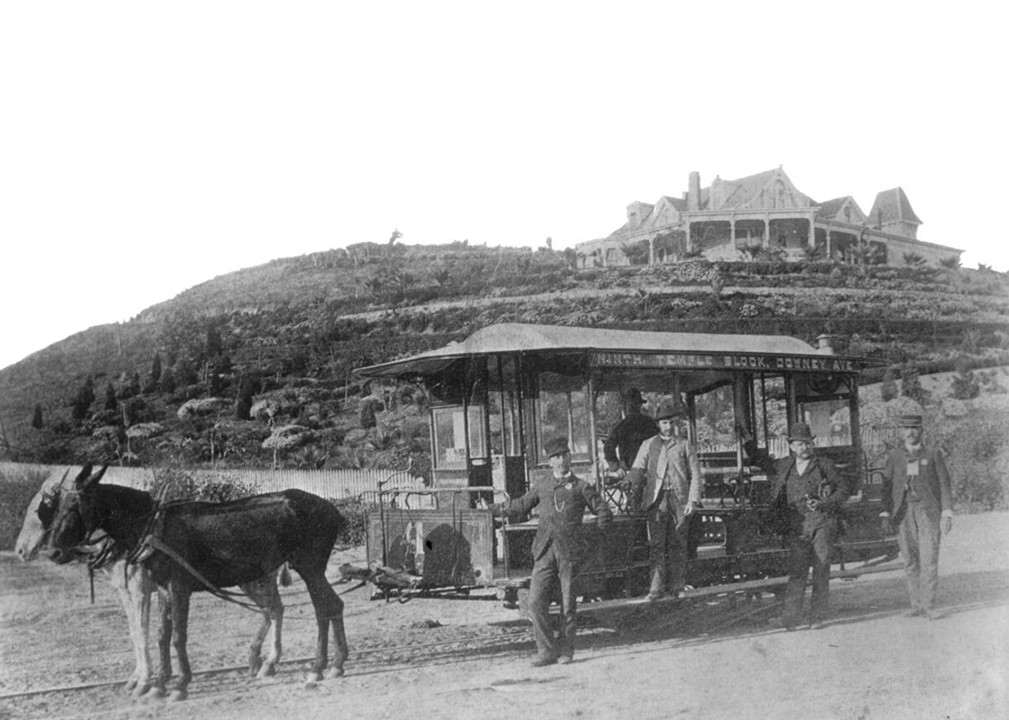 |
|
| (1889)* – View showing five men in and around a mule-drawn streetcar stopped at the corner of Downey Avenue (now North Broadway) and Pritchard Avenue (now Lincoln Park Avenue) in Los Angeles. The home of Baron Rogniat is visible on the hill in the background. This site later became the location of Lincoln Heights High School in 1942 after the Rogniat mansion burned down on May 17, 1891. Photo by C. C. Pierce |
Historical Notes Horse-drawn and mule-drawn streetcars remained the primary mode of public transportation through the 1880s, at their peak rolling through much of the booming city of Los Angeles. But technological innovation would doom the horse-powered street railway. Cable -- and later electric -- railways offered a clear advantage over horse-drawn streetcars. Horses fouled up the streets and struggled on even slight grades, meaning that the hilly terrain to the west of L.A.'s early business district was inaccessible to horse-powered public transit. Cable cars, on the other hand, were cleanly whisked through town by underground cables pulled by a remotely located, stationary steam engine. And as Andrew Hallidie's Clay Street Hill Railroad in San Francisco had proved, cable cars had no trouble climbing steep grades. In 1885, the cable cars of the Second Street Cable Railway began scaling the slopes of Bunker Hill, opening up the city's western reaches to development. Newer technology promptly replaced many of the city's horse-drawn streetcars. Los Angeles' last horse railway, the Main Street and Agricultural Park Street Railroad, traded in its horses for electric wires in 1897.^ |
* * * * * |
Pacific Railway Compnay (formerly LA Cable Railway)
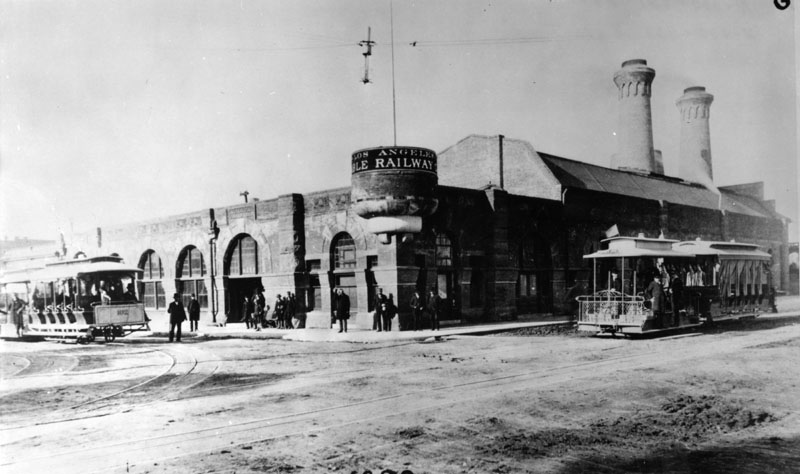 |
|
| (ca. 1888)^ - Two separate cable cars arrive at the same location (7th and Grand) from different directions. The corner building is the main power station for the Pacific Railway Company (formerly Los Angeles Cable Railway). |
Historical Notes In September 1888, the Los Angeles Cable Railway Company sold their controlling interest to C. B. Holmes, and associates, of Chicago, Ill. They organized a new company, known as the Pacific Railway Company, capitalized at $5,000,000.00 and finished the construction of the cable lines, which when completed covered many of the LA streets with double tracks.* |
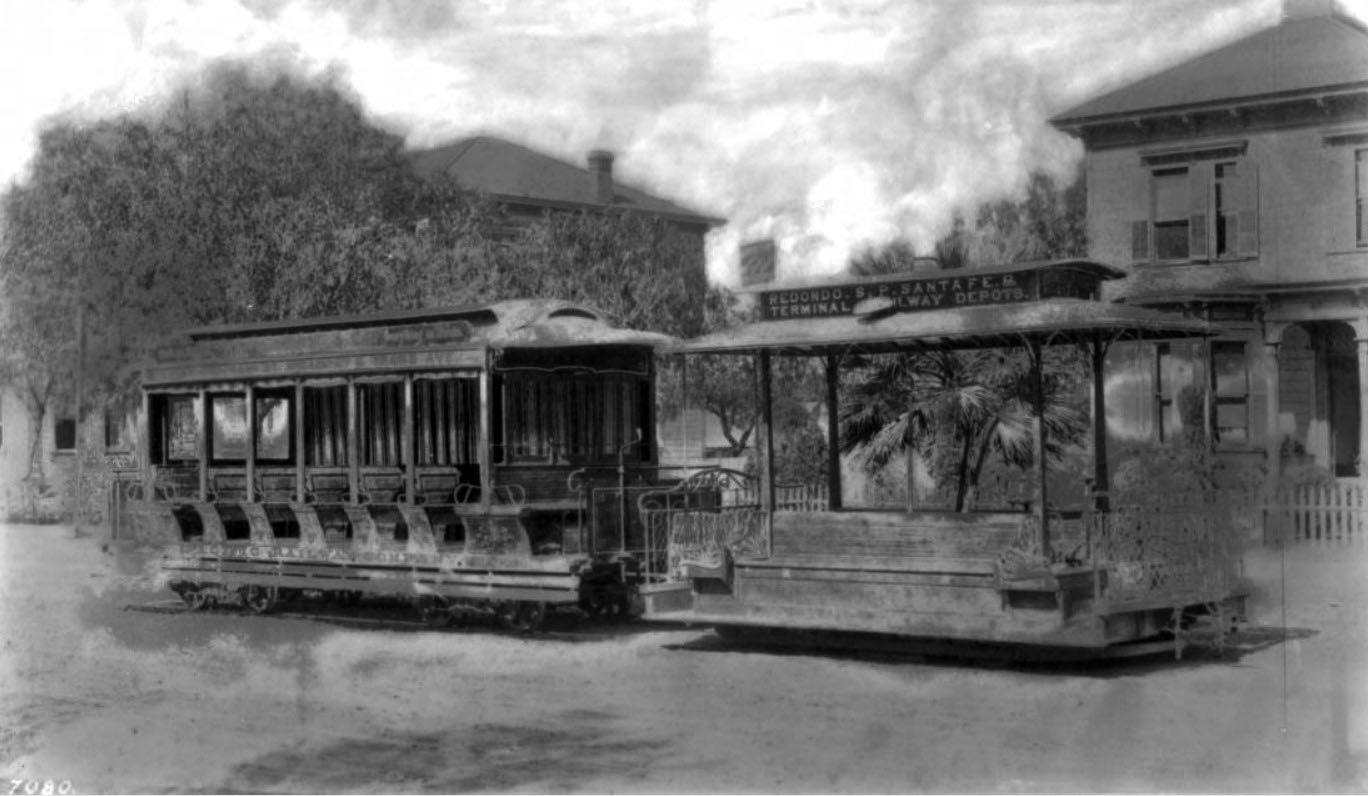 |
|
| (ca. 1889)^^ – Close-up view of a Grand Avenue Line cable car with its trailer looking south on Grand Avenue between Seventh Street and Eighth Street, showing the Eighth and Grand School in the background. The open-air trailer car with its wrought-iron guard rails stands to the right, with a sign that reads "Redondo, S.P. Santa Fe & Terminal Railway Depots". The main car stands hitched to it to the left, its striped door-flaps down on the far side. Its signs read: "Hawley King & Co. / Everything on Wheels", "[...] Main St., Broadway & Grand Ave." and "Pacific Railway Company". The 8th and Grand School is visible just behind heavy tree cover to the left. |
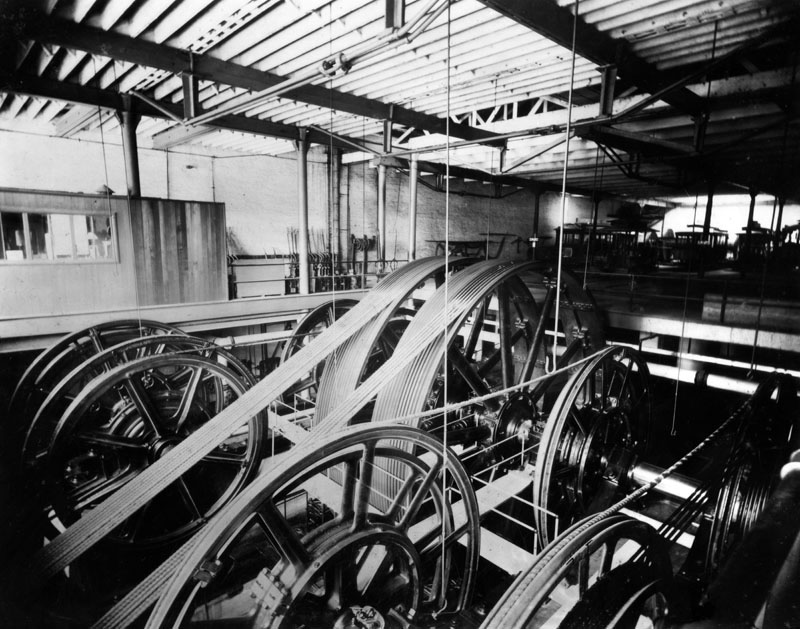 |
|
| (1890s)^ - Interior view of the Pacific Railway Company (originally Los Angeles Cable Railway), located at 7th and Grand, where huge wheels controlled the lines pulling the cable cars. |
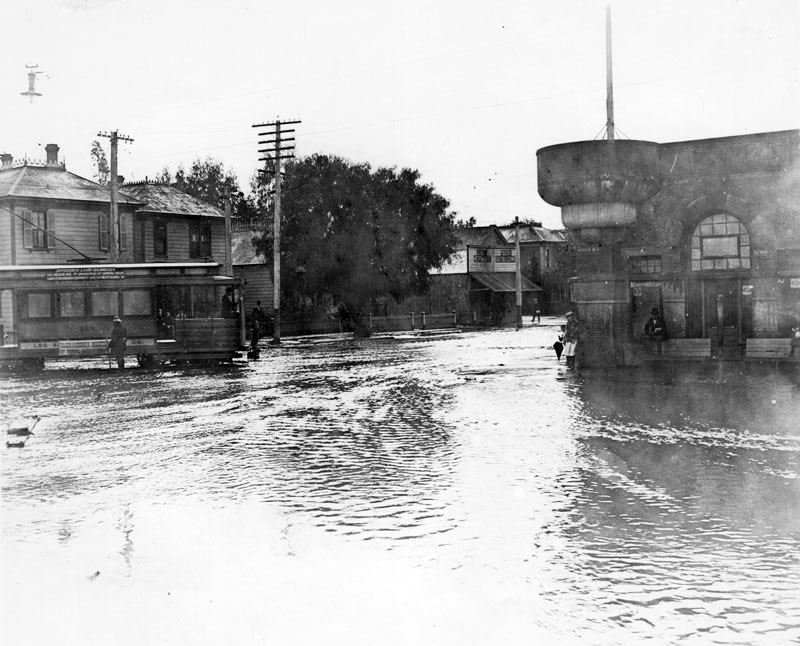 |
|
| (1890s)^ - View of a flooded intersection at 7th Street and Grand Avenue. On the right, two men stay on high ground trying to avoid the rising water. To the left, a cable car appears to be stalled in the middle of the intersection. |
Historical Notes The principal power station for the Pacific Railway Company was at Seventh Street and Grand Avenue. Between 1904-1910, this building was used as a Post Office. Later, J. W. Robinson’s Dry Goods would build their first store at this corner.* |
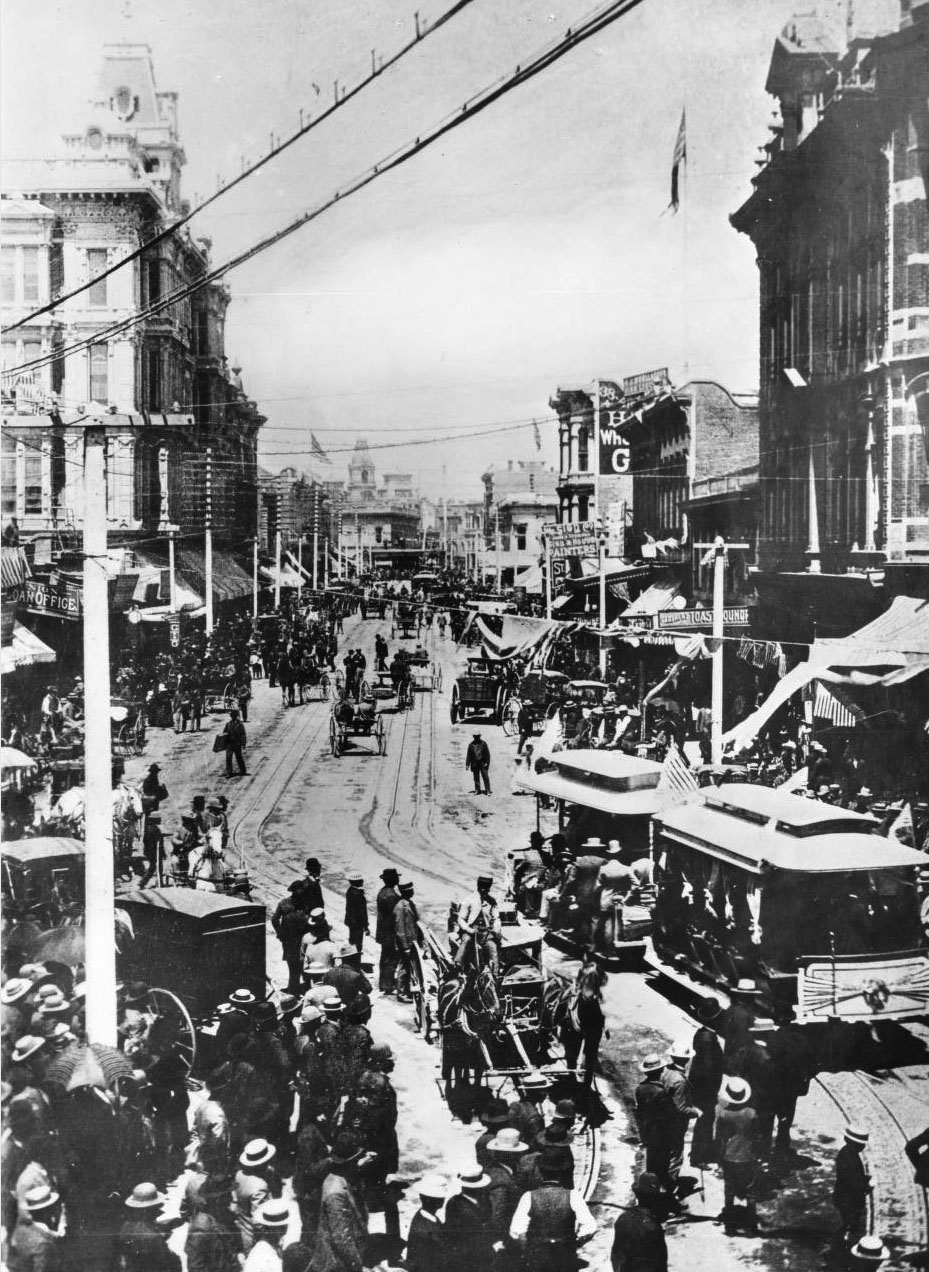 |
||
| (1889)^^ - Spring Street looking north from the Nadeau Hotel on 1st Street. This event marked the opening day of the double-track cable line, June 8, 1889. |
Historical Notes The Pacific Railway Company was formed in 1888, and soon thereafter purchased the holdings of a financially strapped Los Angeles Cable Railway Company. With a new influx of capital ($5,000,000) they began expanding the Los Angeles area cable car system with double tracks. The first section of the cable road was put in operation on June 8th, 1889, and routed from Seventh and Grand Avenue, via Seventh; Broadway; First; Spring; Main to Requena and Main Streets.*##* |
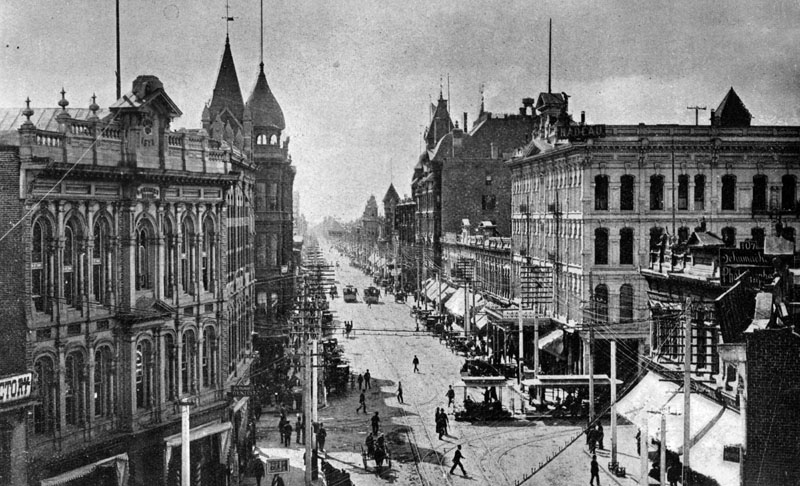 |
|
| (ca. 1889)^ - View looking south on Spring Street at 1st Street showing cable streetcars. The 4-story Nadeau Hotel stands on the southwest corner of Spring and 1st. |
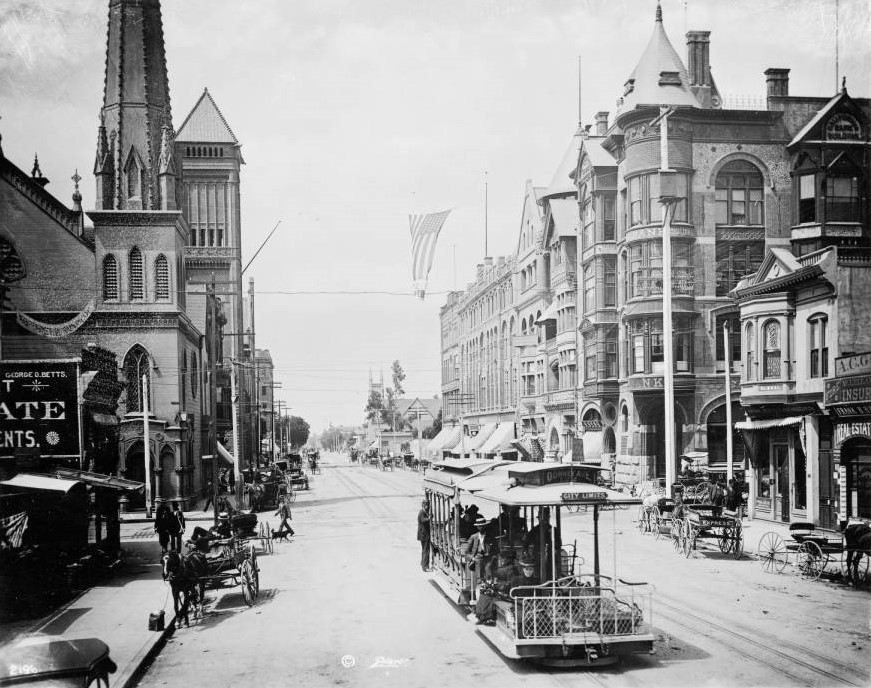 |
|
| (1889)#^ - View looking south on Broadway showing a cable streetcar with sign reading "Downey Avenue". The First Presbyterian Church can be seen on the southeast corner of Second Street and Broadway (left) with City Hall (LA's 3rd) several lots behind it. The California Bank Building stands on the southwest corner on the right. Also seen are horse-drawn carriages parked along the curbs. |
Historical Notes Los Angeles’3rd City Hall was built in 1888 at 226-238 South Broadway. California Bank Building was built in 1887, southwest corner of 2nd and Broadway. |
* * * * * |
Main, Spring, and Temple Junction
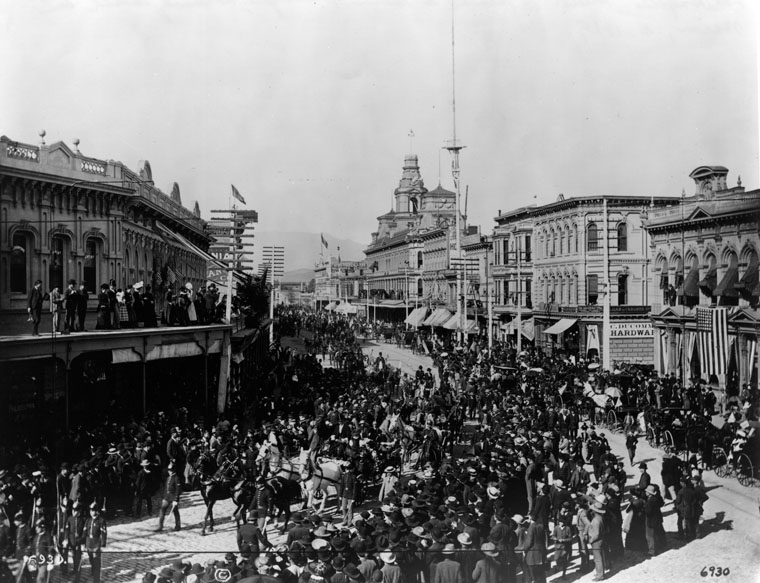 |
|
| (ca. 1889)^ - A parade at the junction of Main, Spring, and Temple streets, looking north. The Downey Block is on the left. Baker Block with its tall cupola is in the background. Also, the City's new 150-ft tall electric light pole can be seen in the center of the photo. Click HERE to see more in Early L.A. Streetlights |
Click HERE to see more Early Views of the Main, Temple, and Spring Street Junction |
Los Angeles Plaza
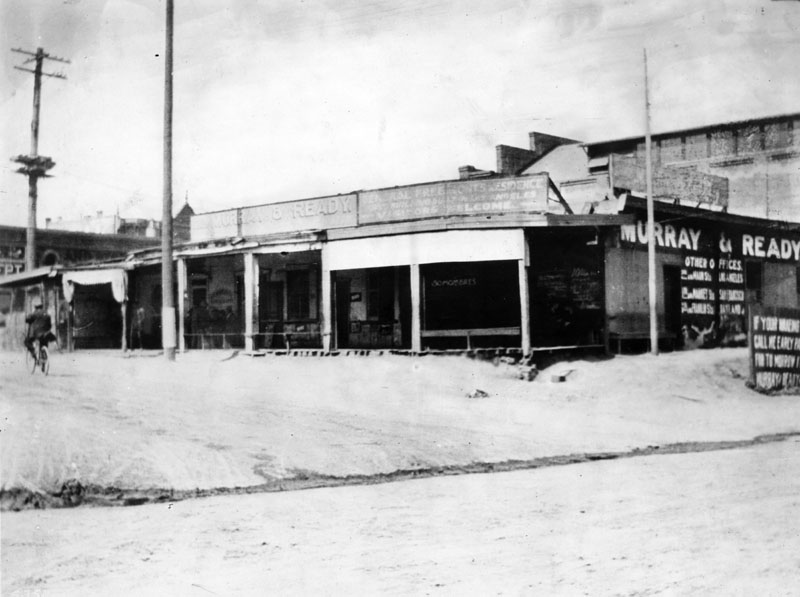 |
|
| (ca. 1903)^ – View looking northwest showing the Olvera Adobe (converted to office space), on the north side of the Plaza, facing Marchessault St. Olvera Street is out of view, west of the adobe. Los Angeles St (running left to right in the foreground) is on the adobe's east side. The building behind the Olvera Adobe, with the stepped gable end, is a Pacific Electric Power Station. It was built in 1903. |
Historical Notes Agustín Olvera arrived from Mexico in 1834 where he had been a Justice of the Peace, and held various offices in the Mexican administration. In 1842 he was granted Rancho Mission Viejo, and three years later, was also granted the 35,501-acre Rancho Cuyamaca. Olvera is noted for helping to bridge the gap between the governance of California by Mexico and the U.S.; helping sign the Treaty of Cahuenga, thus ending the war in California; was appointed to be Judge of the First Instance in 1849; was elected as the first county judge of the newly formed County of Los Angeles in 1850; and eventually entered private practice law. In 1877, the Los Angeles City Council changed the name of Wine Street to Olvera Street in his honor. Marchessault Street is named for French Canadian, Damien Marchessault, who served as mayor of Los Angeles from 1859-1860, and again from 1861-1865. During his term in office, the Plaza Church was rebuilt and the City Gas Company was organized. Marchessault committed suicide in the city council chamber in 1868, after becoming despondent over public criticism of the water system and over gambling debts.^ |
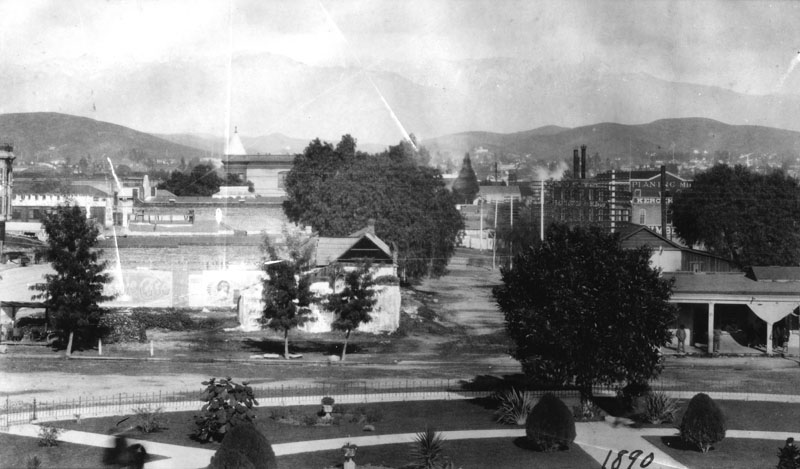 |
|
| (1890)^ - View across the L.A. Plaza to the beginning of Olvera Street. The view is to the north. The Olvera Adobe can be seen to the right on the northeast corner of Olvera and Marchessault streets. |
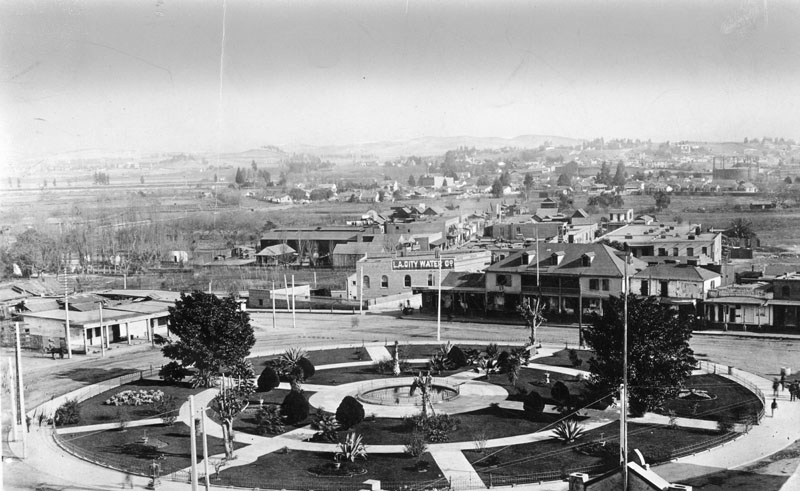 |
|
| (ca. 1890)* - The Los Angeles Plaza, around 1890. The one story building on the left is the former residence of Don Augustin Olvera. The large two story on the right is the former residence of Don Vicente Lugo. The LA City Water Company is at the northwest corner of Marchessault and North Alameda. Some of the area shown is now occupied by the Union Terminal. |
Historical Notes In 1868, the City of Los Angeles approved a franchise water agreement on a 30 year lease basis with the private Los Angeles City Water Company. In 1899, after the end of the lease, a $2.09 million bond measure for the purchase of LA City Water Co.’s system was approved by city voters by a margin of nearly eight to one. After over two years of litigation the City of Los Angeles finally regained control of its water system on February 3, 1902. A new department was created called the Los Angeles Water Department. Once the purchase was completed, the Los Angeles City Water Department acquired all assets of the privately owned water system including its main office building at Marchessault and North Alameda. Click HERE to see more in Water Department's Original Office Building. |
Click HERE to see more in Early Plaza of L.A. |
Taylor Grocery and Taylor Milling Co.
.jpg) |
|
| (ca. 1890s)#*^* - View showing the Taylor Grocery and, left, Taylor Milling Company, located on San Fernando Road adjacent to the Los Angeles River not too far from where the L.A. Pueblo was established. |
Historical Notes In 1781, the Pueblo was established just downstream from the above site, on the river's west bank. The alignment now known as San Fernando Road provided the major access route between the Pueblo of Los Angeles and the Mission San Fernando. Starting in the late 1890’s, the site was owned by J. Hartley Taylor. Mr. Taylor was a prolific entrepreneur who owned the Taylor Grocery and the Taylor Milling Company, a commercial feed manufacturer on San Fernando Road. Taylor raised oats, barley, hogs and pigeons on the riverfront land. #*^* |
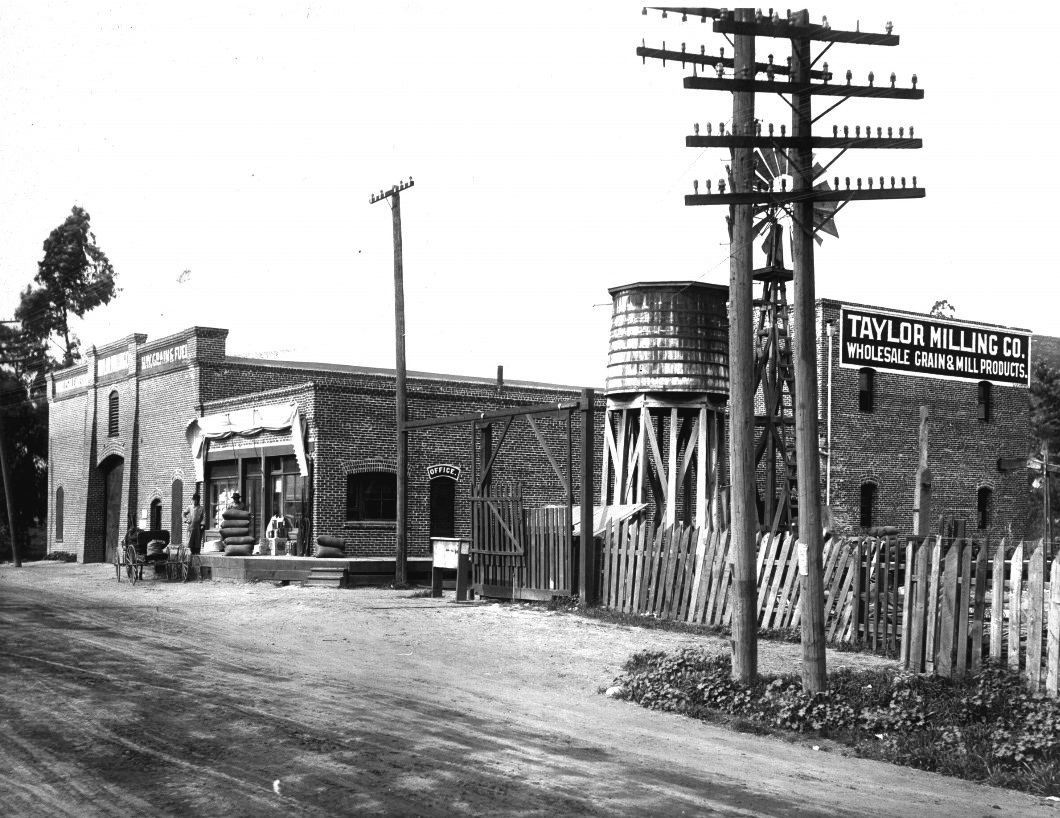 |
|
| (ca. 1890s)#*^*- Another view of Taylor Grocery and Taylor Milling Co. on San Fernando Road. |
Historical Notes The Taylor property became a railyard yard in the 1920’s, when Southern Pacific Railroad outgrew its Midway Yard facility. It was commonly referred to as the Taylor Yard. #*^* Click HERE to see more Early Views of the Taylor Yard. |
Los Angeles County Courthouse
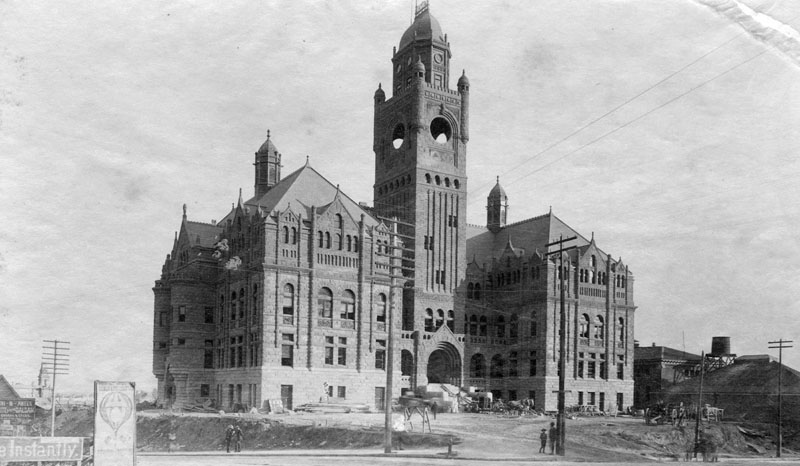 |
|
| (1891)^ - View showing the Los Angeles County Courthouse nearing completion. Construction began in 1888. Broadway is in front, Temple Street on the left, and New High Street behind. The holes seen in the main tower are for the yet to be installed clocks. |
Historical Notes Constructed in 1891, the Los Angeles County Courthouse stood where the city’s first high school, Los Angeles High School, had been located. The high school was there from 1873 until 1886 when it was moved to North Hill Street to allow for construction of the courthouse. |
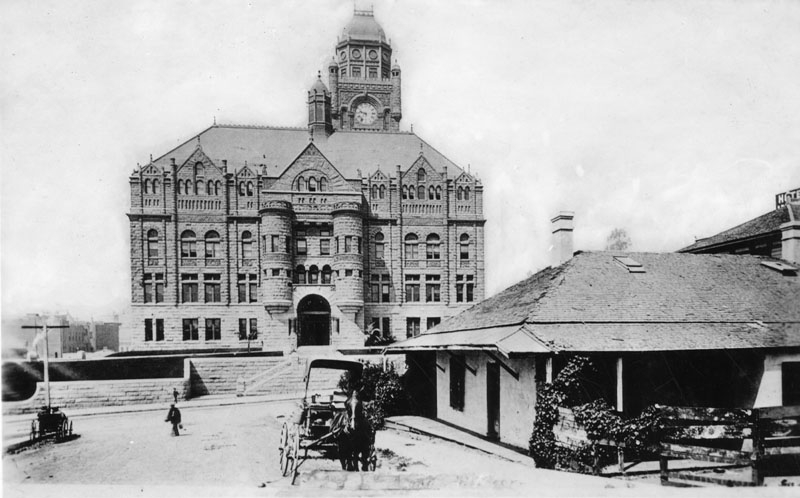 |
|
| (ca. 1891)^ - View looking south across Temple Street showing of Belderrain Adobe (foreground) as it sits in the shadow of the newly constructed Los Angeles County Courthouse. |
.jpg) |
|
| (ca. 1891)* - View of the Los Angeles County Courthouse shortly after it was built. Streetcar can be seen on Temple Street. |
Historical Notes This building served as the courthouse until 1932, when it sustained damage in the Long Beach earthquake, and was demolished in 1933. |
 |
|
| (ca. 1891)* - Corner view of the Los Angeles County Courthouse. Horse-drawn wagon is heading west on Temple Street while pedestrians are seen walking up the incline along the courthouse bulding. Note the addition of palm trees. |
Historical Notes Click HERE to see more Early Views of the LA County Courthouse (1891 - 1933). |
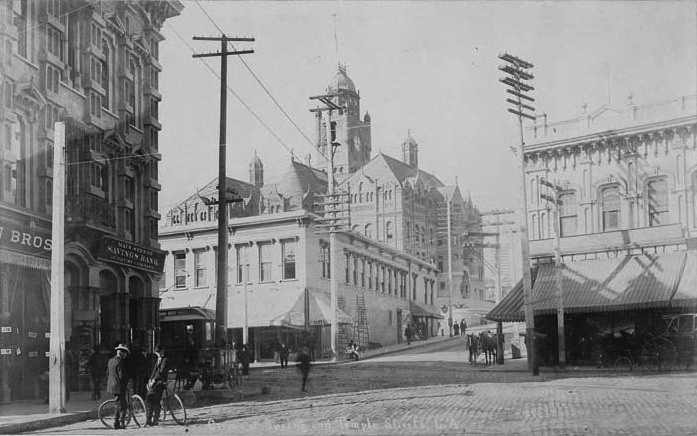 |
|
| (1891)* - Corner of Spring and Temple looking west. The Temple Block is on the left behind the two men leaning on their bicycles. This is the current site of the Los Angeles City Hall. The LA County Courthouse can be seen in the background (Broadway and Temple). To the right is the Downey Block (NW corner of Temple and Main St). |
Court and Spring Streets
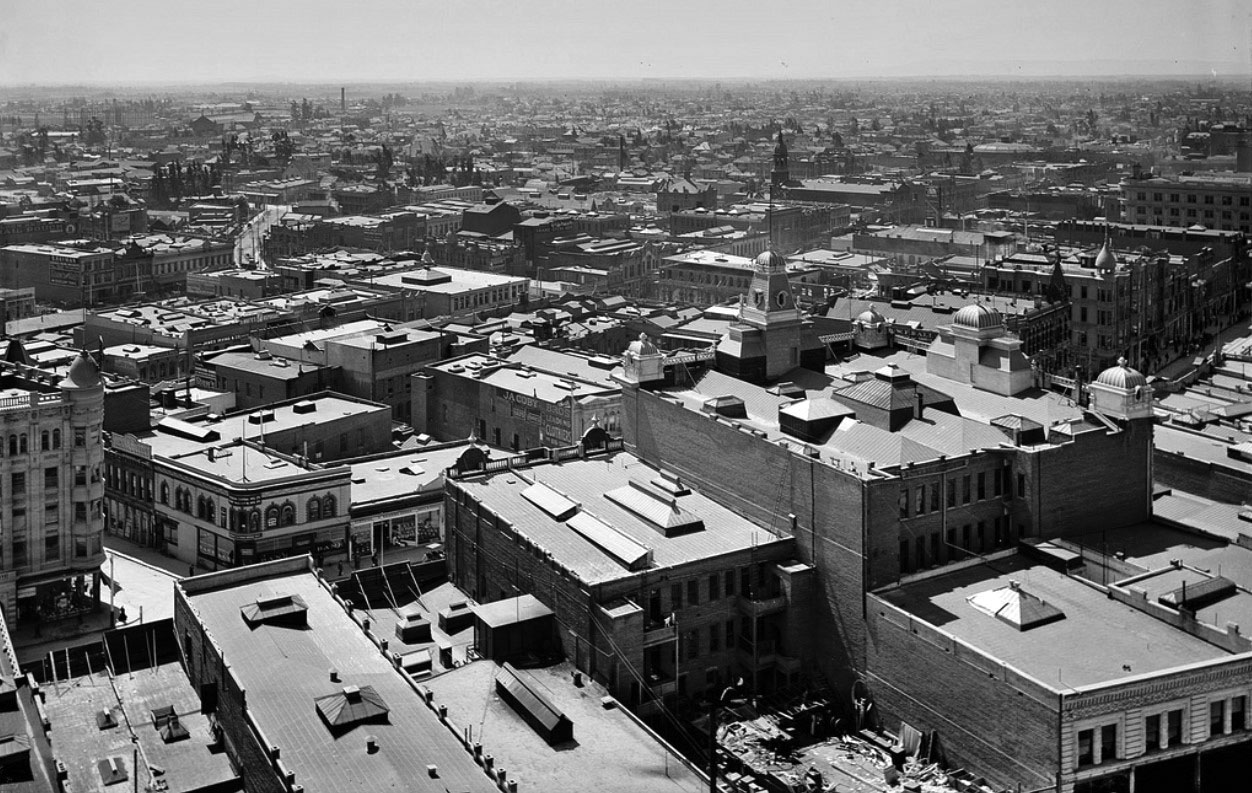 |
|
| (1899)^.# – Panoramic view looking southeast as seen from the from the top of the new LA County Courthouse. The intersection of Spring and Court streets can be seen at lower- left. On the NE corner stands the newly constructed Bullard Building which replaced the 1858-built Clocktower Courthouse. The very large building at center-right with the ornate roof line is the Phillips Block, built in 1887. |
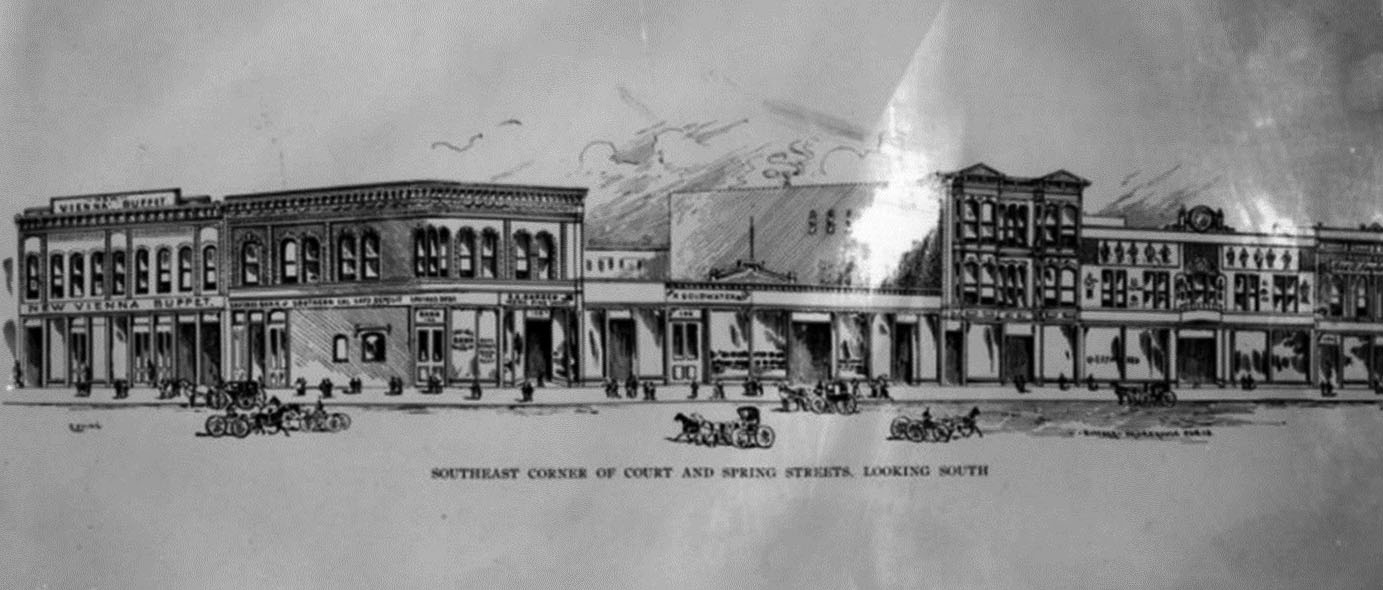 |
|
| (1896)^ - Drawing of buildings on the southeast corner of Court and Spring Streets, looking southeast. Seen from left are the New Vienna Buffet, Savings Bank of Southern California, E.E. Barden Men's Fine Shoes, H. Goldwater & Co., George P. Taylor, Tailor, and other unidentified businesses. Horse-drawn carriages are in the street.eft. |
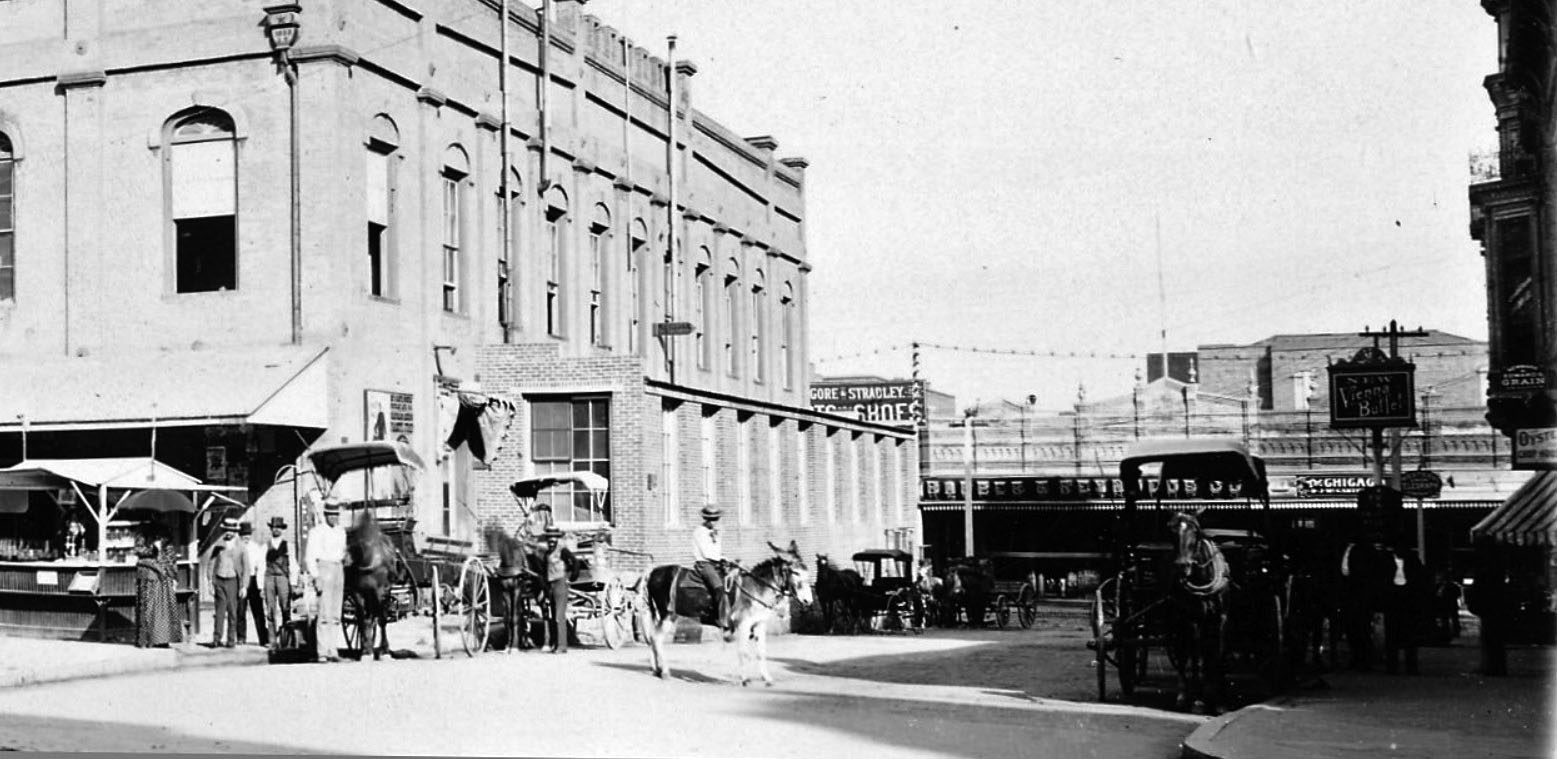 |
|
| (1891)^.^ – Street view looking east on Court Street from Spring Street. Main Street can be seen at the end of the short block. A young man is seen on a donkey in the middle of the street. The southeast corner of Court and Spring Streets is at right with horse-drawn wagon parked by curb in front. The building to the left is the old Clocktower Market/Courthouse (built in 1858). |
Historical Notes In 1899, the old Clocktower County Courthouse seen above (NE corner of Court and Spring streets) would be replaced by the Bullard Building which would later be torn down to make way for the current LA City Hall (1928). Click HERE to see 'From Temple Block to City Hall'. |
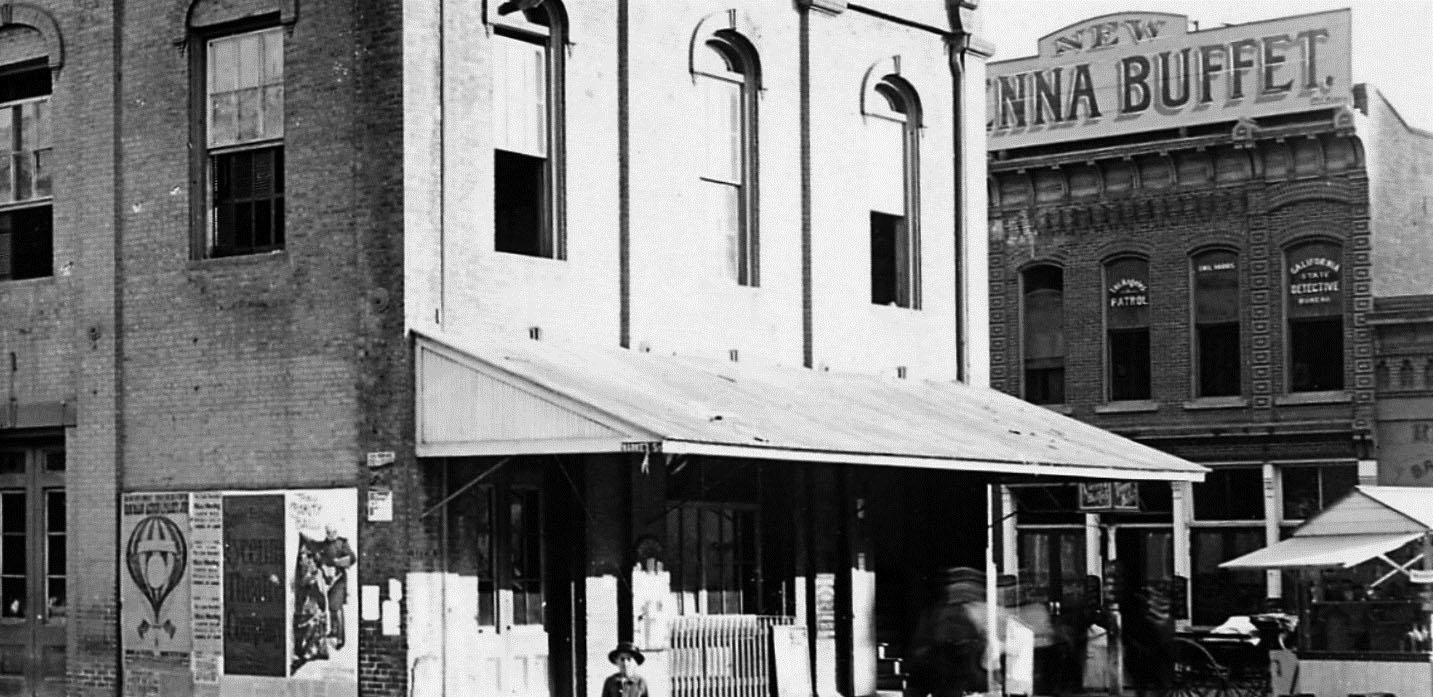 |
|
| (ca. 1891)^.^ – Detail view looking SE across the front of the old Clocktower Courthouse showing the ‘New’ Vienna Buffet on the East side of Court Street. |
Historical Notes Before it became the Vienna Buffet, the building at 114 Court Street housed the Tivoli Theater with a seating capacity of 1200. An L.A. Times ad on October 18 had this copy: "TIVOLI THEATER, 12, 14 and 16 Court Street. A Strictly Family Resort - Opening Company: Willard and Hall, Blanch and Byron, Zeno and Roberts, Hastings and Heywood, Ashby and Morris, Constantine, Newton. Admission 15, 25 and 35 cents. The Tivoli was operated by the Perry brothers (E.H. and J. H), earlier involved in a venture called the Our Club Theatre on what is now the 400 block of N. Main. It was a venue that before they got it had been called Wood's Opera House. The Tivoli didn't last long -- by December 1890 it was closed and furniture sold to pay its debts. In 1891 the building reopened as the New Vienna Buffet and gained a reputation as den of vice. In the 1894 city directory its listing says "restaurant, wines, liquors, amusement hall, F. Kerkow, prop. 10-16 Court." The Vienna was listed with the new 114-116 Court St. address in an 1895 Chamber of Commerce members list.^ |
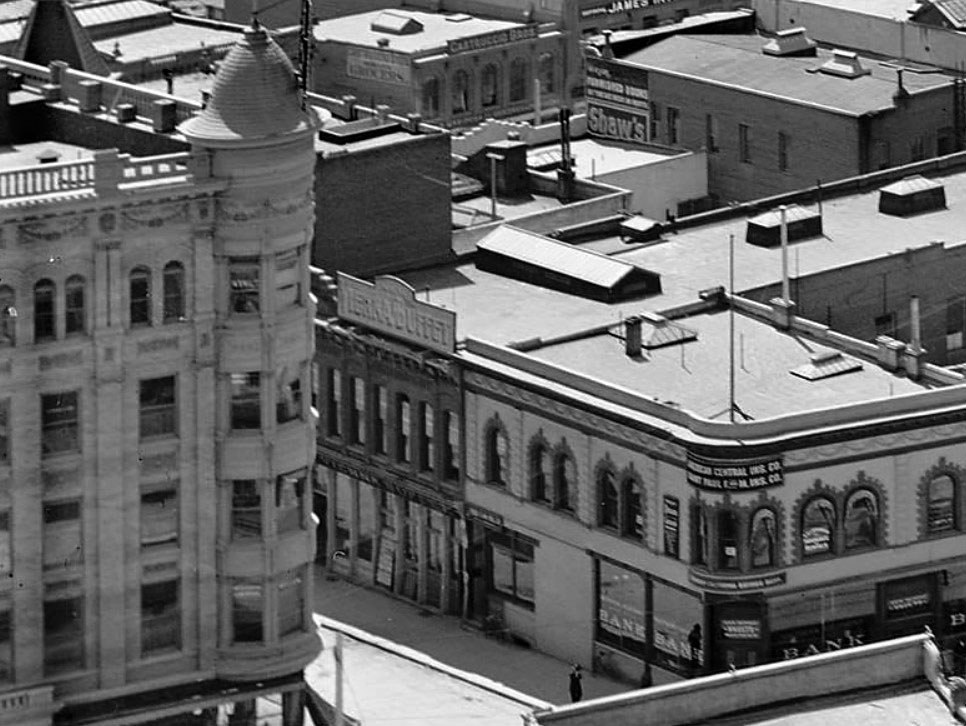 |
|
| (1899)^.^ - A detail view looking down from the LA County Courthouse showing the New Vienna Buffet on the South side of Court Street. Note the length of the building. At one time it was the location of the Tivoli Theater and later, after the Vienna Buffet closed, it became the Cineograph Theatre. The tall building on the left, NE corner of Court and Spring streets, is the Bullard Building. It replaced the old Clocktower Courthouse that had stood there since 1858. |
Historical Notes Apparently the New Vienna attracted a crowd with widely divergent interests. It even gets a mention on page 24 of the Arcadia Publishing book "Lavender Los Angeles." The May 21, 1902 Los Angeles Herald reported that scandalous things were still continuing behind the closed curtains in the private boxes at the Vienna Buffet and that the police refused to take action. They were calling for the revocation of the theatre's amusement license. The July 14, 1902 Los Angeles Herald announced the closing: "The Vienna Buffet closed last night. It will remain closed for six weeks 'for repairs and renovation.' The present proprietors, under whose management the buffet has attained such an unenviable notoriety, will retire. The place is to be conducted, when reopened, so its real owners announce, as a reputable amusement hall at popular prices. Even sinks of iniquity whitewashed and sustained by complaisant police commissions, cannot stand the white light of publicity. They flourish best in the dark —when they are left alone." The building reopened as the Cineograph Theater in September 1902 with a combination of movies and vaudeville with the movie bill changing daily.^ |
* * * * * |
Broadway (looking south from the County Courthouse)
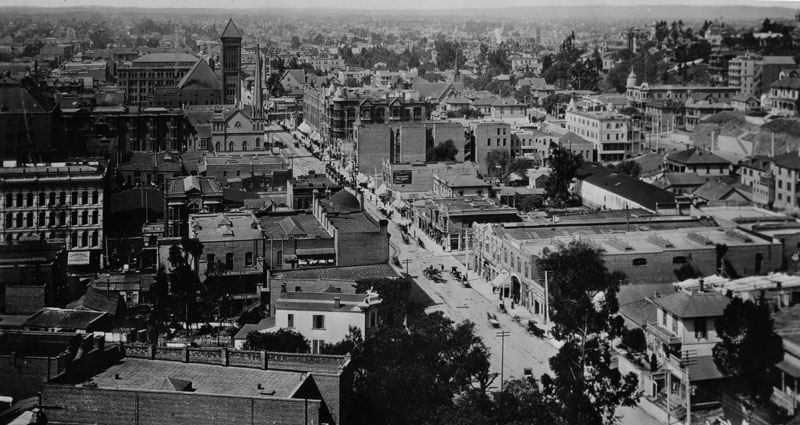 |
|
| (ca. 1889)* - View looking south on Broadway from top of the Los Angeles County Courthouse (Broadway and Temple streets). Turk Stable is seen on 1st and Broadway (center of photo), which later became the first home of the Chamber of Commerce and then the Los Angeles County Law Library. On the NE corner of the same intersection can be seen the dome of the LA Times Building (2nd location). City Hall (1888-1928; 226 S. Broadway) can also be seen in the upper-left. |
Historical Notes Broadway was known as 'Fort Street' until 1890. Click HERE to see more Early Views of Broadway and 1st Street (1886-1888). |
* * * * * |
Second Street Cable Railway (Into Obsolescence)
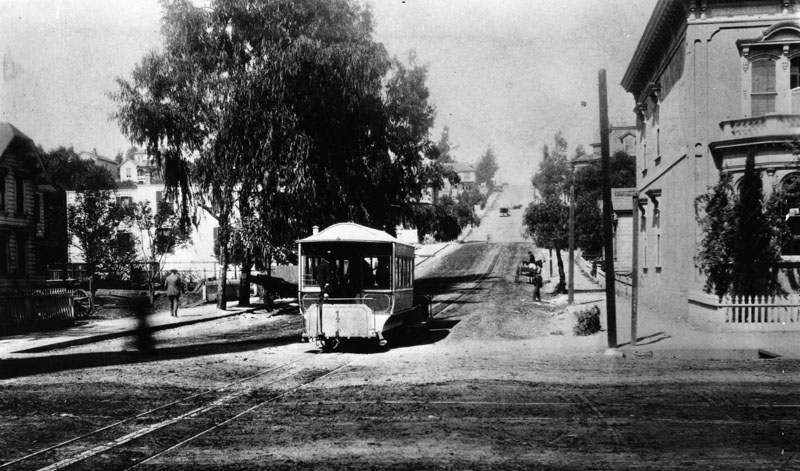 |
|
| (1889)^ - View looking west on 2nd Street at Broadway. A cable car of the Second Street Cable Railway is seen heading towards the top of Bunker Hill. This was the last year of operations for the short-lived railway. Click HERE to see more. |
Historical Notes The Second Street Cable was the earliest access line over Bunker Hill. In operation from 1885 to 1889, it ran from Spring Street to its western terminus at Belmont Avenue on Crown Hill. Andrew Hallidie constructed the line. He was the builder of San Francisco’s famed cable line.^^ In 1893, Andrew Hallidie would also engineer the Mt. Lowe Great Incline in the neighboring city of Altadena. It was a cable mechanism that raised and lowered funiculars approximately 6,000 feet up the San Gabriel Mountains.*^ Click HERE to see more Early Views of the Second Street Cable Railway. |
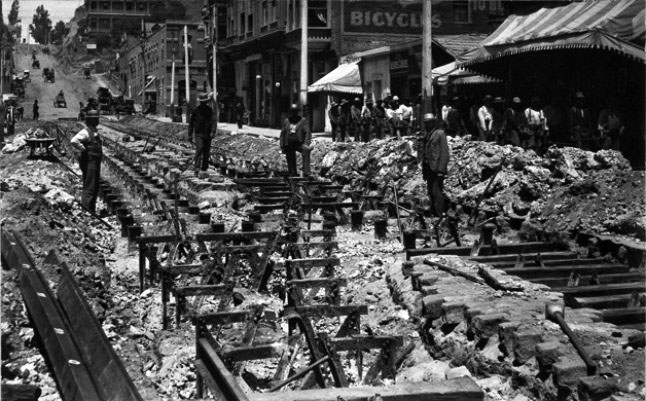 |
|
| (ca. 1890)^.^ - Workers dig up abandoned cable car tracks on Second Street. |
Historical Notes Cable cars soon became obsolete after engineers perfected an newer streetcar technology: the electric railway. Whereas cable railways constantly ran their engines at full power—regardless of how many cars were active on the line—to pull the heavy steel cables, the newer railways delivered electricity directly to motors located on the streetcars themselves. Cables lasted only a few years before needing replacement and were costly to bury; overhead catenary wires were inexpensive by comparison. By 1896, much of the city's cable car trackage had been converted to electricity and incorporated into a growing electric railway network. In 1902, a mere 16 years after the city hailed its first cable railway as a technological wonder, the last of L.A.'s cable cars rolled down Temple Street and into obscurity.* |
Then and Now
 |
|
| (1889 vs. 2022) – Looking west on 2nd Street at Broadway. At top a cable car of the Second Street Cable Railway is seen heading towards the top of Bunker Hill. At bottom the 2nd Street Tunnel (1924) can be seen, which today helps us get through what’s left of Bunker Hill. Photo comparison by Jack Feldman. |
* * * * * |
Burbank
 |
|
| (ca. 1887)^^ - View of Olive Avenue looking southeast, showing Burbank in the distance. An unpaved road fills most of the frame, showing a horse-drawn trolley-car track at its center that was discontinued after roughly one year. In the distance, a horse-drawn carriage navigates the road, flanked to either side by diffuse farm homesteads. A windmill tower and the spires of a church can be seen to the left of the street. Mountains are visible along the horizon. |
Historical Notes At the time the American Civil War broke out Dr. David Burbank established his profession as a dentist in Pueblo de Los Angeles. In 1867, he purchased Rancho La Providencia from David W. Alexander and Francis Mellus, and he purchased the western portion of the Rancho San Rafael (4,603 acres) from Jonathan R. Scott. Dr. Burbank's property reached nearly 9,200 acres at a cost of $9,000. He eventually became known as one of the largest and most successful sheep raisers in southern California, resulting in him stopping his practice of dentistry and investing heavily in real estate in Los Angeles.*^ |
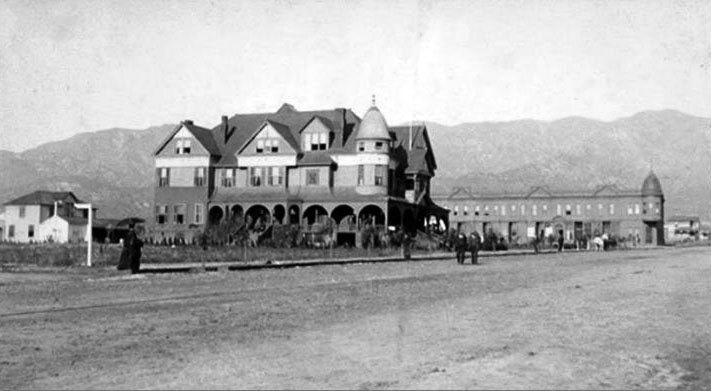 |
|
| (1887)* - View of the Burbank Villa Hotel on Olive Avenue. It was built by Dr. David Burbank and his son-in-law John W. Griffin. In the distance can be seen Burbank Block. |
Historical Notes The Burbank Villa Hotel was replaced by the Downtown Burbank Station (Bob Hope) Post Office in the 1920's. |
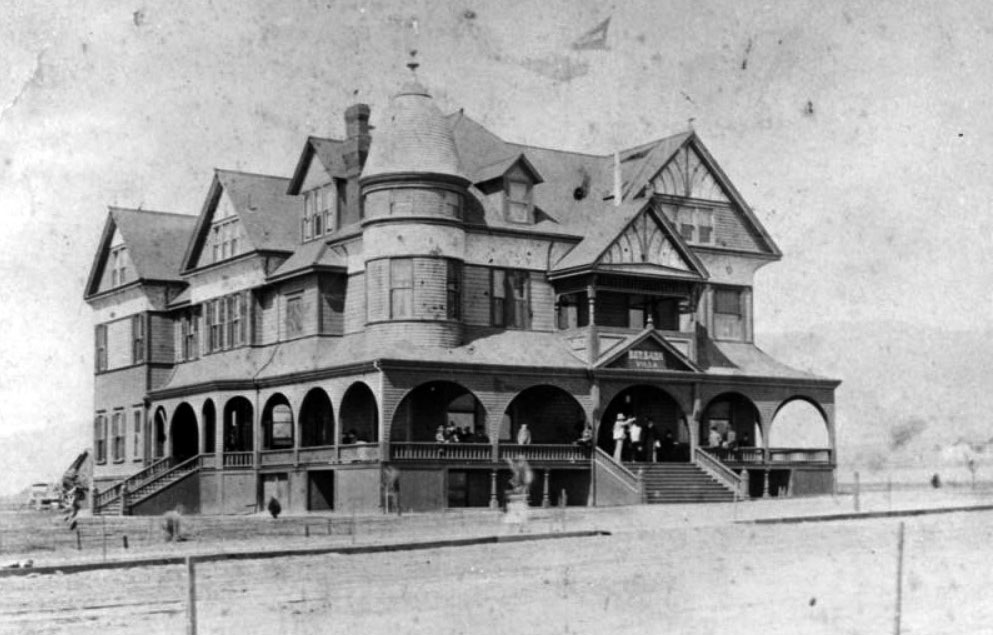 |
|
| (1887)^ – View looking across an unpaved Olive Avenue showing the Burbank Villa Hotel with several people standing on the porch and stairway. |
Historical Notes The Burbank Villa Hotel (with turret, gables, and verandas with arches) was built by Dr. Burbank and his son-in-law John W. Griffin in 1887 at a cost of $30,000.00. Later the hotel was renamed the Santa Rosa Hotel and was a popular place for weddings and parties. During the 1920s the hotel was remodeled into apartments and by 1927 it had been torn down and replaced by the post office. Today, this post office is known as the Burbank Downtown Station and is located at 135 E. Olive Ave, Burbank. |
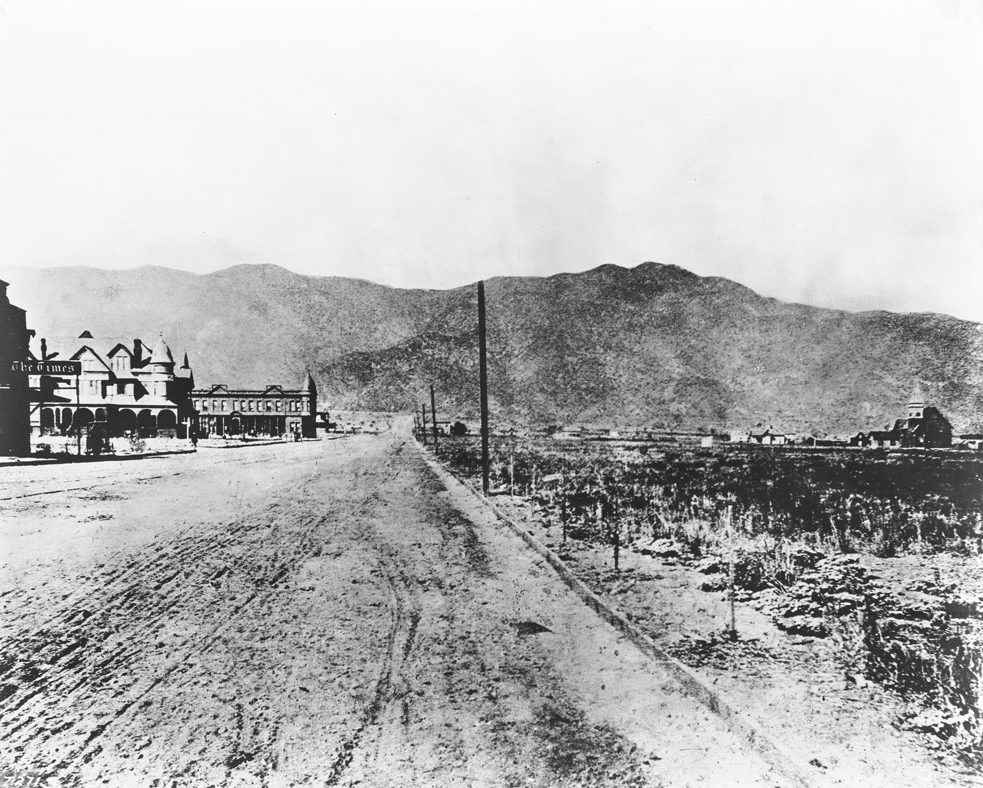 |
|
| (1889)^ - View of Olive Avenue looking north shortly after the founding of Burbank. On the left side a part of the Burbank Times can be seen. Right next to it is the old boomtime hotel, the Burbank Villa Hotel followed by the Burbank Block, erected in 1889. |
Historical Notes When the area that became Burbank was settled in the 1870s and 1880s, the streets were aligned along what is now Olive Avenue, the road to the Cahuenga Pass and downtown Los Angeles. These were largely the roads the Indians traveled and the early settlers took their produce down to Los Angeles to sell and to buy supplies along these routes.*^ |
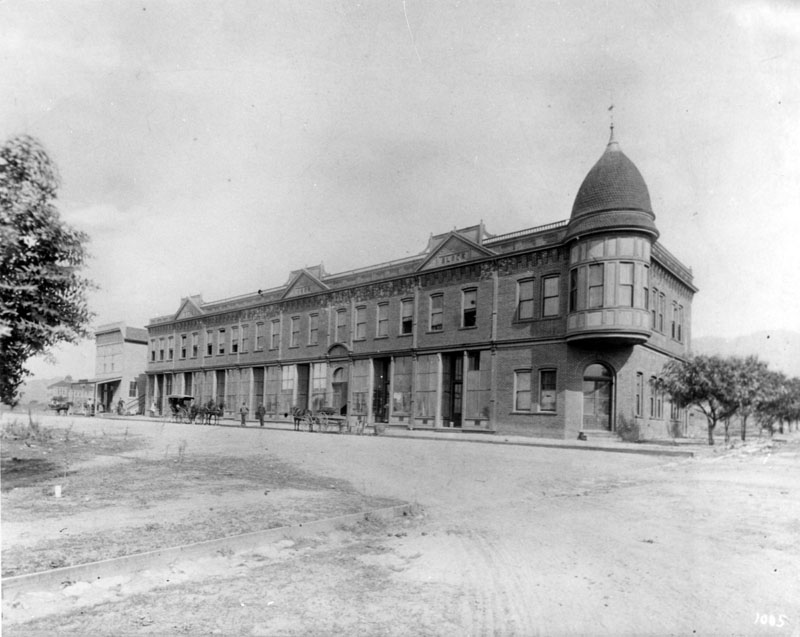 |
|
| (1895)^ - View showing the Burbank Block (Brick Block), the first brick building in town located at San Fernando Road and Olive Avenue (now Golden Mall). Horse-drawn carriages are parked alongside of the building. |
Historical Notes A shrewd businessman, foreseeing the value of rail transport, Burbank sold Southern Pacific Railroad a right-of-way through the property for one dollar. The first train passed through Burbank on April 5, 1874. A boom created by a rate war between the Santa Fe and Southern Pacific brought people streaming into California shortly thereafter, and a group of speculators purchased much of Dr. Burbank's land holdings in 1886 for $250,000.*^ |
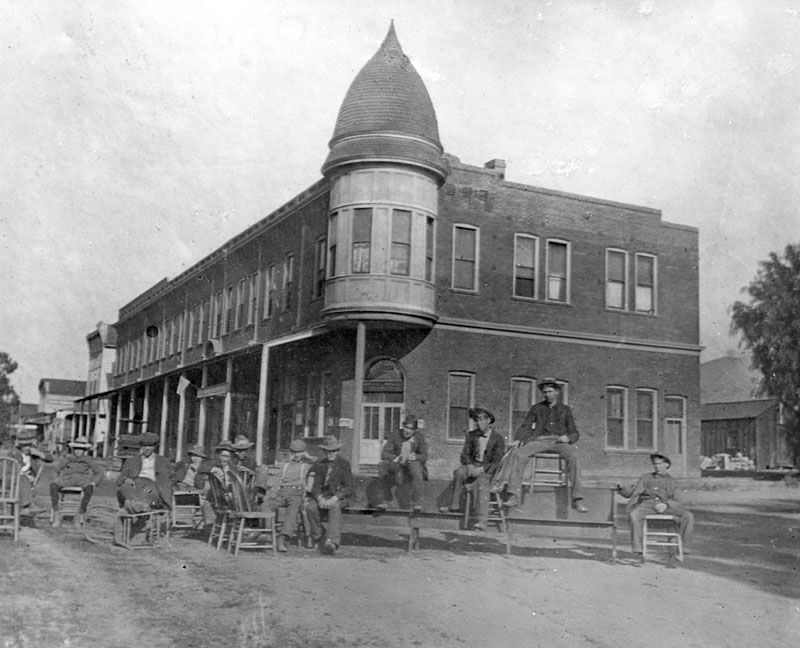 |
|
| (1889)^ - View showing a group of men sitting on chairs and benches in front of the Burbank Block. The Brick Block was erected during 1887 by the Provedencia Land & Water Co. for the newly planted town of Burbank. |
Historical Notes The group of speculators who bought the acreage from Dr. Burbank formed the Providencia Land, Water, and Development Company and began developing the land, calling the new town "Burbank" after its founder, and began offering farm lots on May 1, 1887.*^ |
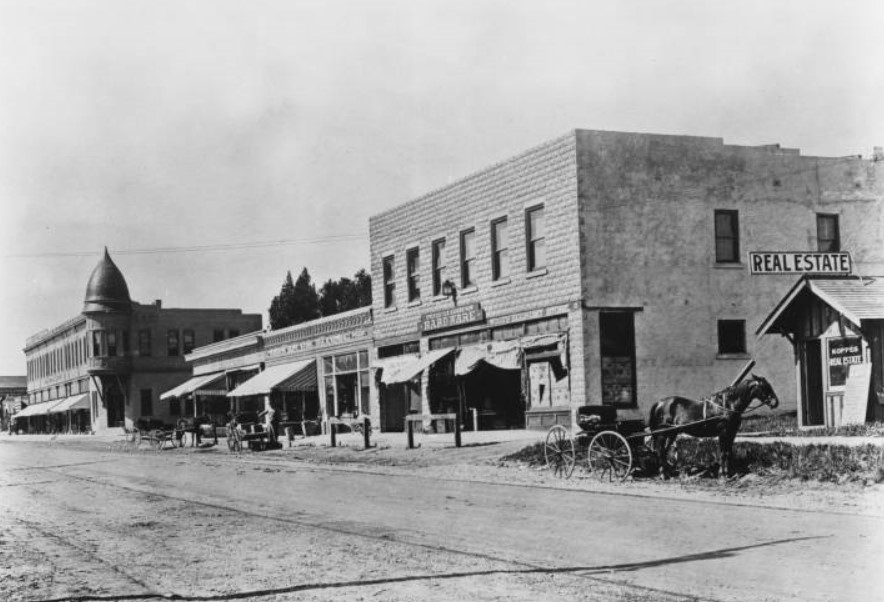 |
|
| (ca.1905)^^ - Photograph of a view of San Fernando Road in Burbank. A riderless horse-drawn carriage is parked outside a the small Knoppes Real Estate building to the far right. Farther left, a two-story brick building for Sylvester Goodenow Hardware and Wood's Economy Store stands, beyond which a one-story shop front for the Burbank Department Store can be seen, along with a two-story building which features a connected spired tower (the Burbank Block). Sign on the department store reads: "A. O. Kendall Prop.". |
Historical Notes The establishment of a water system in 1887 allowed farmers to irrigate their orchards and provided a stronger base for agricultural development. The original plot of the new townsite of Burbank extended from what is now Burbank Boulevard on the north, to Grandview Avenue in Glendale on the south, and from the top of the Verdugo Hills on the east to what is now known as Clybourn Avenue on the west.*^ |
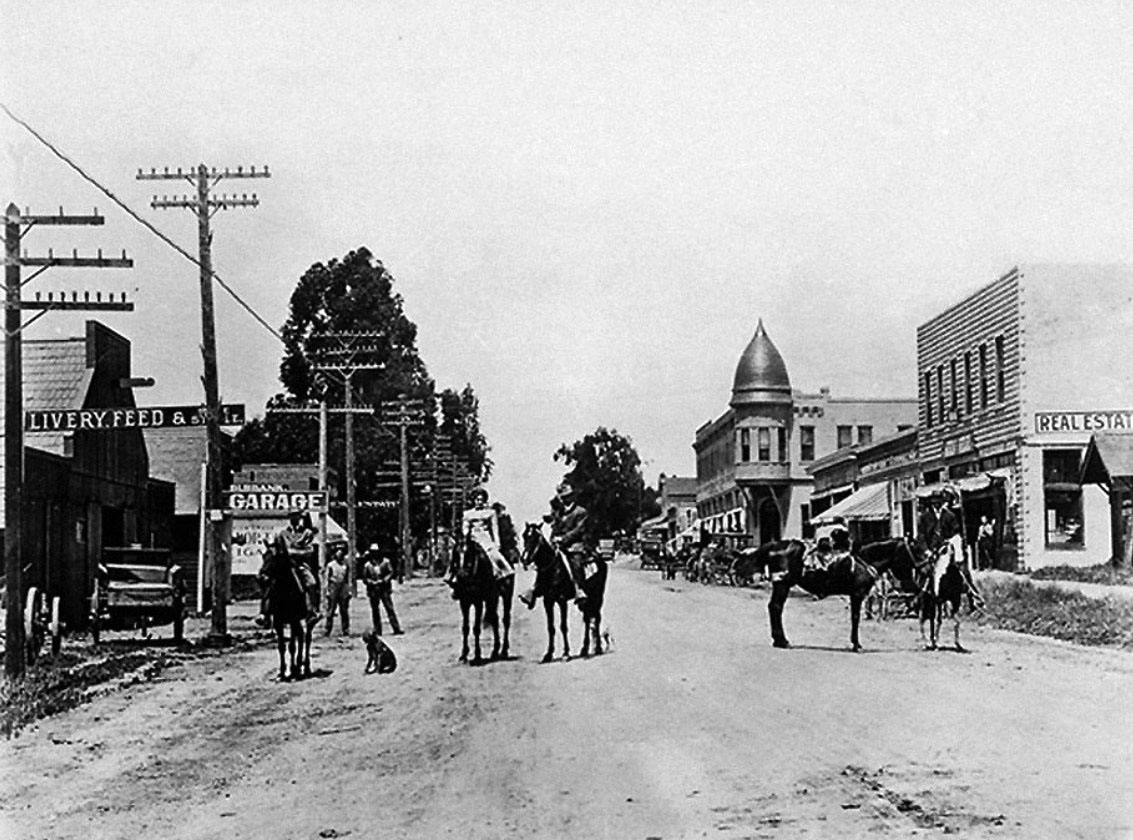 |
|
| (1910)#^** – View looking south on Olive Avenue showing several men and a woman on horseback posing for the camera. Burbank was developing from a sprawling sheep ranch to a populated city. |
Historical Notes By 1904, Burbank received international attention for having world heavyweight boxing champion James J. Jeffries become a major landowner in the town. Jeffries bought 107 acres to build a ranch on Victory Boulevard. He eventually raised cattle and sold them in Mexico and South America, becoming one of the first citizens to engage in foreign trade. He eventually built a large ranch home and barn near where Victory and Buena Vista Street now intersect. The barn was later removed and reassembled at Knott's Berry Farm in Buena Park. The citizens of Burbank had to put up a $48,000 subsidy to get the reluctant Pacific Electric Streetcar officials to agree to extend the line from Glendale to Burbank. The first Red Car rolled into Burbank on September 6, 1911, with a tremendous celebration. That was about two months after the town became a city.*^ |
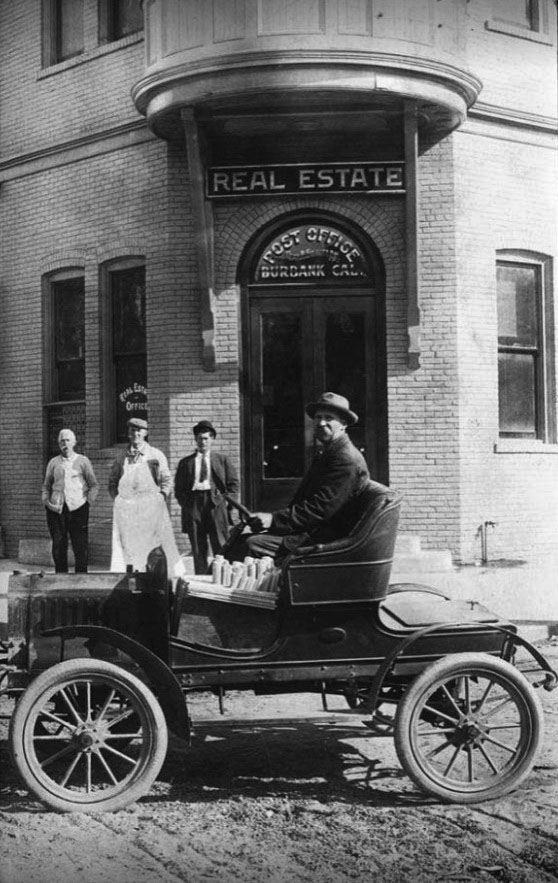 |
|
| (1911)^.^ – Four men pose for the camera in front of the Burbank Post Office located in the Brick Block Building. Sign over the doorway also reads “Real Estate”. Note the early model car has the steering wheel on the right.. |
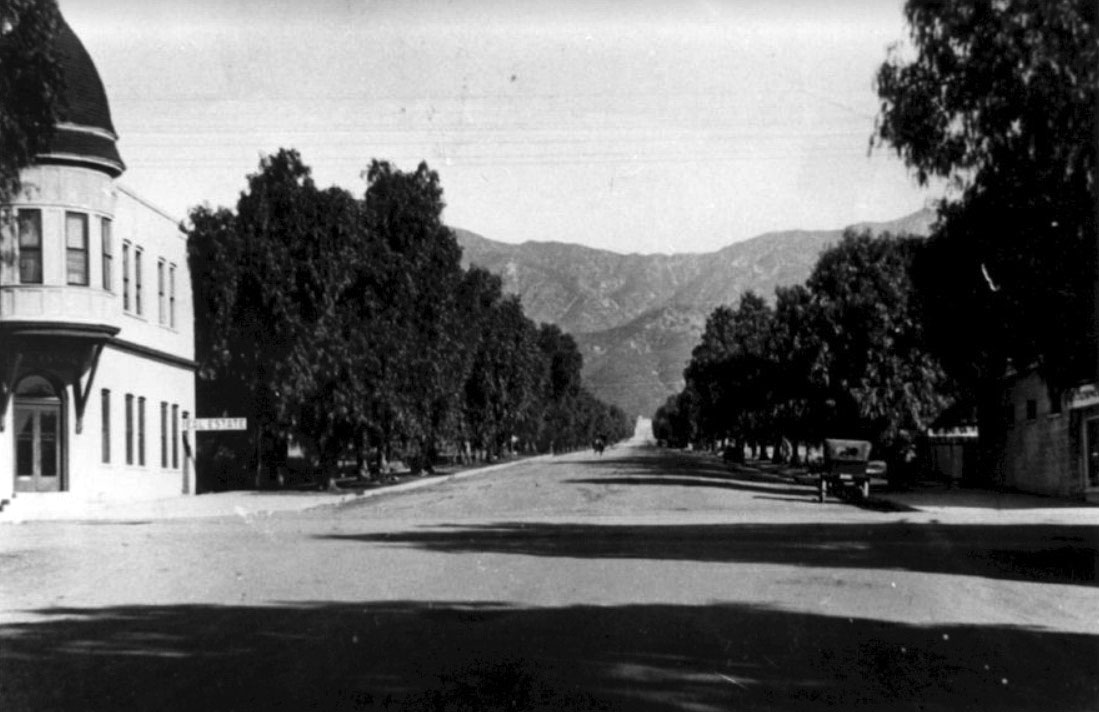 |
|
| (ca. 1915)^.^ - View looking north on Olive Avenue from San Fernando Road towards the Verdugo Mountains with the Brick Block Building seen on the left. |
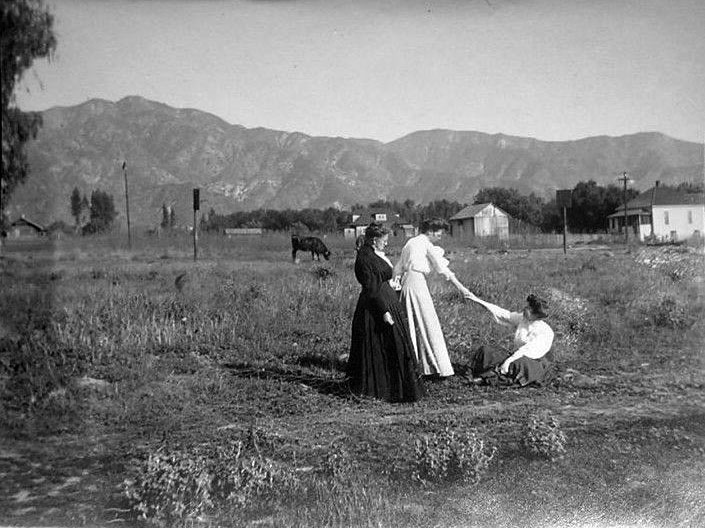 |
|
| (1909)^ – Early Burbank view showing one woman helping another one up while a third woman watches. Behind them is an empty field with cows grazing in front of what appears to be a basketball court with the Verdugo Mountains seen in the distance. |
Then and Now
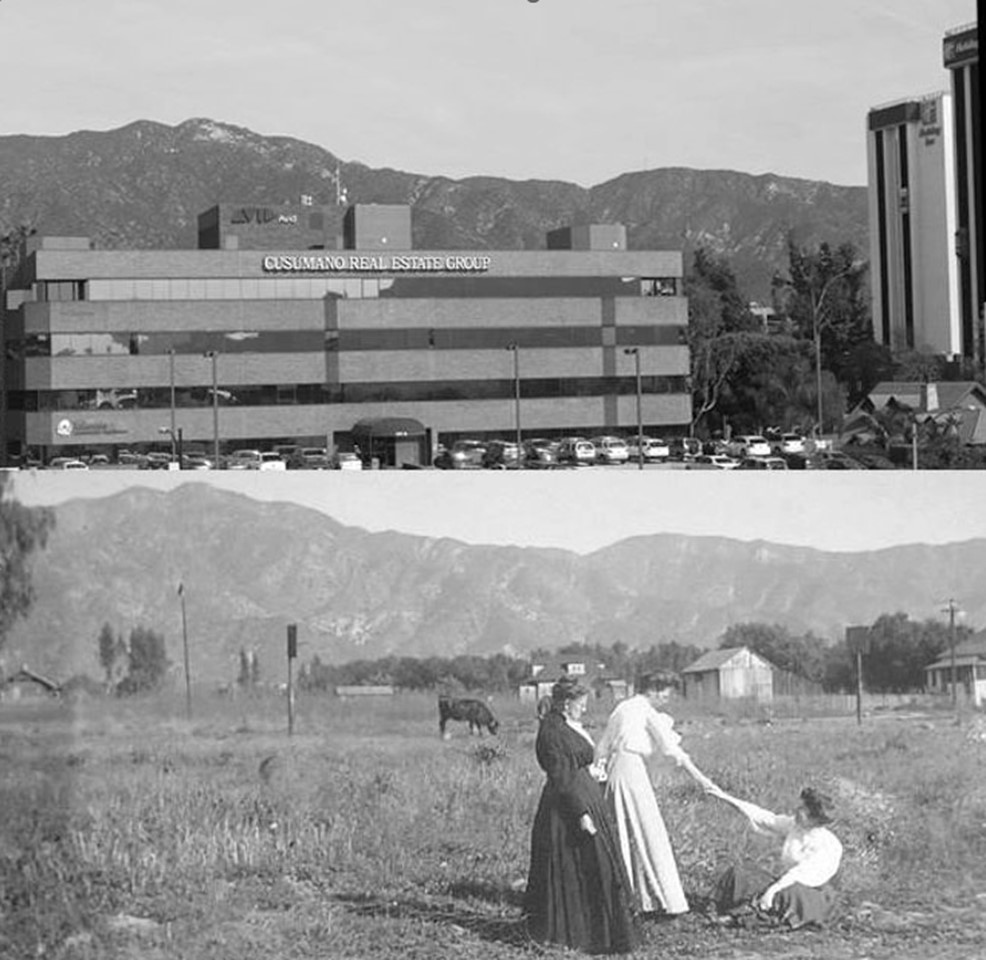 |
|
| Now and Then – Looking east toward the Verdugo Mountains from near the Olive Ave overpass of the Golden State Freeway in Burbank. Bottom photo was taken in 1909. Everything has changed except for the contour of the mountains. |
Dr. David Burbank Ranch
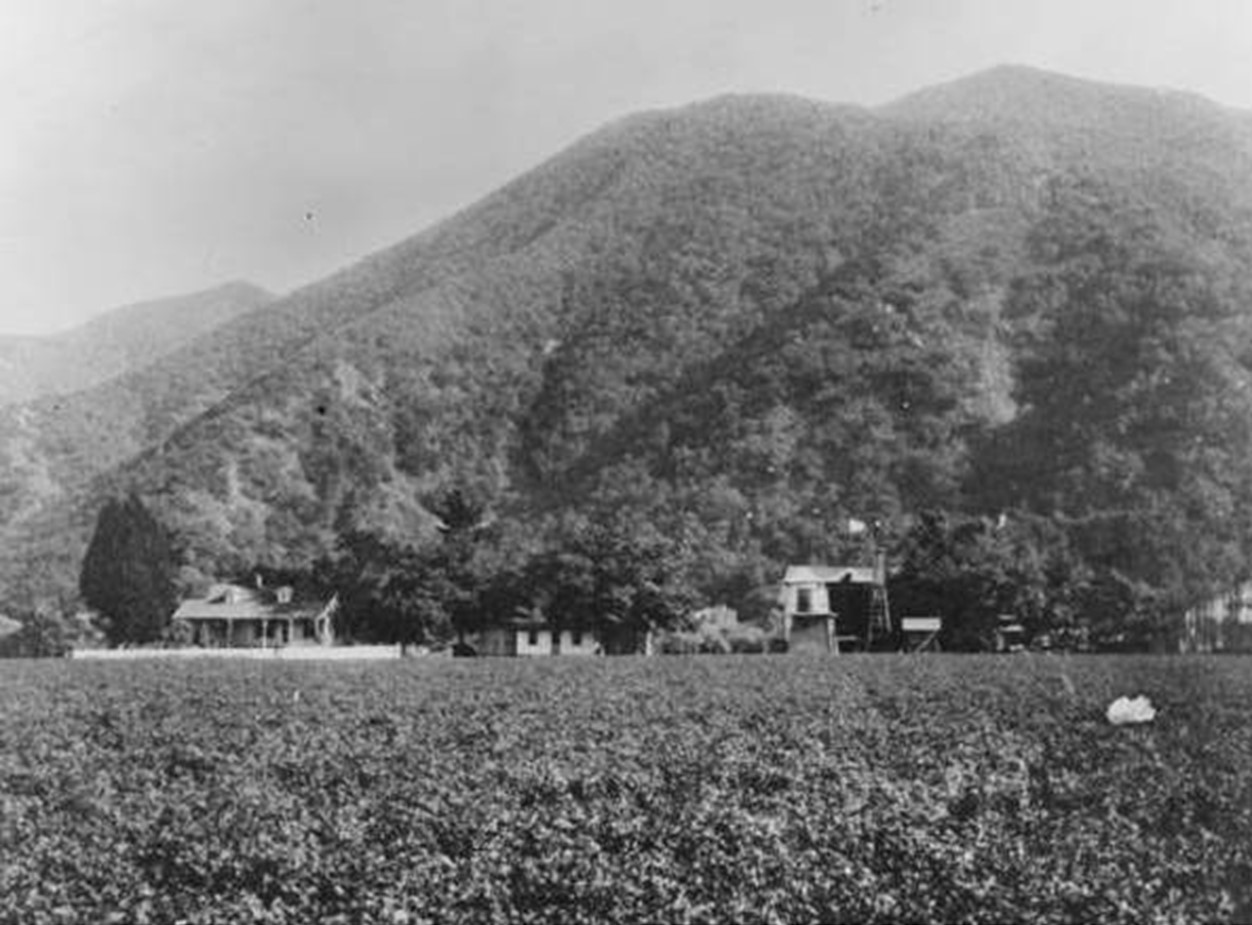 |
|
| (1910)* - Ranch house of Dr. David Burbank built in 1867 on what is now Warner Bros backlot. |
Historical Notes Dr. David Burbank was a dentist and purchased over 4,600 acres of the former Verdugo holding and another 4,600 acres of the Rancho Providencia in 1867 and built a ranch house and began to raise sheep and grow wheat on the ranch. Realizing that bringing in the railroad would increase the value of his ranch, Dr. Burbank sold the Southern Pacific Railroad a stretch of right-of-way for one dollar. The first train passed through Burbank on April 5, 1874. During the rate war between the Santa Fe and Southern Pacific railroads, low fares brought people streaming into California and Dr. Burbank once more seized the opportunity. In 1886, he sold his property to a group of land speculators for $250,000 and the Providencia Land, Water and Development Company was formed. The City of Burbank is named after him. |
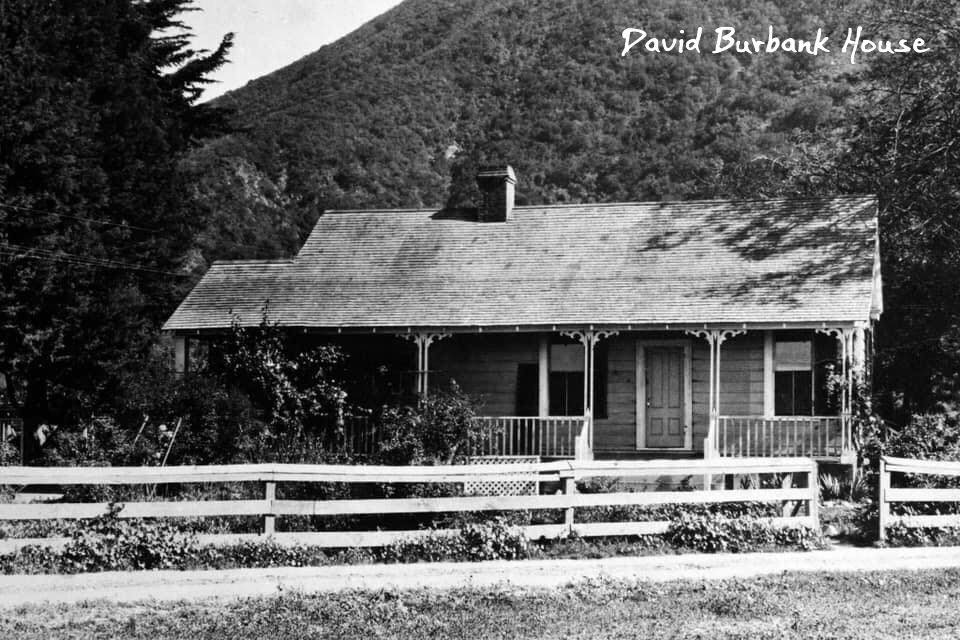 |
|
| (1870s)* - Close-up view of the David Burbank House. |
Historical Notes Dr. Burbank lived on the ranch with his wife Clara Kauffer Burbank, where they raised sheep and planted wheat. It was once located on what is now Warner Bros. Studios back lot. The house was destroyed by a fire in the 1950s. Click HERE to see more on the Warner Bros. Studios. |
* * * * * |
San Fernando Mission
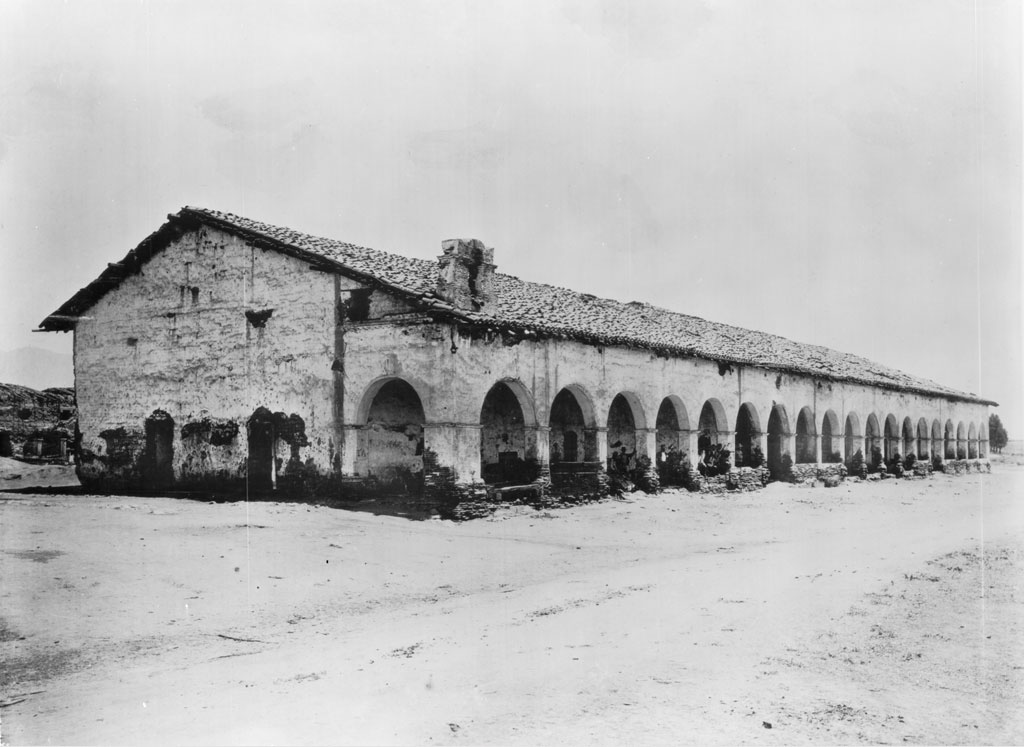 |
|
| (ca. 1890)^^ - Exterior view of Mission San Fernando Rey de Espana from the west end of the cloister. The mission cloister and building is in dilapidated condition. There are several people standing underneath the cloister peering outward. |
Historical Notes The San Fernando Mission was founded on September 8, 1797, and named for Saint Ferdinand III, King of Spain in the 1200s. |
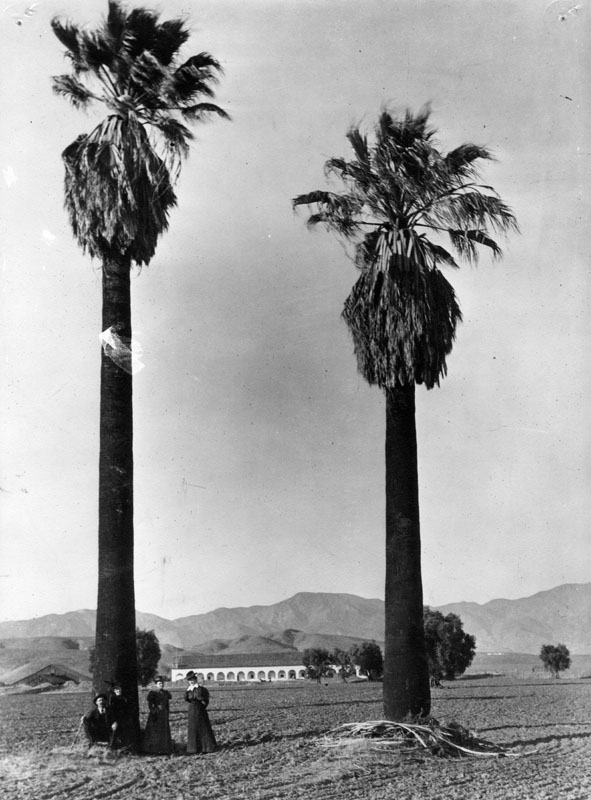 |
|
| (1890)^ - View of the Convento Building, also known as the "Long Building" and the palm and olive trees that were planted by the padres. Photograph also shows four people dressed in dark clothing, standing at the base of the left palm. |
Historical Notes The Convento Building was, and still is, the largest adobe structure in California and is also the largest original building in California's missions.^ California's eighteenth century Franciscan missionaries were the first to plant palms ornamentally, perhaps in reference to the tree's biblical associations. But it was not until Southern California's turn-of-the-twentieth-century gardening craze that the region's leisure class introduced the palm as the region's preeminent decorative plant. Providing neither shade nor marketable fruit, the palm was entirely ornamental.*#* |
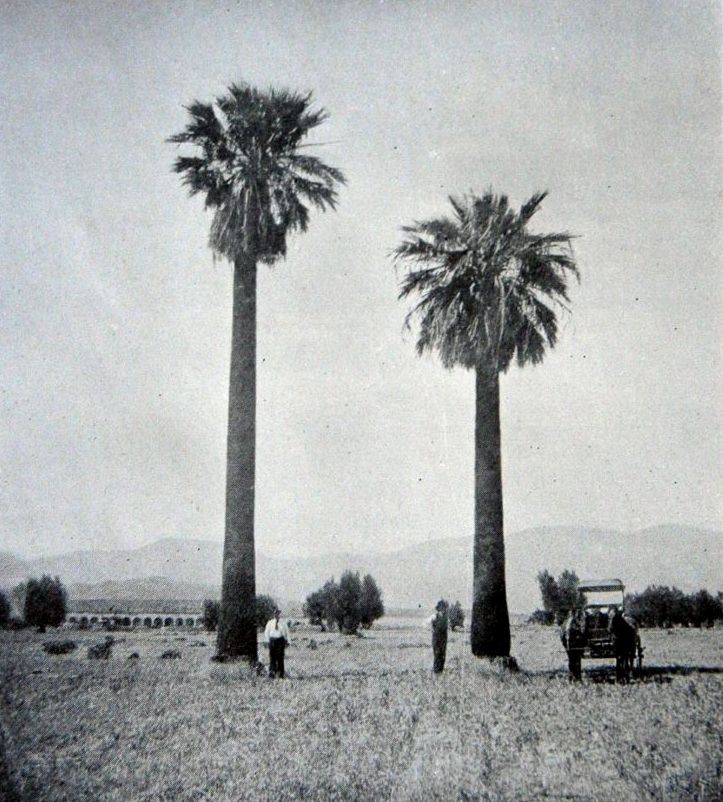 |
|
| (1896)^#^# - "The Palms of San Fernando" (title at the bottom) from the December 1896 issue of "The Land of Sunshine". This was from an article on the San Fernando Mission Ruins, the monastery of which can be seen in the background. |
Historical Notes Despite the diversity of palms in the Los Angeles area today, only one species—Washingtonia filifera, the California fan palm—is native to California. All of L.A.'s other palm species, from the slender Mexican fan palms that line so many of today's L.A. boulevards to the feather-topped Canary Island date palm, have been imported.*#* |
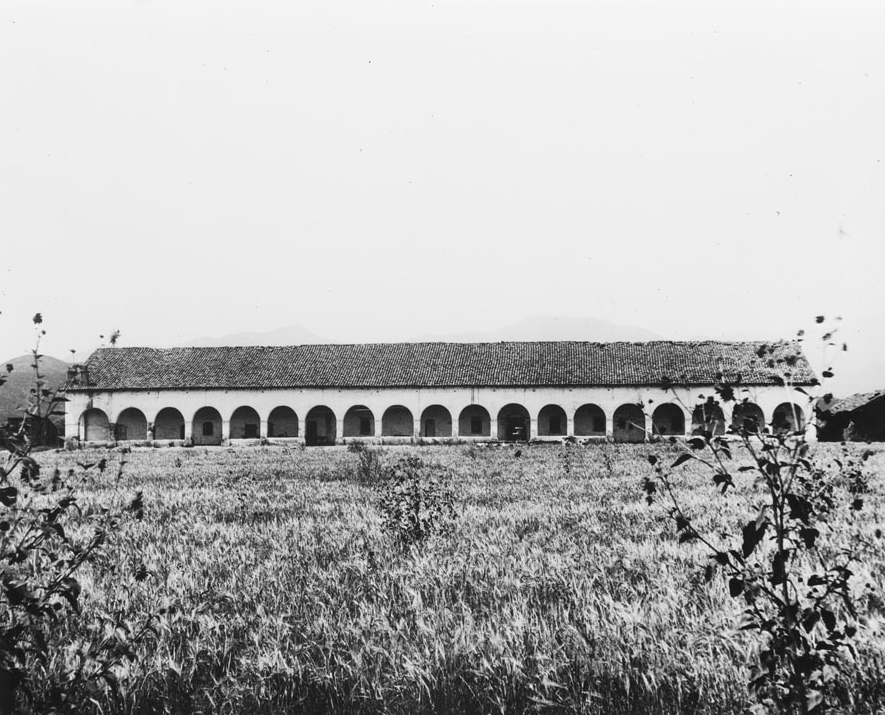 |
|
| (1898)^^ - Exterior view of the San Fernando Mission cloister. The long, one-story building of the cloister is pictured at center, showing its broad side. A colonnade is effected along the side by the situation of evenly spaced arches, which coincide with what appear to be the doors to the monks' quarters on the main building just inside the colonnade. Three tall, weed-like plants stand in the foreground in a large swath of sedgegrass. The picture file card identifies them as "Sunflowers". |
Click HERE to see more in Early Views of the San Fernando Mission |
* * * * * |
Sawtelle
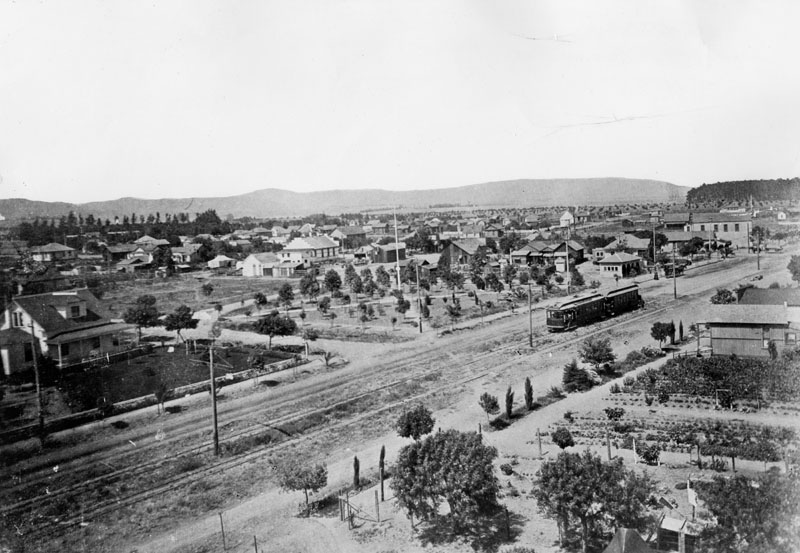 |
|
| (1890)^ - An early look at the newly developing Santa Monica Blvd. in Sawtelle (now Los Angeles), in 1890. |
Historical Notes In 1896, the Pacific Land Company purchased a 225-acre tract and hired S.H. Taft to develop a new town named Barrett, after Gen. A.W. Barrett, local manager of the veterans home situated in the area. When the Pacific Land Company attempted to secure a post office for the new town, the postal authorities objected to the name "Barrett" on account of its similarity to Bassett, California. In 1899, the name of the town was formally changed to Sawtelle (for W.E. Sawtelle who superseded Taft as manager of the Pacific Land Company). Sawtelle is where the U.S. Government established the National Soldier's Home (now Veterans Administration Hospital). Click HERE to see more. Sawtelle existed as a separate city until 1922 when Sawtelle voters decided to join Los Angeles*^ |
* * * * * |
Santa Monica
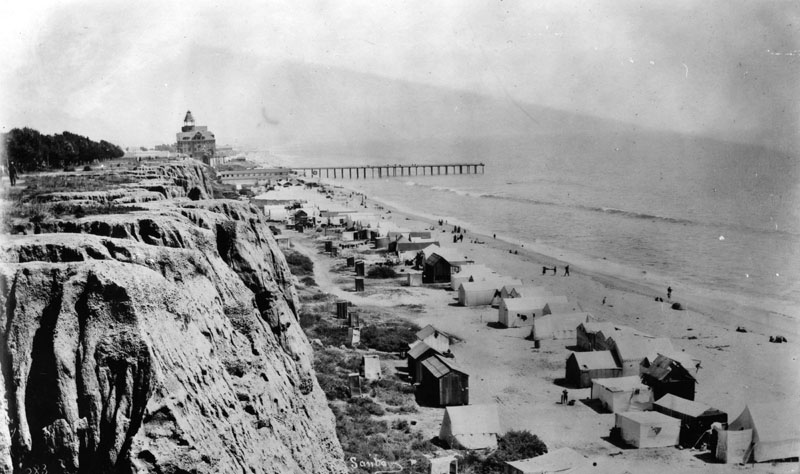 |
|
| (ca. 1887)^ - View of Santa Monica beach looking south from Santa Monica Canyon rim. The wharf and newly constructed Arcadia Hotel can be seen in the background. House-tents are seen along the beach. |
Historical Notes The Arcadia Hotel opened for business in 1887 and was located on Ocean Avenue between Railroad Avenue (later known as Colorado Avenue) and Front (later known as Pico Boulevard). The Arcadia was the largest structure in Santa Monica at the time of its construction. The 125-room hotel was owned by J.W. Scott, the proprietor of the city's first hotel, the Santa Monica Hotel. The hotel was named for Arcadia Bandini de Baker, the wife of Santa Monica cofounder Colonel R. S. Baker.^^** |
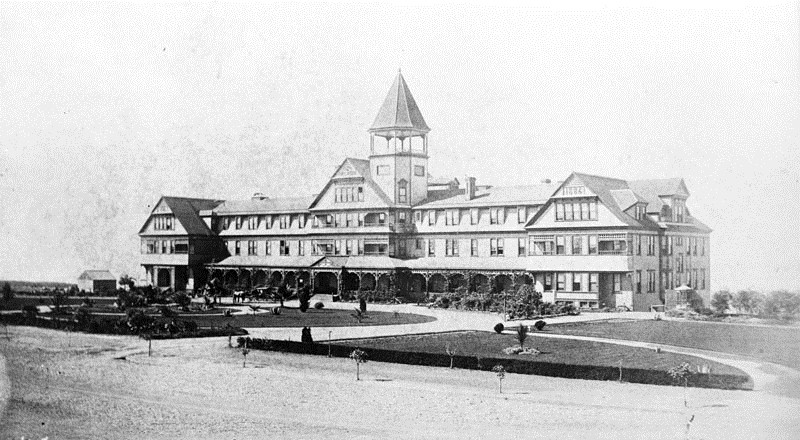 |
|
| (ca. 1887)^ - Exterior view of the east front of the Arcadia Hotel in Santa Monica soon after its construction. It opened in March 1887. It was located on Ocean Avenue immediately south of the bridge over the gulch that was later occupied by Roosevelt Highway. |
Historical Notes Being located on a bluff, all 125 rooms in the 5-story building boasted unobstructed views. It featured a grand ballroom, upscale dining room and its own roller coaster. A bathhouse was located on the beach directly below the hotel, offering guests hot saltwater baths.*#*# |
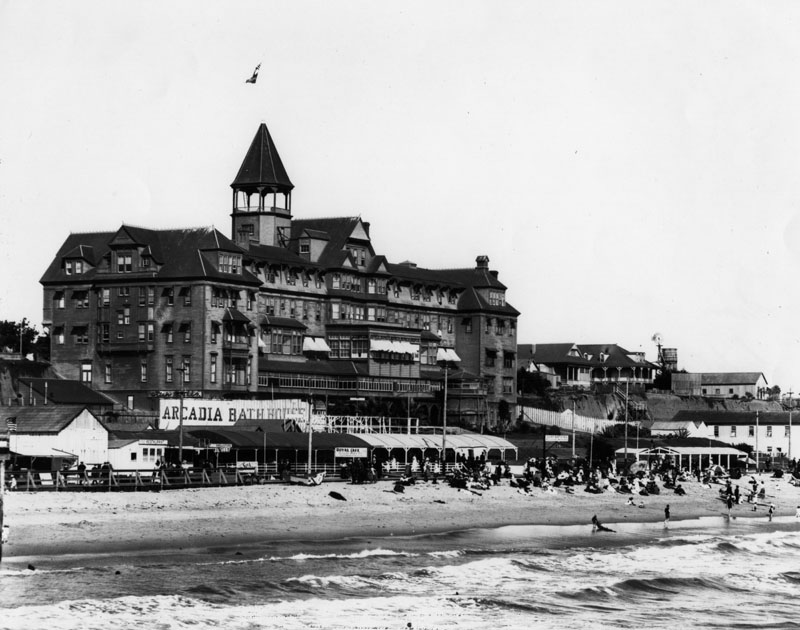 |
|
| (ca. 1890)^ - View from the pier showing the Arcadia Hotel on Santa Monica South Beach behind the Arcadia Bath House. |
Historical Notes The pinnacle of the hotel was an observation tower, offering breathtaking views in every direction a dizzying 136 feet above the beach level.*^*# |
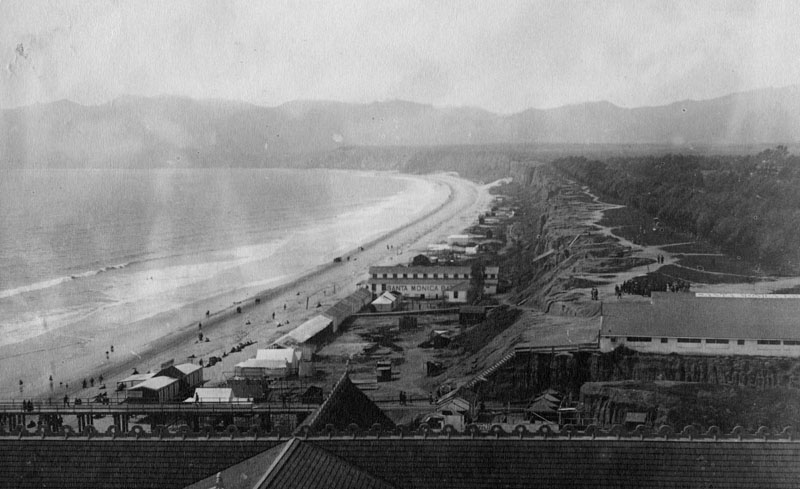 |
|
| (ca. 1891)^ - View of Santa Monica beach looking north from the observation tower of the Arcadia Hotel. Palisades Park can clearly be seen to the right. |
Historical Notes Originally known as “Linda Vista Park,” Palisades Park was the first officially-designated public open space in Santa Monica. The land was donated to the City by Santa Monica's founder, Senator John P. Jones, in 1892.*#*# |
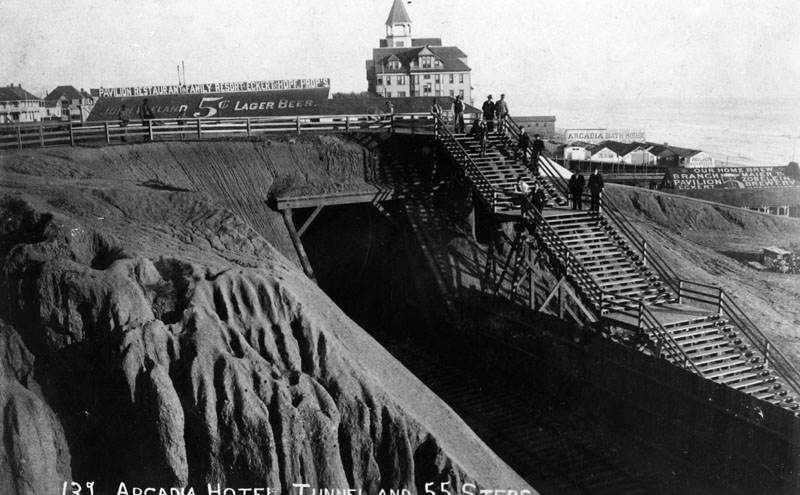 |
|
| (1890s)^ - View looking south of the Arcadia Hotel and the Arcadia Bath House. The Southern Pacific Railroad tunnel is seen at center. At right are the '55 Steps' that enabled visitors to have quick access to the beach below. Sign over the tunnel reads ".... 5 CENT LAGER BEER" |
Historical Notes In the 1890s, the Southern Pacific Railroad built a tunnel under Ocean Avenue. The tunnel was eventually enlarged to accommodate the Pacific Coast Highway.*#*# |
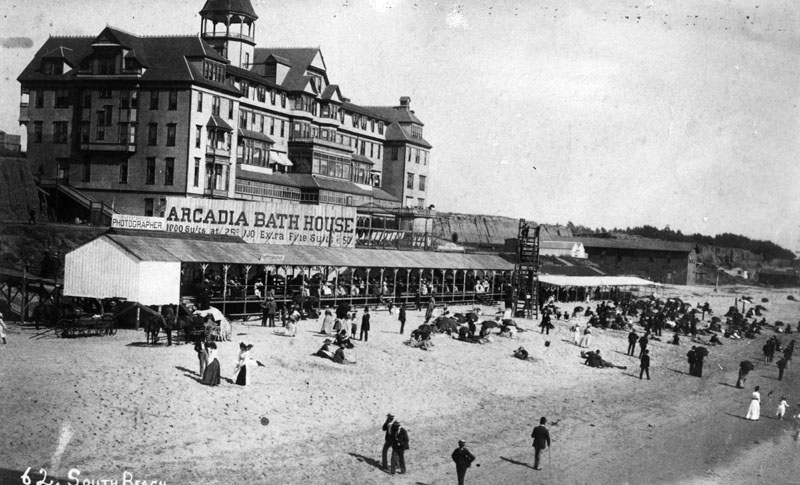 |
|
| (1890)^ - Arcadia Hotel on Santa Monica south beach behind the Arcadia Bath House. |
Historical Notes Bath houses, featuring hot saltwater baths, were a big tourist draw to Santa Monica in the late 1800s and early 1900s.^ |
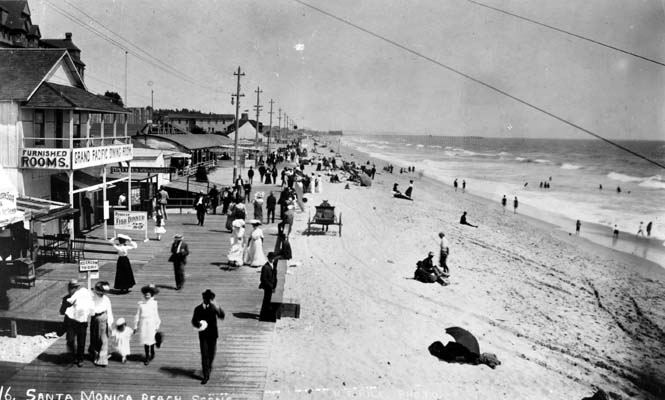 |
|
| (1890)^ - View showing people walking on the Santa Monica Beach boardwalk. A horse-drawn carriage (center of photo) appears to be moving south on the sand parallel to he boardwalk. |
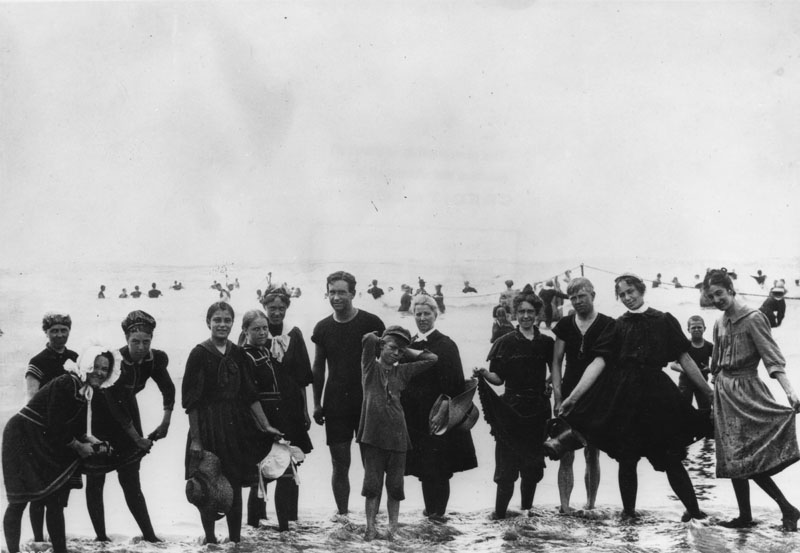 |
|
| (1890)^ - Group photo of men and women in their bathing suits, standing in ankle deep water on Santa Monica beach. |
Historical Notes Click HERE to see more in Early Views of Santa Monica |
* * * * * |
Sonora Town
 |
|
| (1888)* – Panoramic view Looking south and southeast toward Sonora Town from the heights at Yale Street above Calvary Cemetery. Photo by William Henry Jackson. |
Historical Notes The part of the city called Sonora Town was an old adobe village north of the Plaza and Church of Our Lady, Queen of the Angels. It was Los Angeles' first Mexican quarters, or barrio. The area was named for the numerous miners and families who came from Sonora, Mexico, and may have still been around in the 1930s. Now part of it is Los Angeles' Chinatown District. |
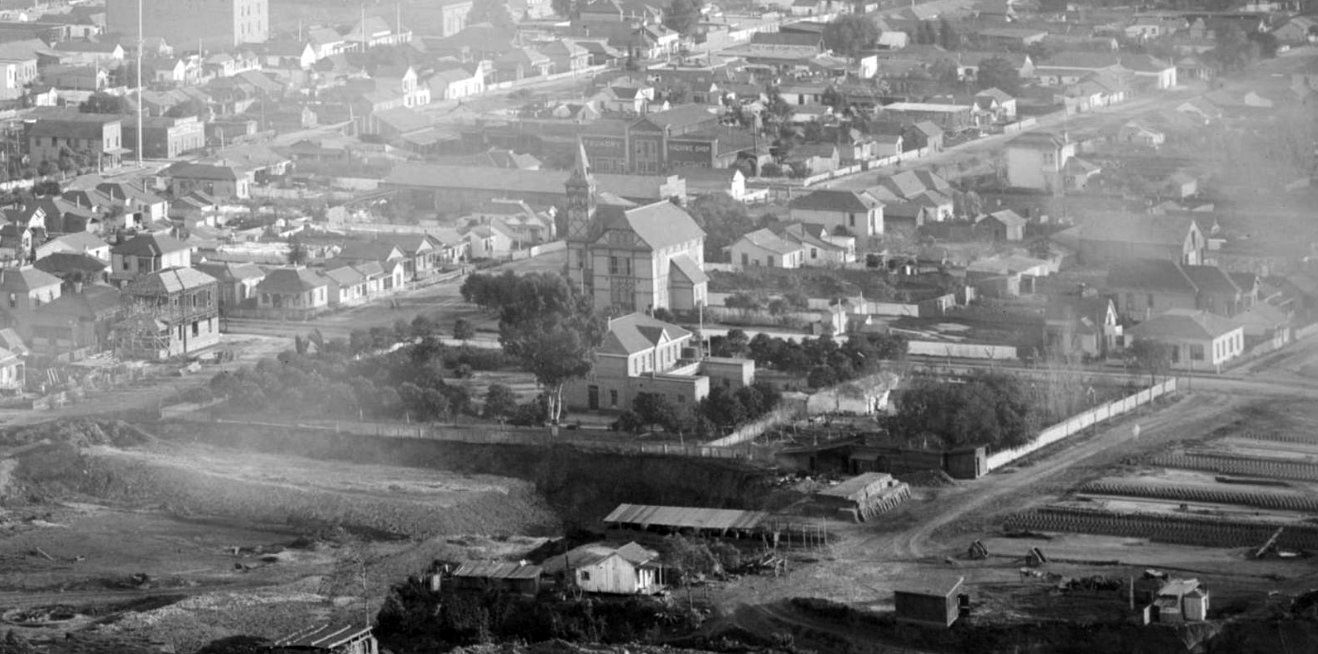 |
|
| (1888)* - View showing Castelar Street Public School and the French Hospital from Yale Street above Calvary Cemetery. Photo by William Henry Jackson |
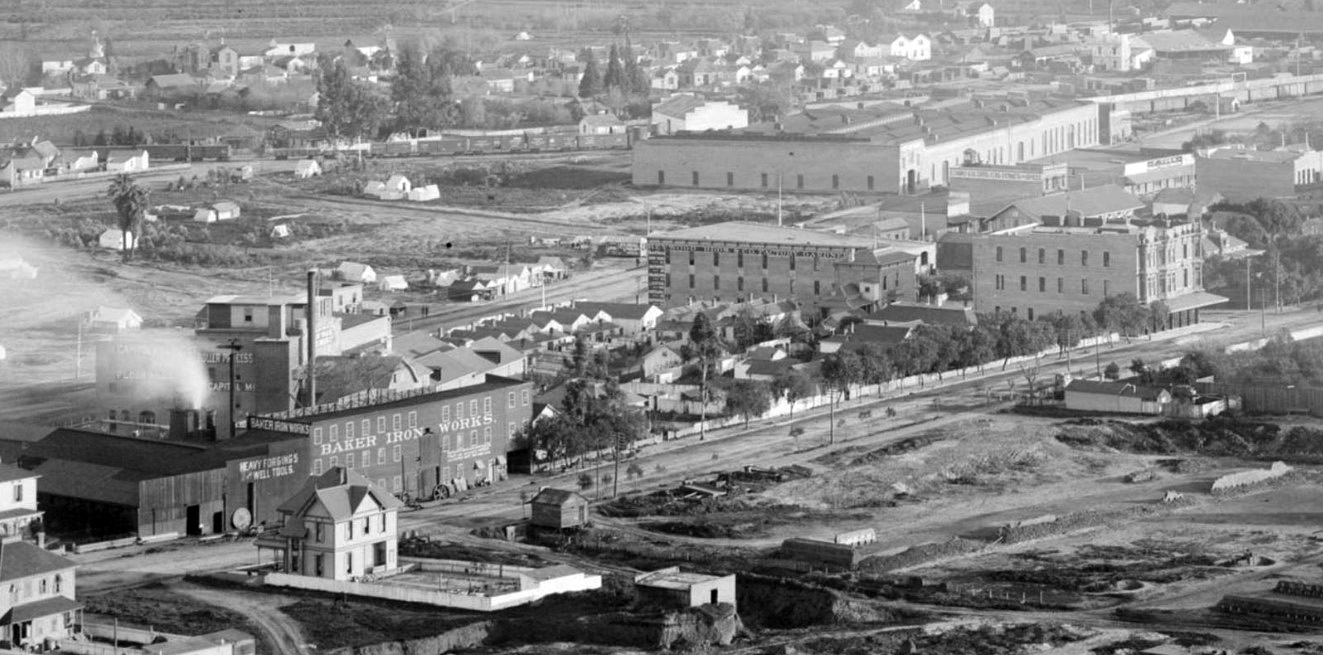 |
|
| (1888)* - View from Yale Street showing Baker Iron Works and Capitol Milling (lower-left), the San Fernando Hotel (center), and the still under construction Sunset Hotel (center-right). Photo by William Henry Jackson |
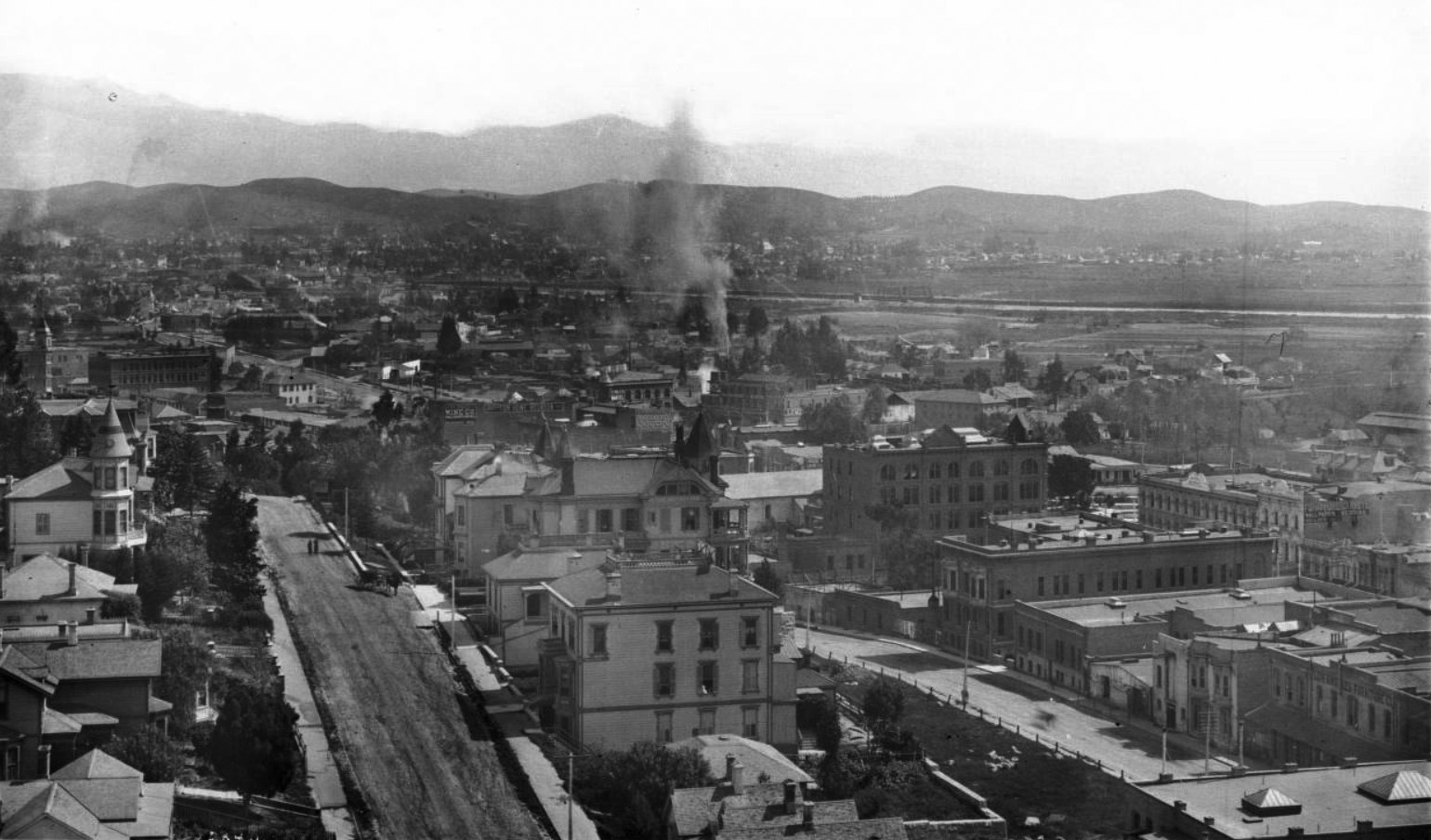 |
|
| (ca. 1889)* - Looking northeast along Buena Vista (Justicia) from the County Court House. The Los Angeles River can be seen in the background. Smoke belches from a factory at center likely one of the iron works, Llewellyn or Baker or one of the brick yards. Both the Sunset Hotel and the National Hotel can be seen at center-right. |
Historical Notes Residential buildings dominate at left, lining west side of Buena Vista (Justicia), while commercial buildings are at right. A horse-drawn carriage can be seen driving down the street at left, while A field can be seen in the right background, while mountains rise in the background beyond the field. Legible signs include: "Sunset Wine Co., wines, brandies, whiskies, Goldschmidt Bros.", "Agency for Tom Howe Bourbon, O.P.S.", "Ghirardelli's breakfast cocoa"..., "Frey's Mantel", "Lumber, building material, sash doors and blinds; Kerckhoff-Cuzner Mill & Lumber Co.", ..."Wood m[...], 610", "National Hotel", "Drugs", "Los Angeles Furniture Co.", "Hoffman Hotel", "Furniture, carpets, wallpaper, bedding, shades, etc.", and "Stearns Machine Works". Brunswig Drug Company, the Pico House, Merced Theater and the Masonic Hall can all be seen at center and center right. The squarish, three story brick building at left in the middle distance (seeming to balance on the tip of the turret of the little white house on Buena Vista) is the San Fernando Hotel at the NE corner of San Fernando (N. Spring) Street and Ord. The tower/turret to its immediate left is the corner of the Sunset Hotel on the NW of the same corner. |
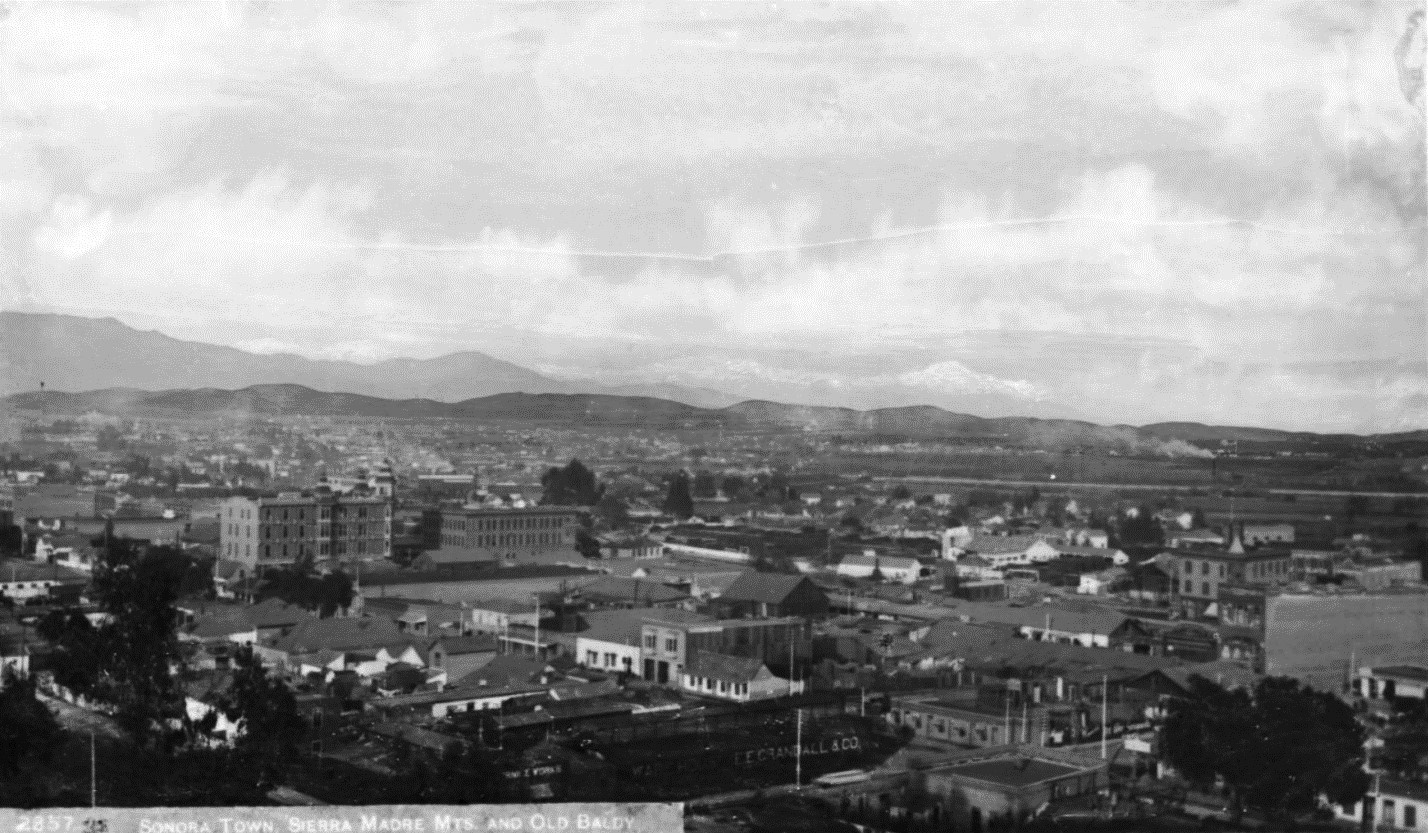 |
|
| (ca. 1890)* - Elevated view overlooking Sonora Town; shows adobe buildings in right foreground, E.E. Crandall & Co. warehouse at South Spring Street in center foreground, houses (middle center right), Sierra Madre mountains and "Old Baldy" in distance. The two multi-story buildings at center-left are the Sunset Hotel and the San Fernando Hotel. |
 |
|
| (ca. 1890)^*# - Postcard view of Sonora Town looking northeast towards the Los Angeles River. The two large buildings at center-right are the Sunset Hotel (left) and the San Fernando Hotel (right). Smoke can be seen billowing out from a factory between the hotels and the LA River. |
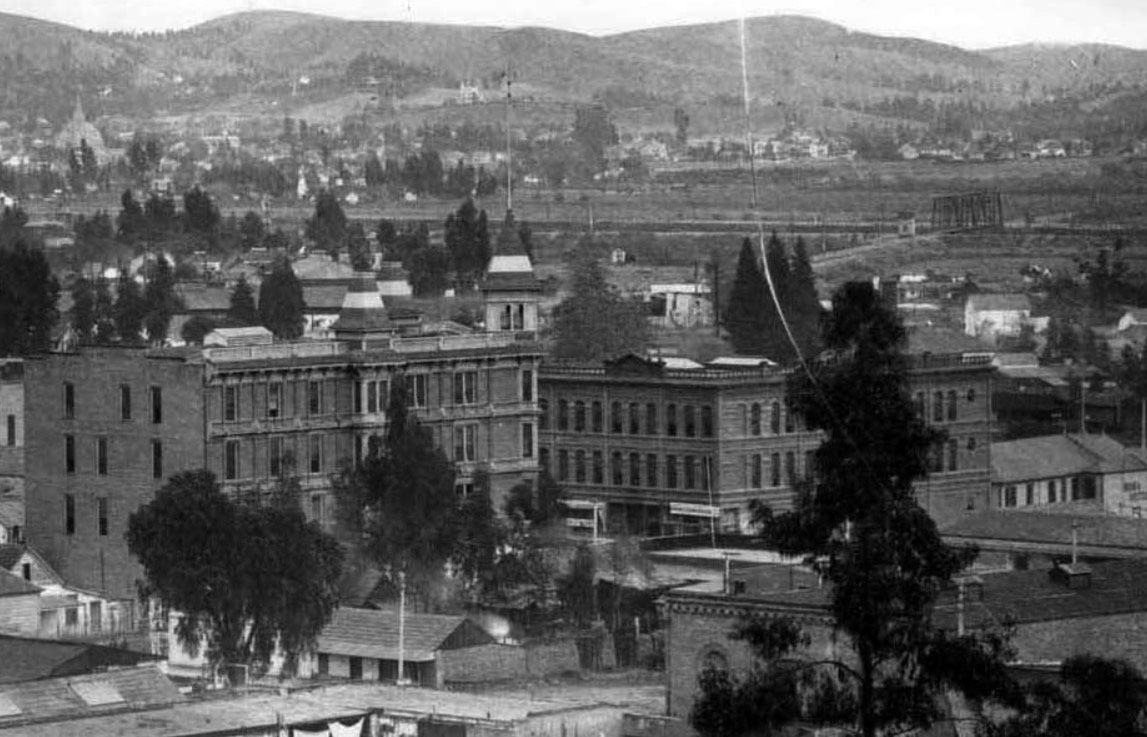 |
|
| (ca. 1900)#^* - View showing the four story Sunset Hotel (with three striped turrets) and the three story San Fernando Hotel sitting facing each other across San Fernando/Upper Main/North Spring St. (Note: San Fernando Street, hence the San Fernando Hotel). Ord Street runs alongside the hotels. |
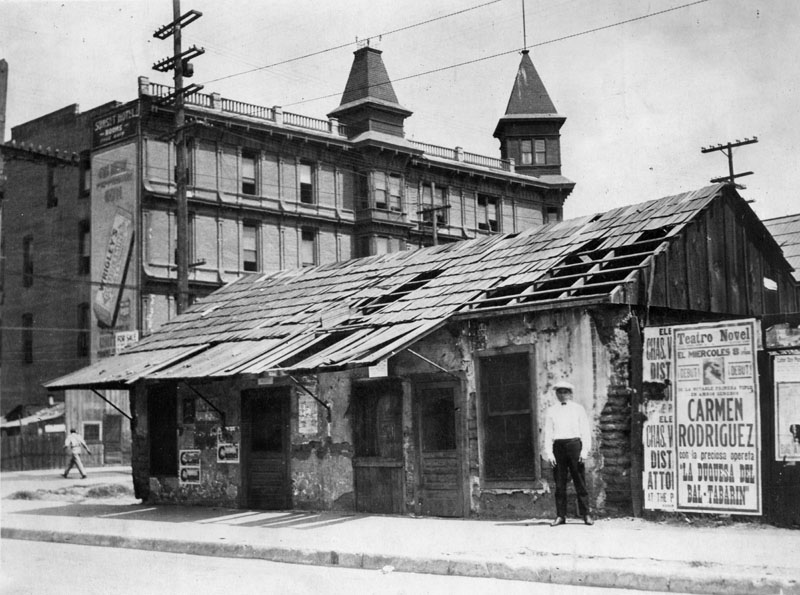 |
|
| (n.d.)^ - Exterior view of an adobe house opposite the Sunset Hotel at 703 San Fernando Street (later North Spring Street) in Sonora Town. A bill has been posted in Spanish announcing the appearance of Carmen Rodriguez in "La Duquesa Del Bal-Tabarin" at Teatro Novel. |
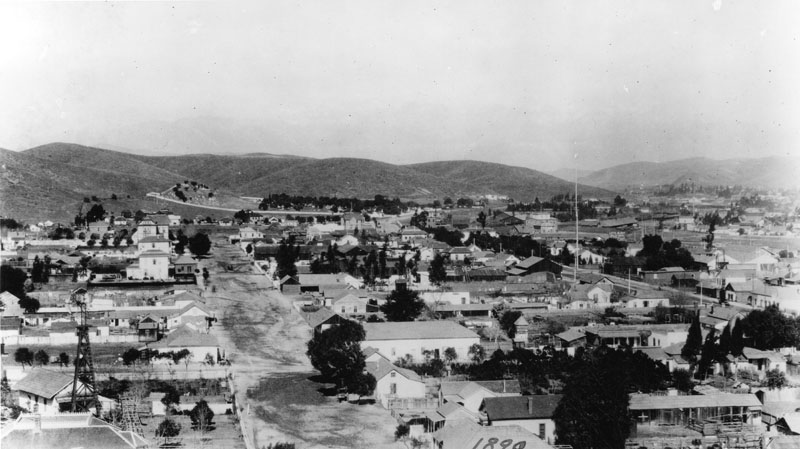 |
|
| (1890)^ - View overlooking Sonora Town and the surrounding area. |
Historical Notes The part of the city called Sonora Town was an old adobe village north of the Plaza and Church of Our Lady, Queen of the Angels. It was Los Angeles' first Mexican quarters, or barrio. The area was named for the numerous miners and families who came from Sonora, Mexico, and may have still been around in the 1930s. Now it is Los Angeles' Chinatown District. Note the tall pole on the right side of the photo. It is a 150 -foot mast that holds up one of the City's first electric street lights. These tall electric street lights first appeared in 1883 when the City's first electric utility company, LA Electric Company, was formed. Click HERE to see more in Early Los Angeles Street Lights. |
 |
|
| (1890)^ - Panoramic view of Sonora Town in 1890. A fence is painted with the sign, "Japanese Art Depot, 315 North Main Street." |
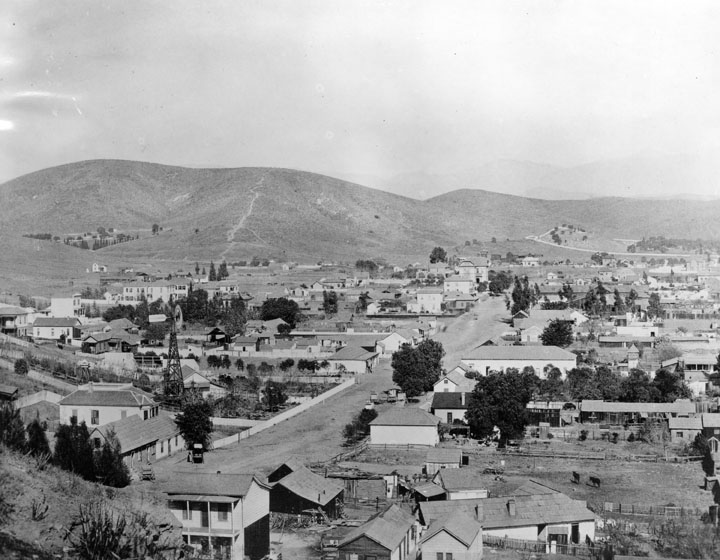 |
|
| (ca. 1890)^ - An 1890s panorama of Sonora Town. Campo Santo can be seen on the hill in the upper right. |
Historical Notes Prior to the construction of the Plaza Catholic Church, pueblo residents were buried at Mission San Gabriel. Some burials, however, took place at Campo Santo even before 1826 when the first resident priest arrived and it began its own official burial registry. The Campo Santo (consecrated ground) was the first cemetery in Los Angeles. |
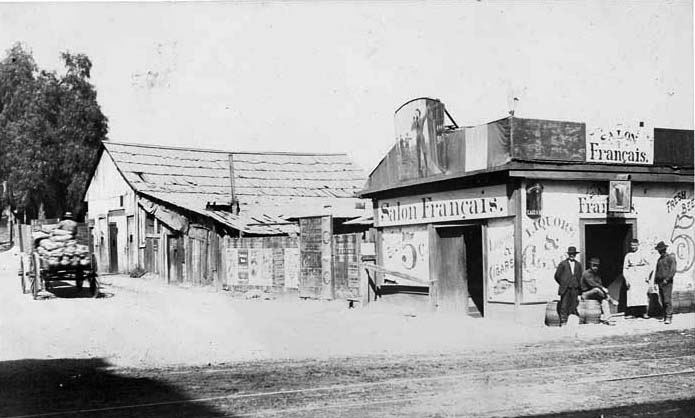 |
|
| (ca. 1880)* - View of four men in front of the Salon Francais on North Broadway Street. The signs on the face of the building read: "Fresh Beer - 5 Cents". A horse-drawn wagon is seen on the left carrying a full load of supplies. |
Historical Notes Click HERE to see more Early Views of Sonora Town |
* * * * * |
Broadway (Fort Street) and Temple
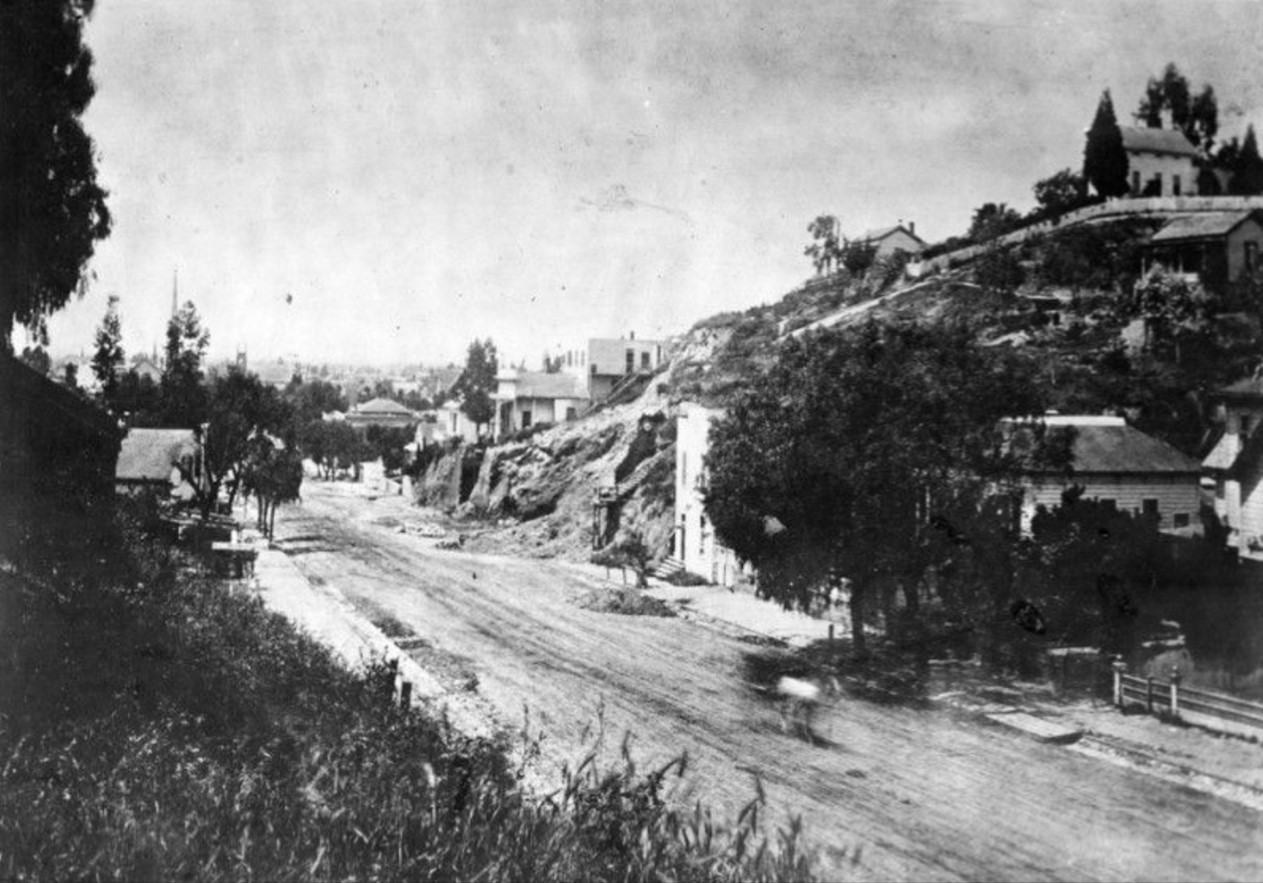 |
|
| (1871)* – View looking south down Fort St (renamed “Broadway” in 1890) between Temple (behind the camera) and 1st Street (beyond the first cut). Los Angeles High School is out of frame on the left (east) on Poundcake Hill. |
Historical Notes The steep slope which is spilling onto unpaved Fort St is the future site of the Court Flight Incline Railway. The small house on top of the hill at right is on Court St, one lot east of Hill St. (southeast corner of Court & Hill). The Bradbury Mansion will later be built at the southwest corner of Court and Hill. The name "Fort Street" was changed to "Broadway" in 1890 by order of Mayor Hazard, at the request of property owners at Fort and Fourth. The renaming of Fort Street to Broadway was influenced by two primary factors. First, pronunciation issues arose, particularly among German immigrants who found it difficult to distinguish between "Fort Street" and "Fourth Street" due to the "th" sound. Second, city officials wanted to elevate the street’s prestige by associating it with New York City's renowned Broadway, reflecting aspirations to enhance the stature of Los Angeles as it developed. |
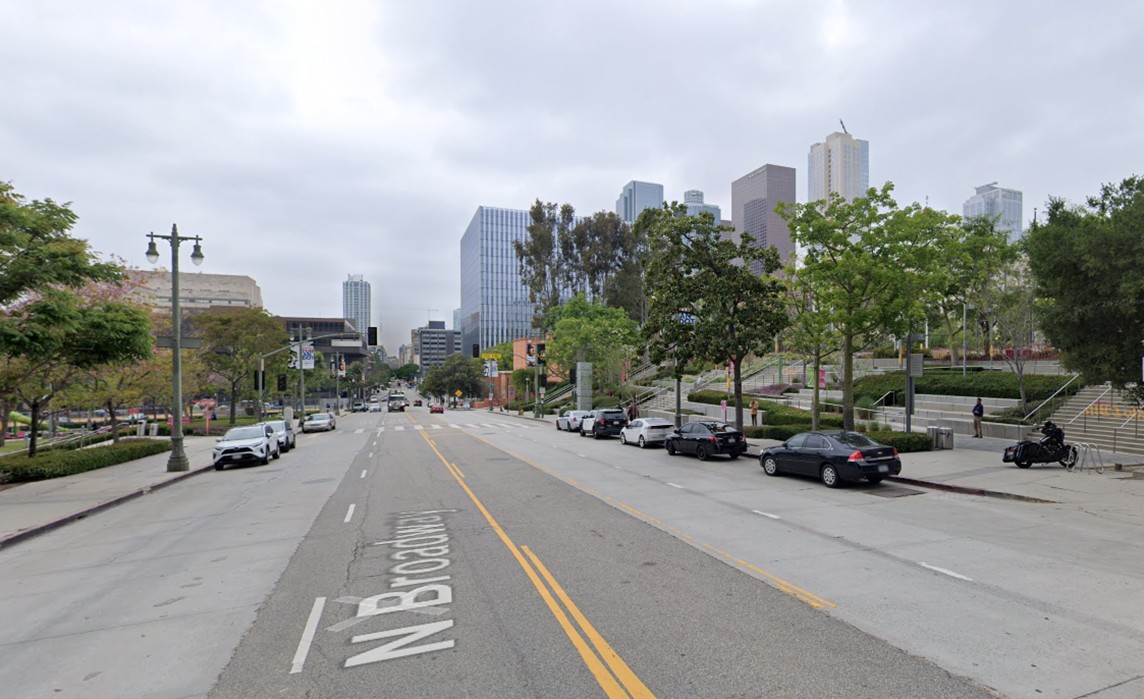 |
|
| (2024)* - Looking south on Broadway from near Temple Street, showing what is now Gloria Molina Grand Park, where Court Flight once stood. Note how much the hill has been shaved down. |
Historical Notes Click HERE to see more on the early 5-Globe streetlights seen above. |
Then and Now
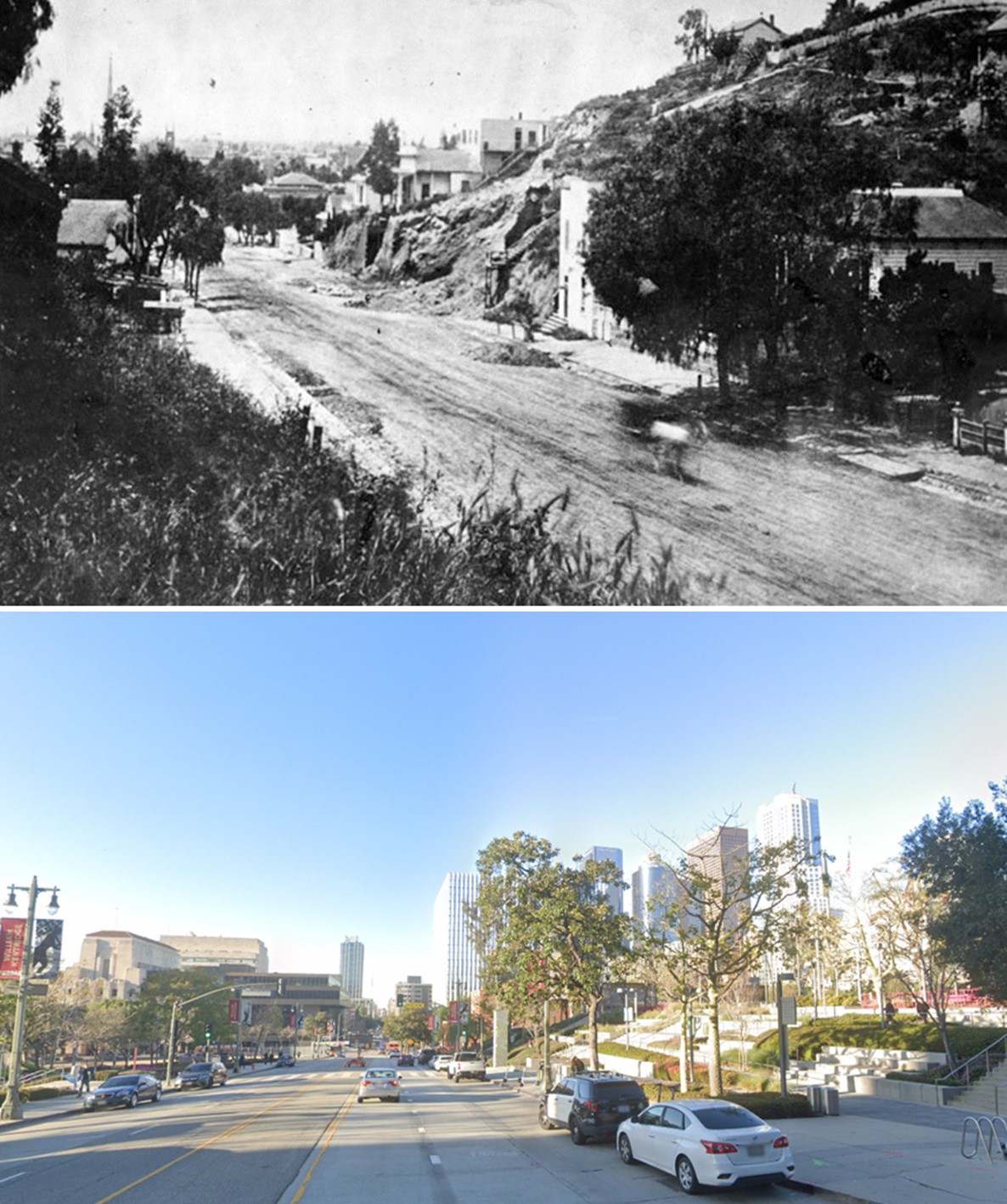 |
|
| (1871 vs 2023)* – A ‘Then and Now’ comparison looking south on Broadway (originally Fort Street) from near Temple Street. The dirt hill at upper right is part of Bunker Hill, which later became the site of Court Flight (1905–1943). Today, Grand Park occupies the area. Note how much of Bunker Hill has been shaved down over time. Photo comparison by Jack Feldman. |
Historical Notes The steep slope spilling onto the unpaved Fort Street was once part of Bunker Hill. Today, this area is where Grand Park is located (aka Gloria Molina Grand Park). |
* * * * * |
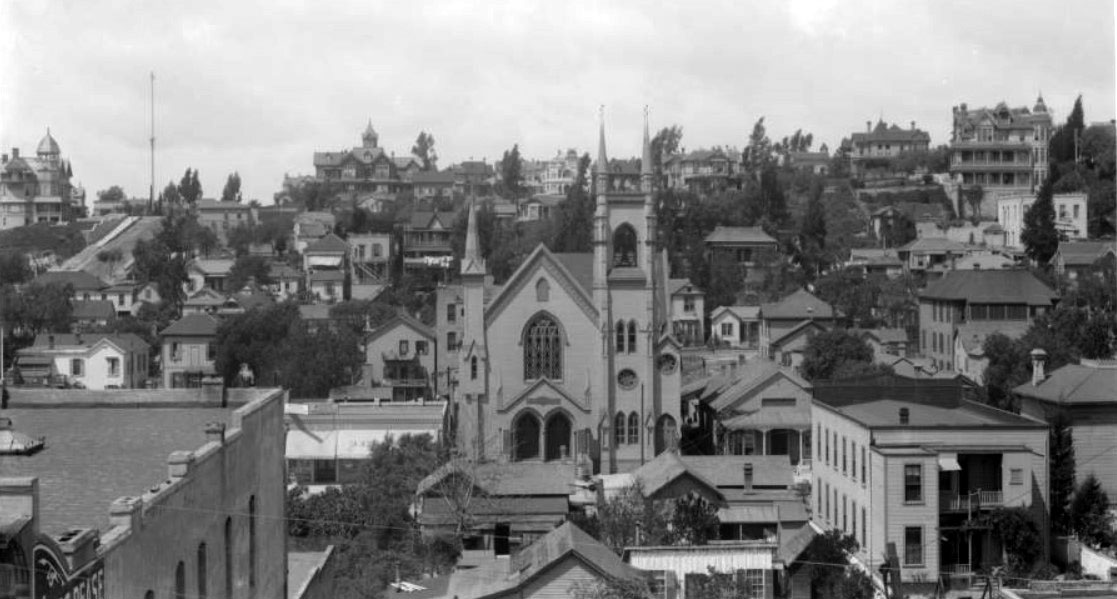 |
|
| (ca. 1890)* - Panoramic view of downtown Los Angeles looking west from Spring Street and Fourth Street toward Bunker Hill across Broadway between Third Street and Fourth Street. Fort Street Methodist Episcopal Church (later purchased by Homer Laughlin for $63,000 in 1899) stands in the center of the photograph which includes principally dwellings. The tall pole at the top of Bunker Hill seen in the upper-left is one of Los Angeles’ earliest electric stretlights, standing 150-ft tall. Click HERE to see more in Early L.A. Streetlights. |
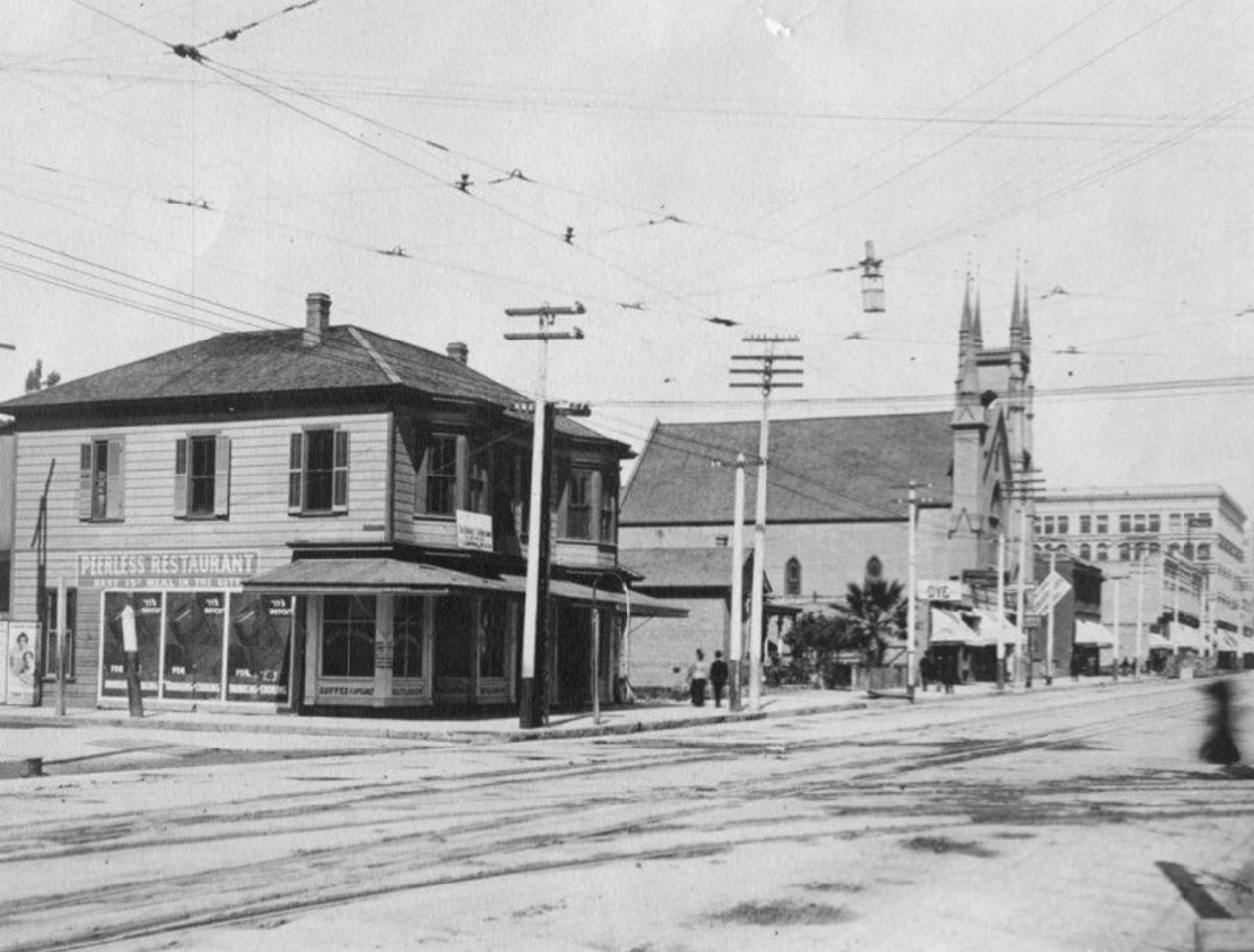 |
|
| (1890)* - View looking north on Fort Street (the year it was renamed Broadway) showing the Fort Street Methodist Episcopal Church, replaced by the Homer Laughlin Building in 1916. Also includes the "Peerless" restaurant, featuring a sign that reads "Best 15 cent meal in the City!" |
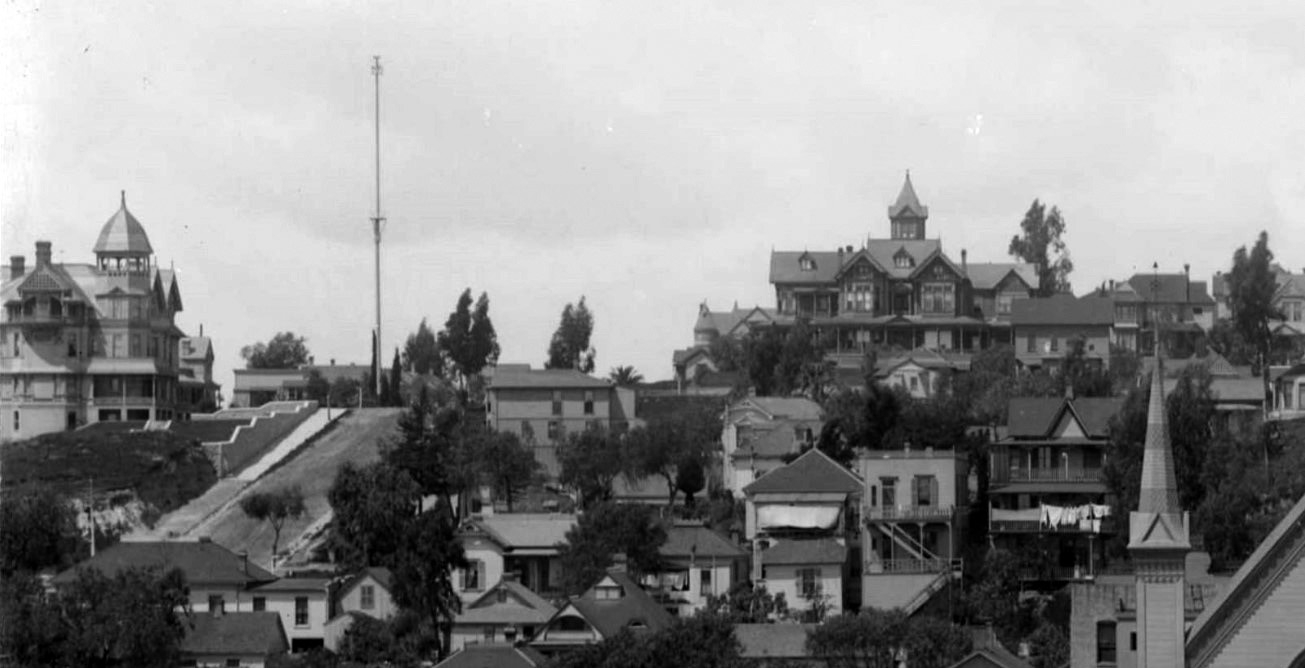 |
|
| (ca. 1890)* –Close-up view looking west toward Bunker Hill showing the impressive Brunson Mansion at center-right with the Rose Mansion at far left. Note the 150-ft tall streetlight at center-left. Click HERE to see more Early Views of LA Streetlights. |
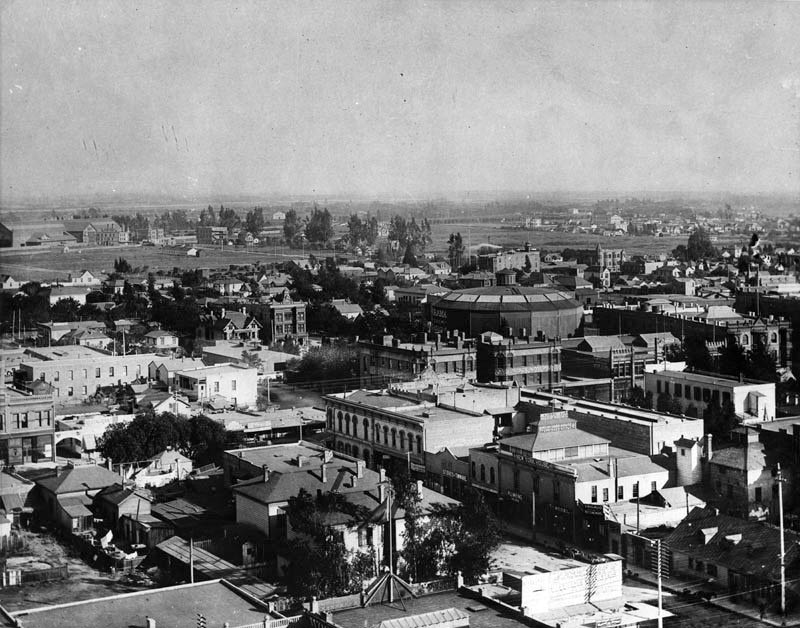 |
|
| (ca. 1890s)^ – View looking southwest showing the Panorama Rotunda (top center-right) located at the center of the block bounded by Main, Los Angeles, 3rd, and 4th streets. |
Historical Notes Downtown Los Angeles debuted a panoramic exhibit in late 1887 in a newly built Panorama Rotunda (seen above). The large circular building, located at Main Street between Third and Fourth Streets, displayed the last battle between the French resistance and Prussian 'besiegers' after which Paris fell in January of 1871. |
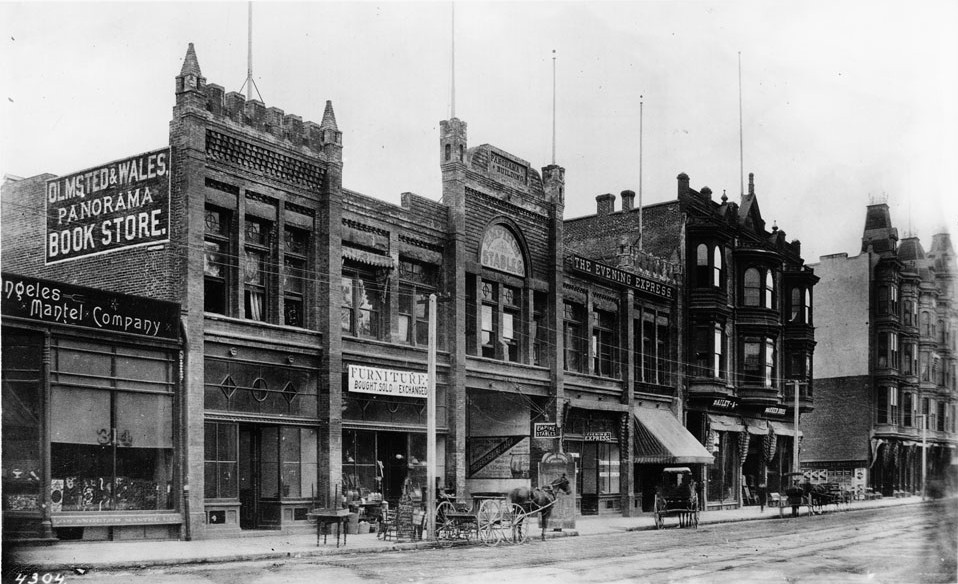 |
|
| (ca. 1890)* - View of Main Street south from 3rd Street. showing the Panorama Building. The Panorama Rotunda is conected to this building and stands to the rear, out of view. The Westminster Hotel, located on the northeast corner of 4th and Main streets, is seen at far right. |
Historical Notes Within a year of its construction, the brick storefront on Main Street through which panorama visitors entered, called ''Panorama Building,' was home to many business ventures, its owners quickly capitalizing on the prestige of the art work and its instantly recognizable address. Not only was it home to the painted battle scene, but also served as a warehouse for the Bancroft Piano Company; a rehearsal hall for the vocal section of the Philharmonic Society; the meeting space for the Young Man's Prohibition Club as well as the Harrison and Morton Club, a Republican party group; and Miss B.M. Tobin's millinery, directly adjacent to the offices of W.O. Merithew, architect. The Evening Express newspaper had its offices in the building, and the Olmstead and Wales Panorama Bookstore was also an early tenant. |
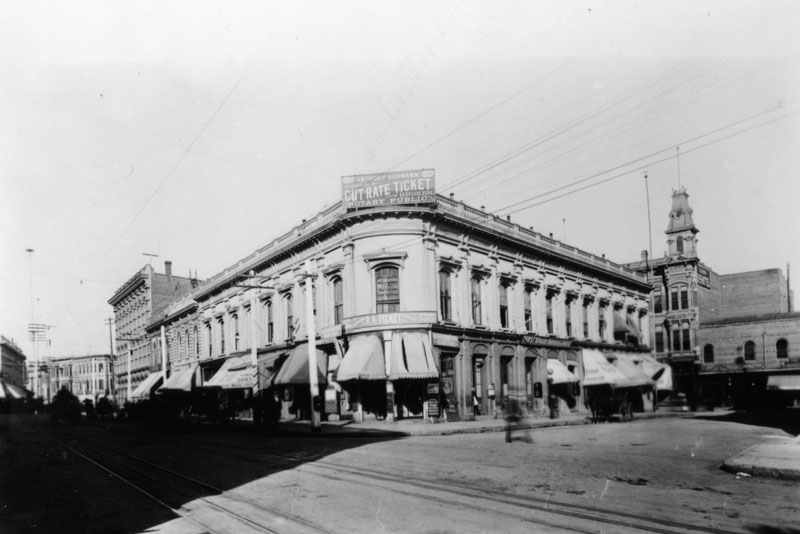 |
|
| (1890)^ - View of Spring and Market Streets in 1890, looking at a two-story building on the corner housing among others Anthony Schwamm, cut-rate ticket broker (railroad) and notary public. The U.S. Hotel with its distinctive tower is seen at right, on the southeast corner of Main and Market streets. |
 |
|
| (1890s)* – Panoramic view looking east from the LA County Courthouse. The Temple Block (site of today’s City Hall) stands in the foreground. Requena Street (later Market Street) runs away from Temple Block at Main Street (center of the photo). You can see an American Flag flying from the side of the Amestoy Building (N/E corner of Main and Requena streets). Across the street (S/E corner) is the U. S. Hotel. |
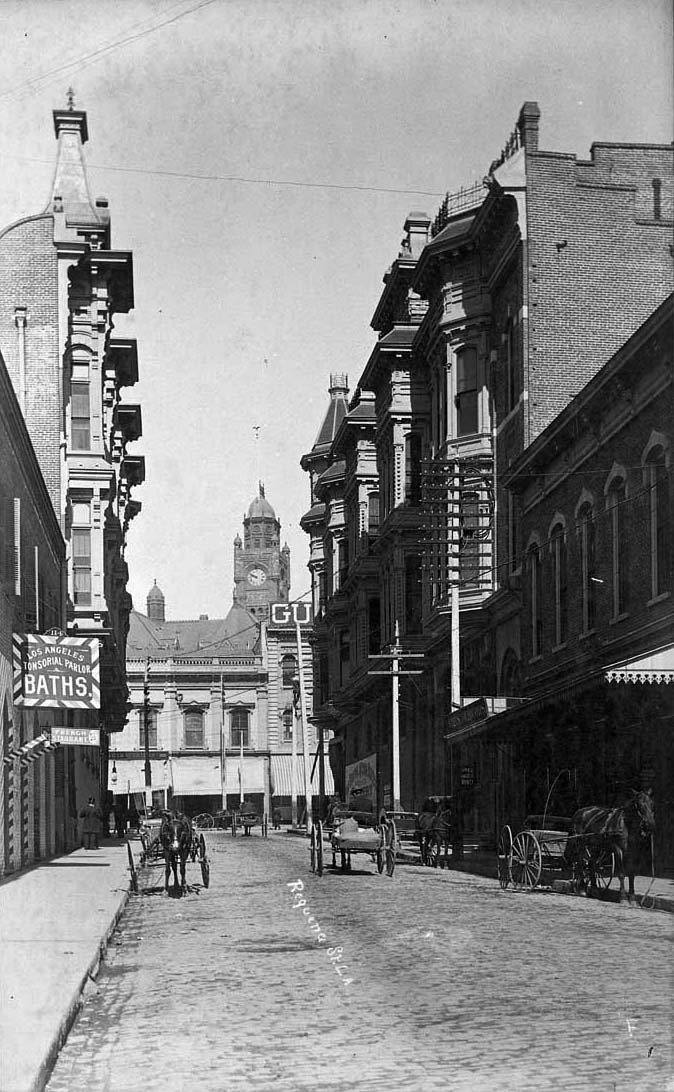 |
|
| (ca. 1890)* - View looking West on Requena Street (later Market Street) toward North Main Street. The U.S. Hotel is on the left and the Amestoy Block on the right. The County Courthouse can be seen in the background. A large sign on the side of the building reads: "Los Angeles Transorial Parlor - BATHS". The two-story building on the right with the horse-drawn wagon parked in front is the H. Newmark & Co. Building. |
Historical Notes Today, City Hall would be standing at the end of Requena/Market St. on Main St. Needless to say, Requena/Market Street does not exist today. |
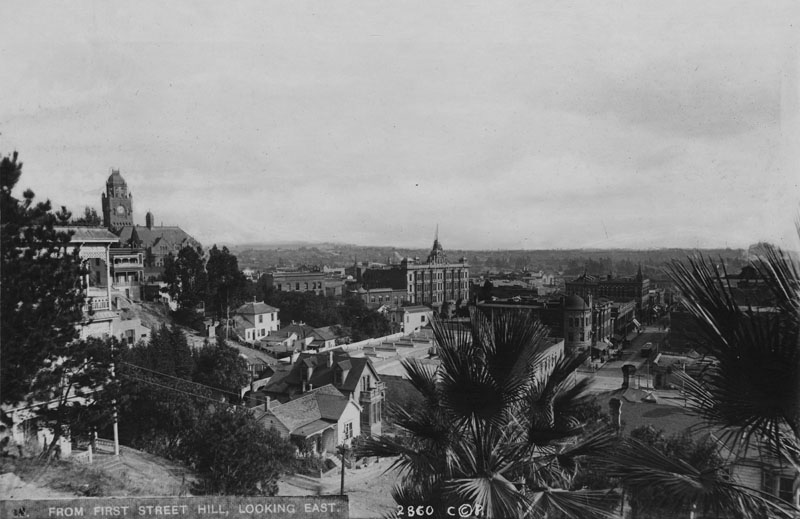 |
|
| (ca. 1890)^ - View of Los Angeles looking east from First and Hill Streets. The Times Mirror building is seen on the northeast corner of West First and Broadway. The County Courthouse is on the left. |
* * * * * |
Views of St. Vibiana's
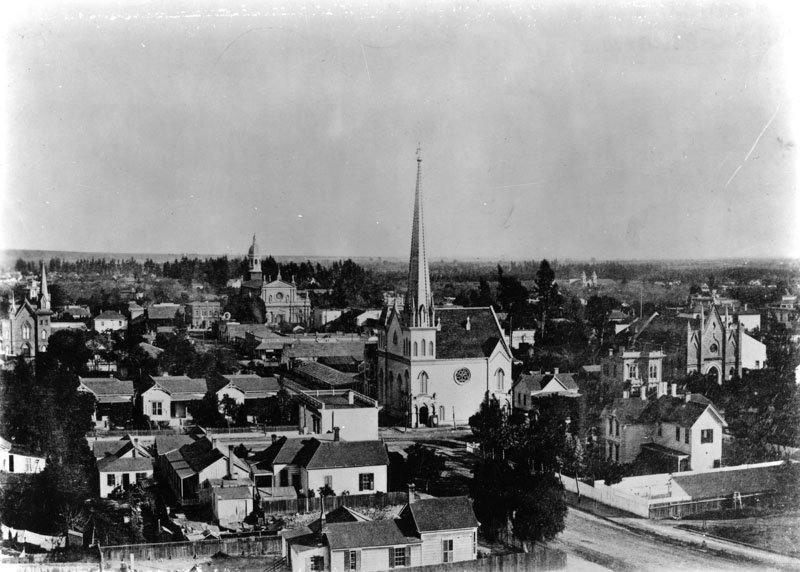 |
|
| (1890)^ - Churches and small business are interspersed with homes in this view of Second Street between Fort and Spring Streets. Fort Street later became Broadway. The church in the center with the tall spire is the First Presbyterian Church at Fort and 2nd. To the church's right is B'nai B'rith Temple, built in 1872. It was the first synagogue in Los Angeles. To the right of B'nai B'rith (out of view) stands City Hall, built in 1888. St. Vibiana's Cathedral is in the background and the Trinity Methodist Episcopal Church South is on the far left at 1st and Spring. A dry goods store between the Cathedral and the Presbyterian church advertises "Groceries & Provisions". |
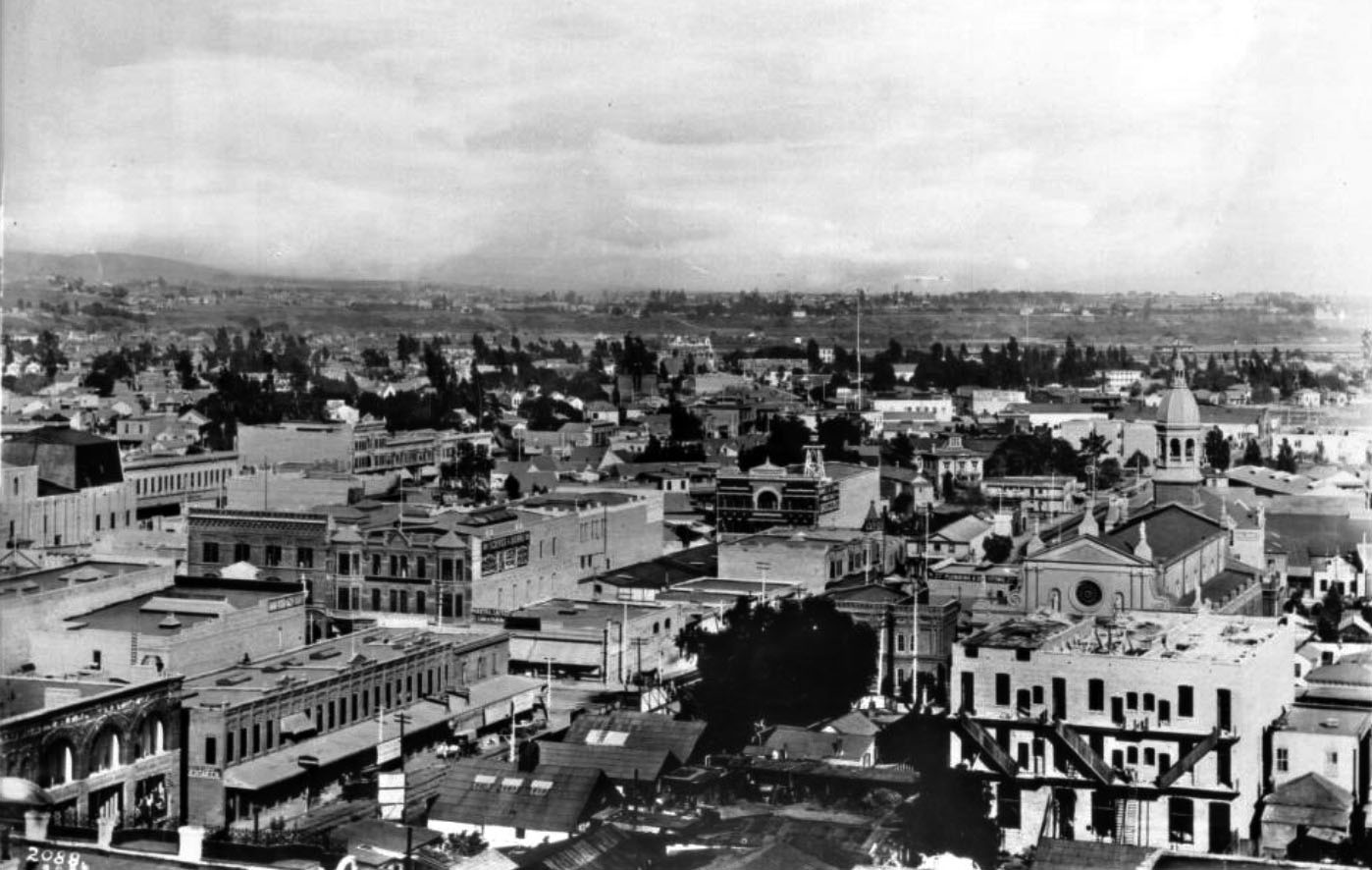 |
|
| (1890)* - Panoramic view of downtown Los Angeles as seen from the City Hall Tower (226 S. Broadway) looking east. St. Vibiana's Cathedral is seen at right. |
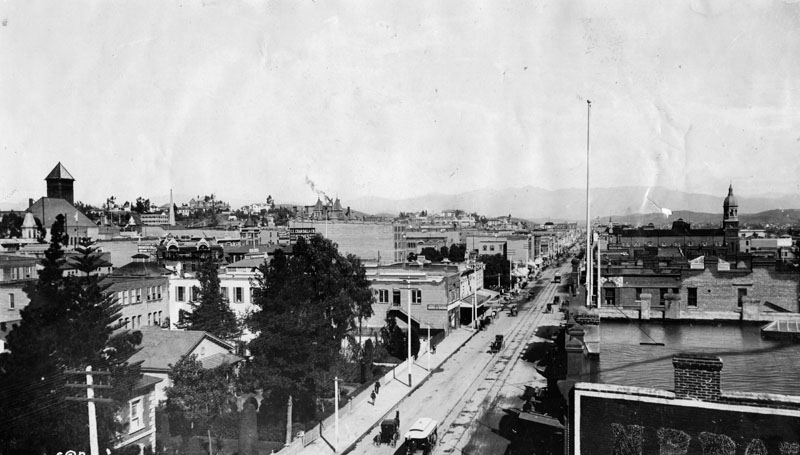 |
|
| (1890)^ - View looking north on Main Street at 4th Street as seen from the Westminster Hotel. The City Hall Tower (226 S. Broadway) can be seen on the far left and St. Vibiana's Cathedral (Main and 2nd, SE Corner) is on the right. |
* * * * * |
Broadway and 3rd Street
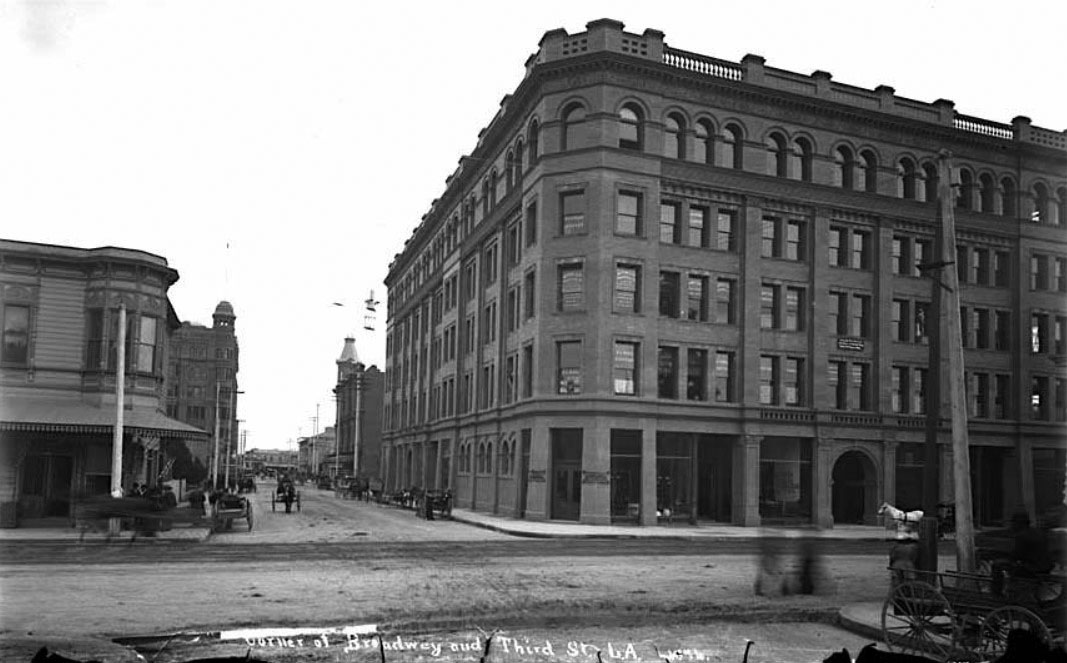 |
|
| (1894)* – Street view looking east on 3rd Street at Broadway with the Bradbury Building at right on the southeast corner. Horse-drawn wagons are seen throughout on the unpaved streets. |
Historical Notes Built in 1893, the Bradbury Building was commissioned by LA mining millionaire Lewis L. Bradbury and designed by local draftsman George Wyman. It still stands today and is the oldest building in Downtown LA. Click HERE to see more Early Views of the Bradbury Building. |
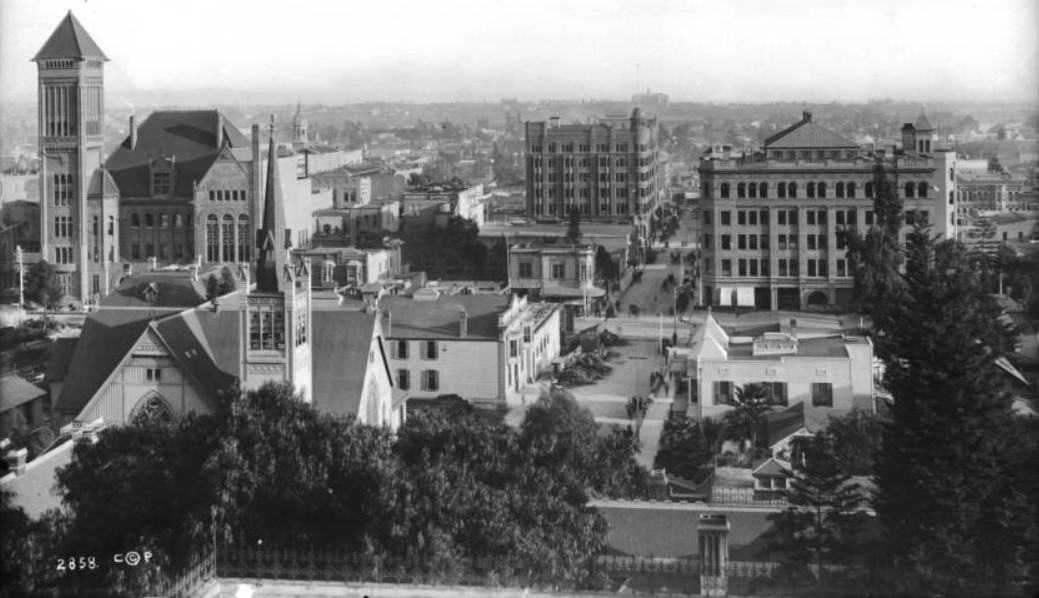 |
|
| (1894)* - Panoramic view of downtown Los Angeles, looking east on Third Street from the balcony of the Crocker Mansion. There is a clear view of the intersection of Broadway and Third Street where the Bradbury Building is seen on the southeast corner. On the northwest corner can be seen the excavation for the Irvine Building. City Hall is at upper-left of photo with the cupola of St. Vibiana's Cathedral behind it in the distance. |
* * * * * |
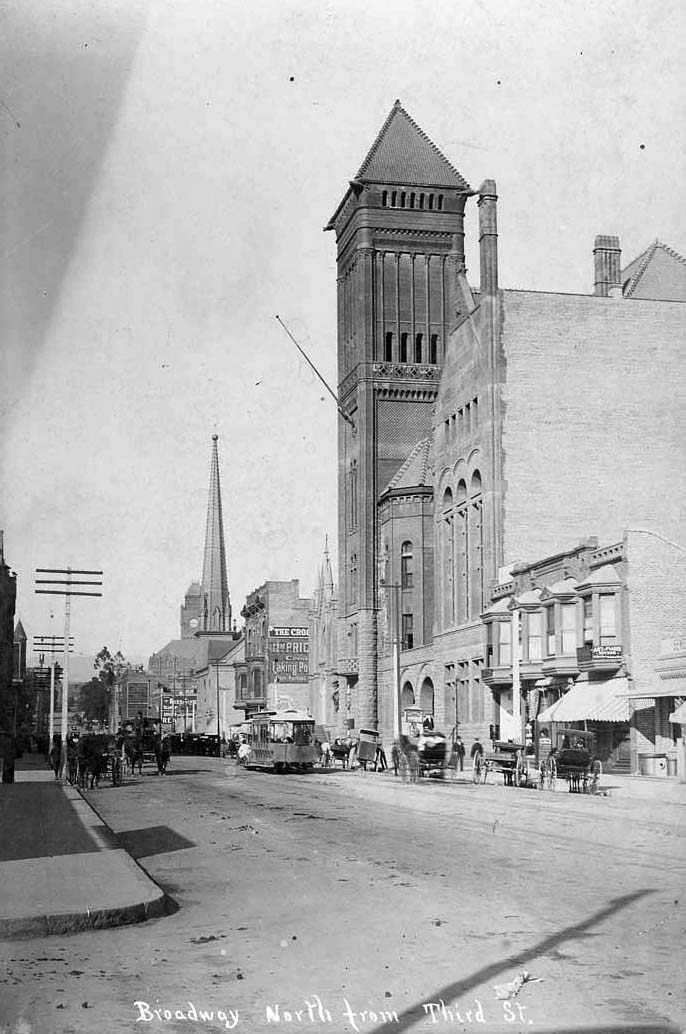 |
|
| (ca. 1895)* - View of Broadway looking north from Third Street. Horse-drawn carriages and a streetcar share the road. |
Historical Notes City Hall (1888-1928) dominates the right of the picture. Several other landmarks of the day can also be seen here. The tower of Los Angeles High School is partially visible to the left of the power poles. The clock tower in the distance is that of the LA County Courthouse. The tall spire next to that belongs to the First Presbyterian Church at the SE corner of Broadway and Second Street. And, the gothic structure just barely visible between City Hall and the Crocker Building (with the two bay windows) is Los Angeles' first Jewish synagogue, the B'nai B'rith Temple. |
 |
|
| (ca. 1900)* - View looking north on Broadway from above 3rd Street showing streetcars, horse-drawn wagons, bicycles and pedesrians all sharing the roadway. City Hall stands tall on the east side of Broadway. The LA County Courthouse, built in 1891, stands in the background. The building with the American Flag in the left foreground is the Irvine Building located on the northwest corner of Broadway and 3rd Street. |
Historical Notes Two religious buildings no longer appear on Broadway (see previous photo). They are the B'nai B'rith Temple (demolished in 1896) and the First Presbyterian Church (demolished in 1897). |
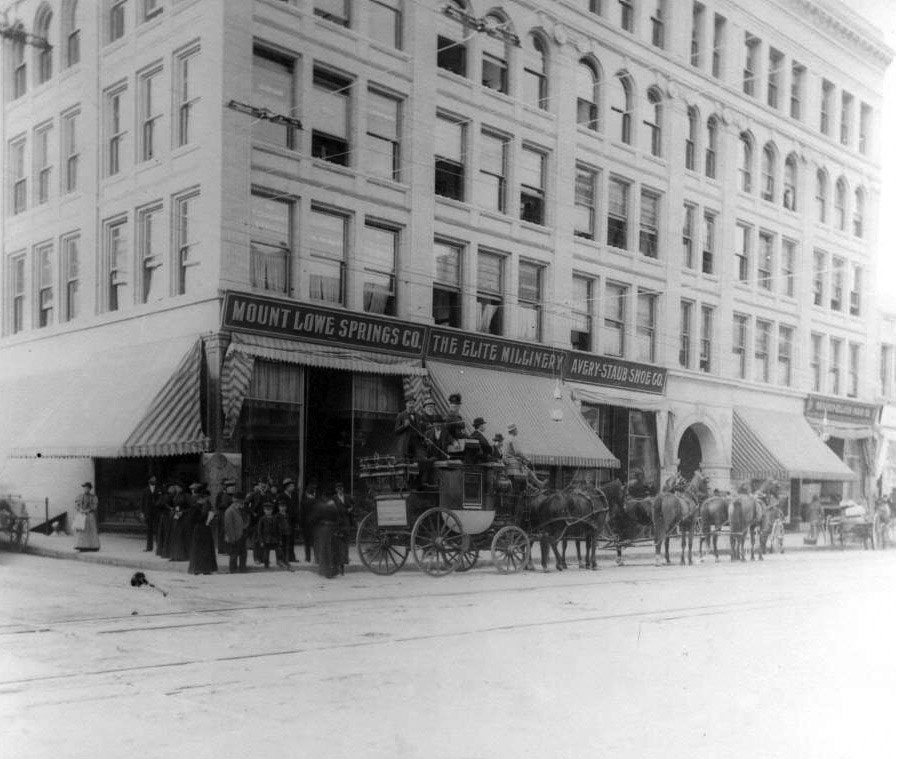 |
|
| (1890s)* – View showing a Tally Ho coach and group of people gathering in front of the Irvine Building, home of the Mount Lowe Springs Co., a Thaddeus Lowe-owned water company. Tally Ho service took passengers to Mount Lowe Railway in the San Gabriel Mountains, north of Pasadena. |
Historical Notes The Mount Lowe Railway was the third in a series of scenic mountain railroads in America created as a tourist attraction on Echo Mountain and Mount Lowe in the San Gabriel Mountains, north of Pasadena. The railway, originally incorporated by Professor Thaddeus S. C. Lowe as the Pasadena & Mt. Wilson Railroad Co. existed from 1893 until its official abandonment in 1938, and had the distinction of being the only scenic mountain, electric traction (overhead electric trolley) railroad ever built in the United States. Lowe’s partner and engineer was David J. Macpherson, a civil engineer graduate of Cornell University. The Mount Lowe Railway was a fulfillment of 19th century Pasadenans' desire to have a scenic mountain railroad to the crest of the San Gabriel Mountains. Click HERE to see Early Views of Mt. Lowe Railway. |
 |
|
| (1890s)* – View showing a Mount Lowe Tally Ho Coach, which provided service for patrons from the Mount Lowe Spring Co. at Third and Broadway in downtown Los Angeles to the Altadena point of embarkation for the Mount Lowe Railway. Click HERE to see Early Views of Mt. Lowe Railway. |
* * * * * |
Figueroa and 6th Streets
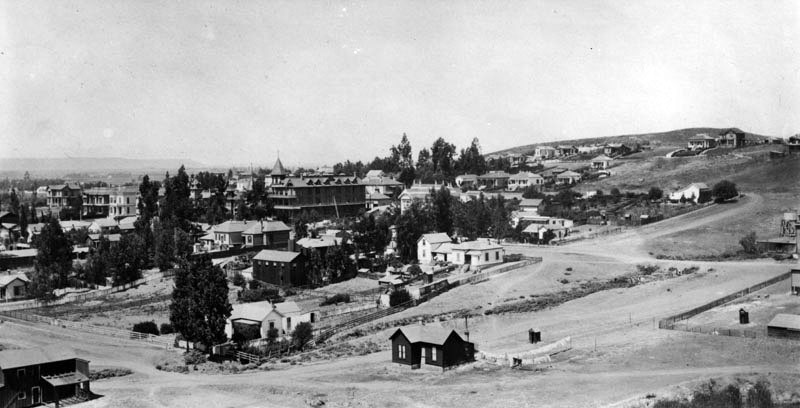 |
|
| (1880s)^ - View looking southwest at the intersection of Pearl Street (later Figueroa) and Bellevue Terrace (later 6th Street). The large Victorian-style Bellevue Terrace Hotel dominates the center, with the Foy House visible nearby. |
Historical Notes At the time of this photograph, Pearl Street had not yet been renamed Figueroa Street (1897), and Bellevue Terrace had not yet become 6th Street. Built in 1884, the Bellevue Terrace Hotel was a three-story Victorian landmark with turrets and wraparound verandas. This location was part of the Bellevue Terrace tract, developed during the late 19th century as Los Angeles expanded westward. |
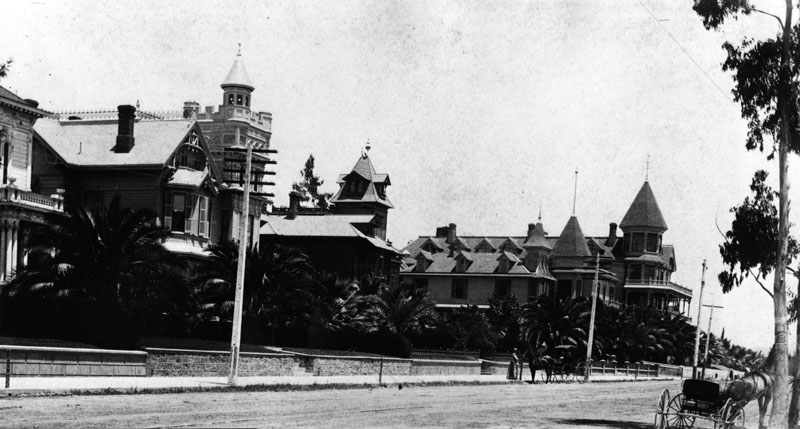 |
|
| (1880s)* - Horse-drawn carriages are seen along Pearl Street (later Figueroa) near Bellevue Terrace (later 6th Street). The Bellevue Terrace Hotel stands on the northwest corner at far right, with two ornate Victorian residences on the left. |
Historical Notes This scene reflects the neighborhood’s residential character before its transition to a commercial district. The hotel catered to wealthy visitors, while upscale Victorian homes lined the surrounding blocks. The intersection’s prominence made it a visible gateway into the growing city. |
 |
|
| (ca. 1898)* - Looking east across Figueroa Street (formerly Pearl Street) toward the corner of Figueroa and 6th (formerly Bellevue Terrace). Three large Victorian homes line the block. The stone retaining wall at right belongs to the Bellevue Terrace Hotel. Photo by C. C. Pierce. |
Historical Notes By the late 1890s, the street name changes were complete, but the area still retained its 19th-century residential feel. The presence of the Bellevue Terrace Hotel alongside elegant private residences shows how the district blended hospitality with high-end living. |
Pearl and Bellevue Terrace (today Figueroa and 6th Streets)
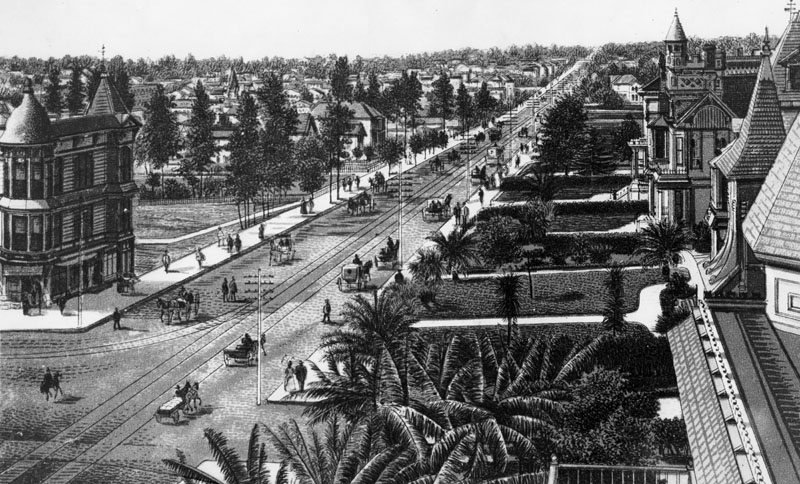 |
|
| (1885)* - Early lithograph view looking south along Pearl Street (renamed Figueroa in 1897) from Bellevue Terrace (later 6th Street). The Bellevue Terrace Hotel occupies the northwest corner at right. |
Historical Notes Built in 1884, the Bellevue Terrace Hotel was one of Los Angeles’s earliest grand Victorian hotels, complete with turrets, wraparound verandas, and lush landscaping. At the time of this illustration, Pearl Street and Bellevue Terrace were still unpaved, lined with tropical and ornamental plants such as banana trees, palms, and manicured cypress hedges. This part of Los Angeles lay just west of the city’s original core and still retained a semi-rural atmosphere despite its proximity to downtown. The area was part of the Bellevue Terrace tract, a fashionable residential and hospitality district for the city’s emerging elite. |
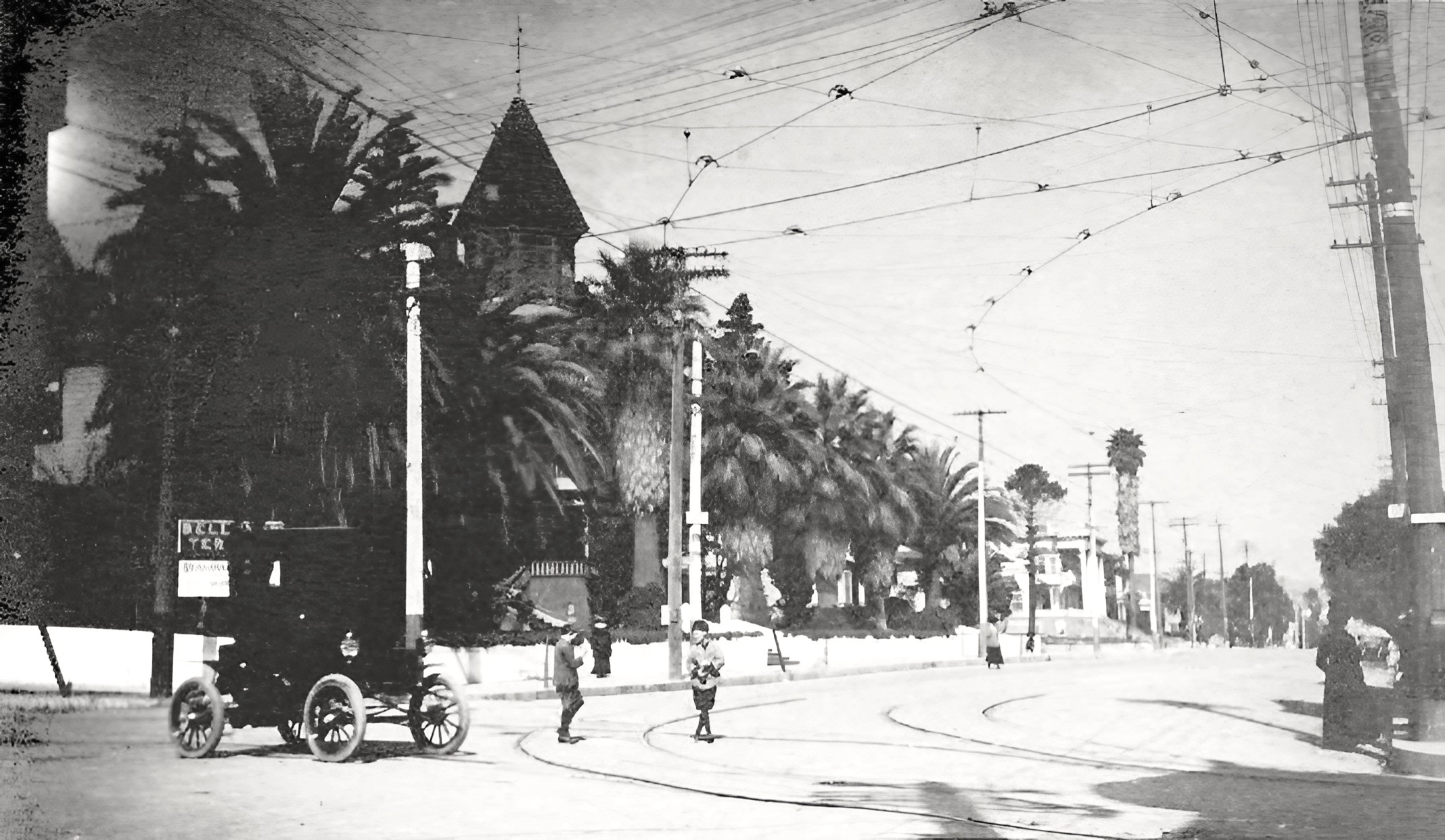 |
|
| (ca. 1910)* – View looking north on Figueroa Street from the corner of Sixth Street. That hulking silhouette behind the palm trees at left is the Bellevue Terrace Hotel. Two young boys are seen in the street as an early model electric car drives by. |
Historical Notes By 1910, Pearl Street had long been renamed Figueroa Street (1897), and Bellevue Terrace had become 6th Street. Streetcar lines and overhead electric wires now crisscrossed the intersection, reflecting Los Angeles’s rapid modernization. The Bellevue Terrace Hotel still stood as a landmark on the northwest corner, largely obscured here by rows of mature palm trees along its frontage. The appearance of an early electric automobile alongside pedestrians and horse-drawn traffic speaks to a transitional moment in transportation history. Within little more than a decade, the hotel would be demolished to make way for the Jonathan Club. |
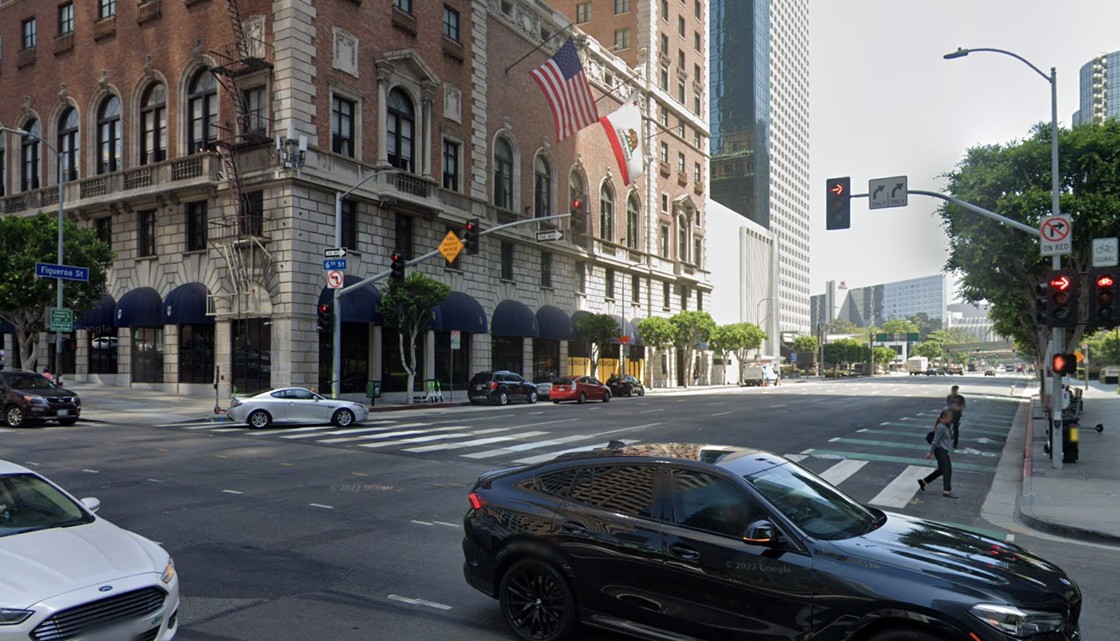 |
|
| (2022)* - Looking north on Figueroa Street at 6th Street, with the Jonathan Club on the northwest corner. |
Historical Notes The Jonathan Club, completed in 1925, replaced the Bellevue Terrace Hotel on the exact same site. Designed by architect Charles F. Whittlesey in the Renaissance Revival style, the building has served as a private social club for nearly a century. Its construction marked the area’s shift from a residential and hospitality district to a commercial and institutional hub. Today, the Jonathan Club remains one of downtown Los Angeles’s most prominent and enduring landmarks. |
Then and Now
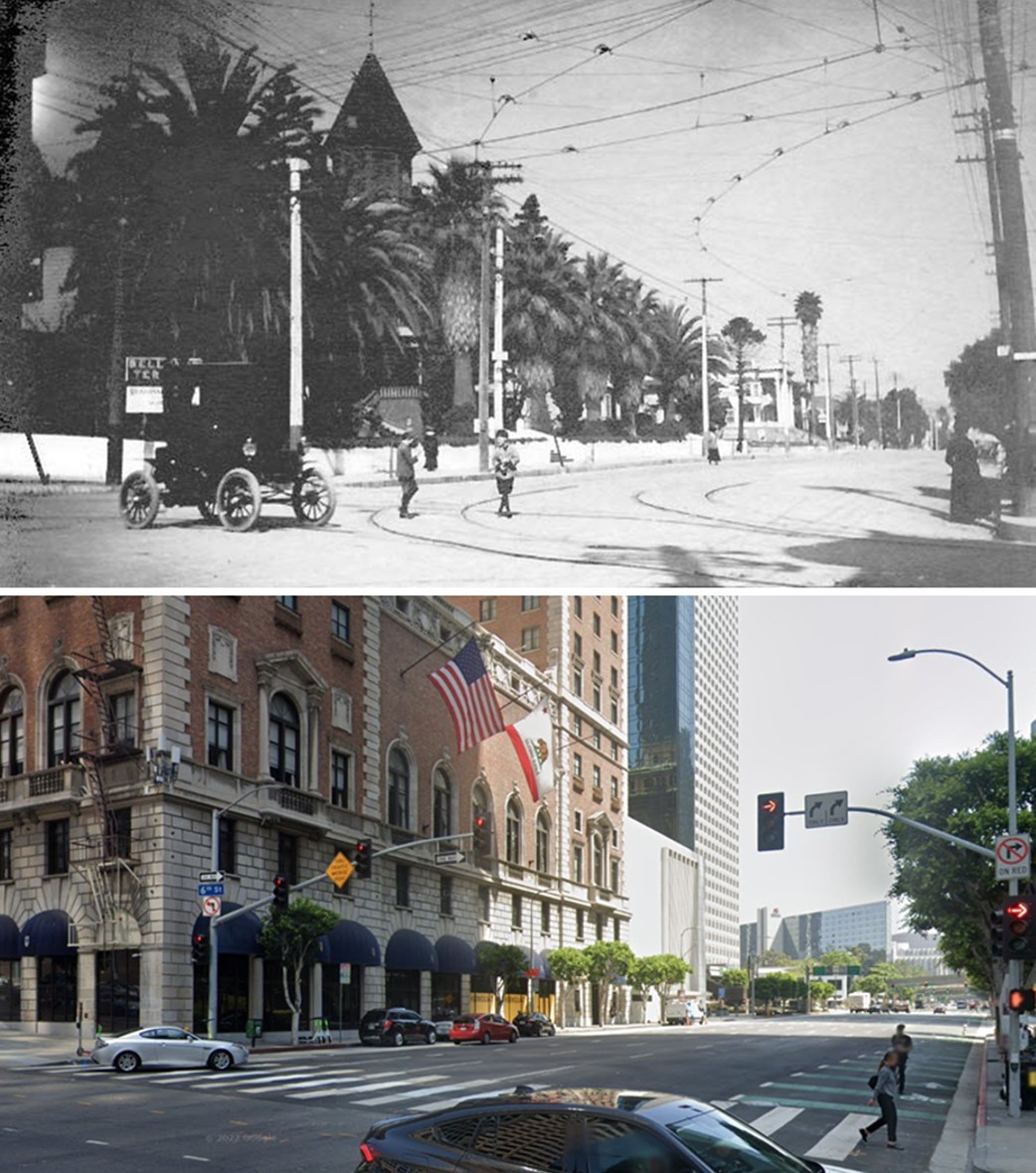 |
|
| (1910 vs 2022)* - Looking north on Figueroa Street at 6th Street in downtown Los Angeles. In 1910, the Bellevue Terrace Hotel stood on the northwest corner; today, the site is home to the Jonathan Club. Photo comparison by Jack Feldman. |
Historical Notes This side-by-side comparison captures more than a century of change at one of downtown Los Angeles’s most storied intersections. In 1910, palm-lined Figueroa Street was a blend of upscale residences, landmark hotels, and early electric transit. By 2022, the same corner has been dominated for nearly 100 years by the Jonathan Club, reflecting both the city’s physical transformation and the continuity of its role as a site for hospitality and social gathering. |
* * * * * |
Bellevue Terrace Hotel
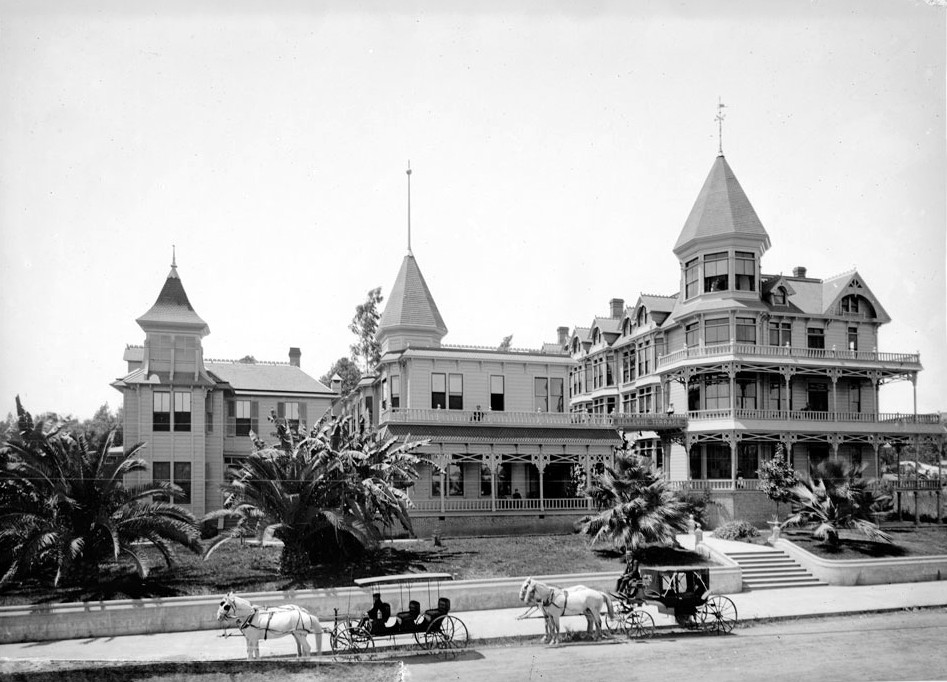 |
|
| (ca. 1890)* - Bellevue Terrace Hotel on the northwest corner of Figueroa and 6th Streets. Two horse-drawn carriages are stopped at the curb. The site is now occupied by the Jonathan Club. |
Historical Notes Built in 1884 on what was then the northwest corner of Pearl Street and Bellevue Terrace (renamed Figueroa and 6th in 1897), the Bellevue Terrace Hotel quickly became one of Los Angeles’ premier Victorian-era hotels. In 1892, Edward L. Doheny and his family stayed here; while watching fuel-laden wagons pass by, Doheny conceived the idea to drill for oil—an insight that sparked Southern California’s oil boom. The hotel remained in operation until the early 1920s, when it was demolished to make way for the Jonathan Club. |
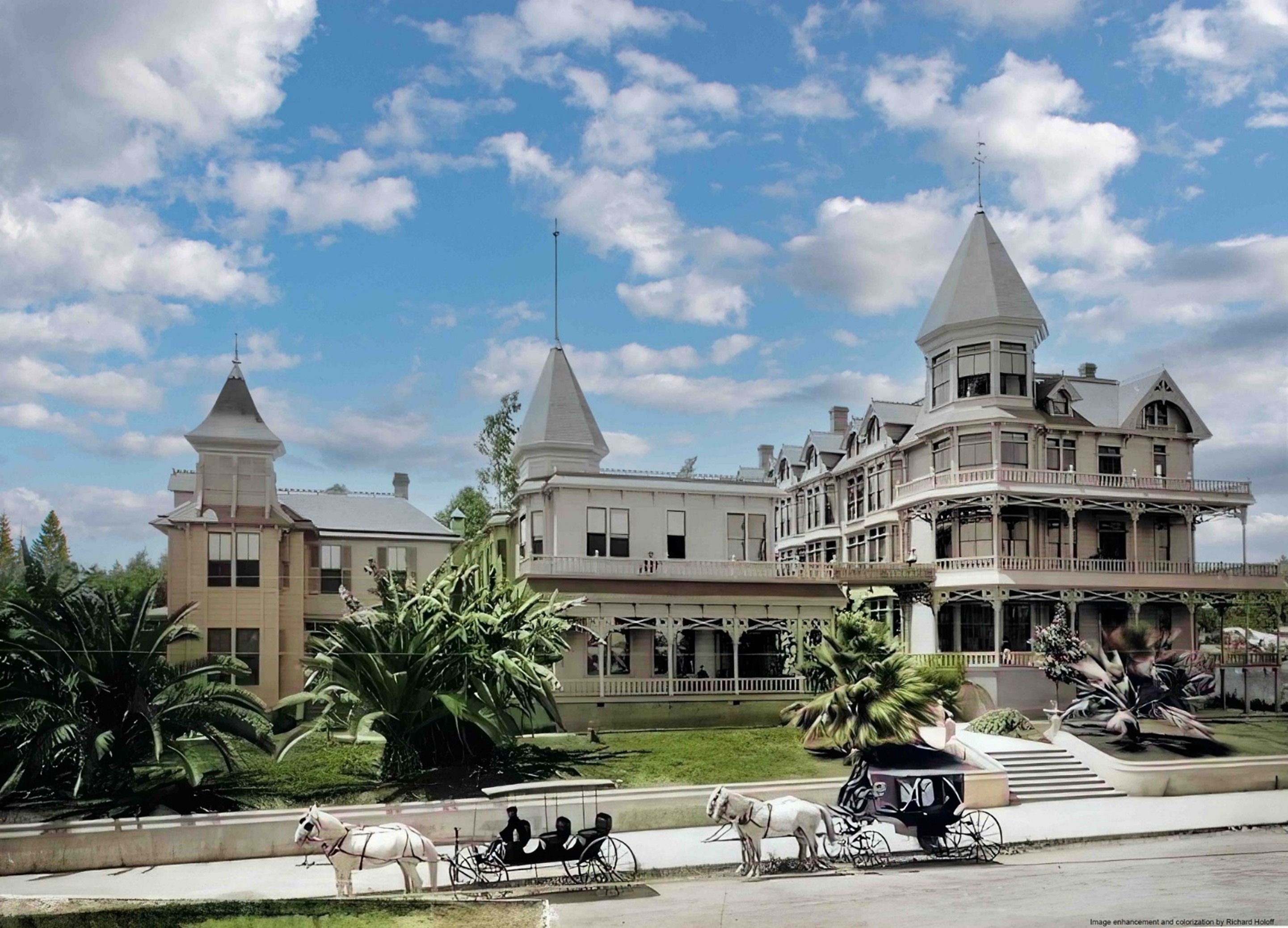 |
|
| (ca. 1890)* - Colorized view of the Bellevue Terrace Hotel at the northwest corner of Figueroa and 6th Streets. The ornate Victorian architecture, including turrets and wraparound verandas, reflected the elegance of the era. Image enhancement and colorization by Richard Holoff. |
Historical Notes Located on what was originally Pearl Street and Bellevue Terrace, the hotel catered to affluent visitors and served as a fashionable social hub in late-19th-century Los Angeles. Its prime location along a major streetcar route and its lush landscaping made it a popular subject for photographers and illustrators. |
 |
|
| (1890)* - Looking south toward the Bellevue Terrace Hotel on the northwest corner of Figueroa and 6th Streets. A boy sits on the steps leading to the entrance. Photo by C. C. Pierce. |
Historical Notes In the 1890s, this intersection was still in transition from a mixed residential-hospitality area to a fully urbanized commercial zone. The paved sidewalk along the front contrasts with the still-unpaved side street—reflecting the gradual modernization of downtown Los Angeles. At the time, the streets were known as Pearl and Bellevue Terrace. |
 |
|
| (ca. 1890)* - Bellevue Terrace Hotel on the northwest corner of Figueroa and what would later be named 6th Street. Young trees partially obscure the lower floors; the sidewalk is paved only along the front, while the side street is unpaved and lined with hitching posts. |
Historical Notes This photograph captures a moment when Los Angeles’s central district still had rural elements. The hotel’s corner location at Pearl and Bellevue Terrace (later Figueroa and 6th) gave it both prominence and easy access for travelers arriving from the west. |
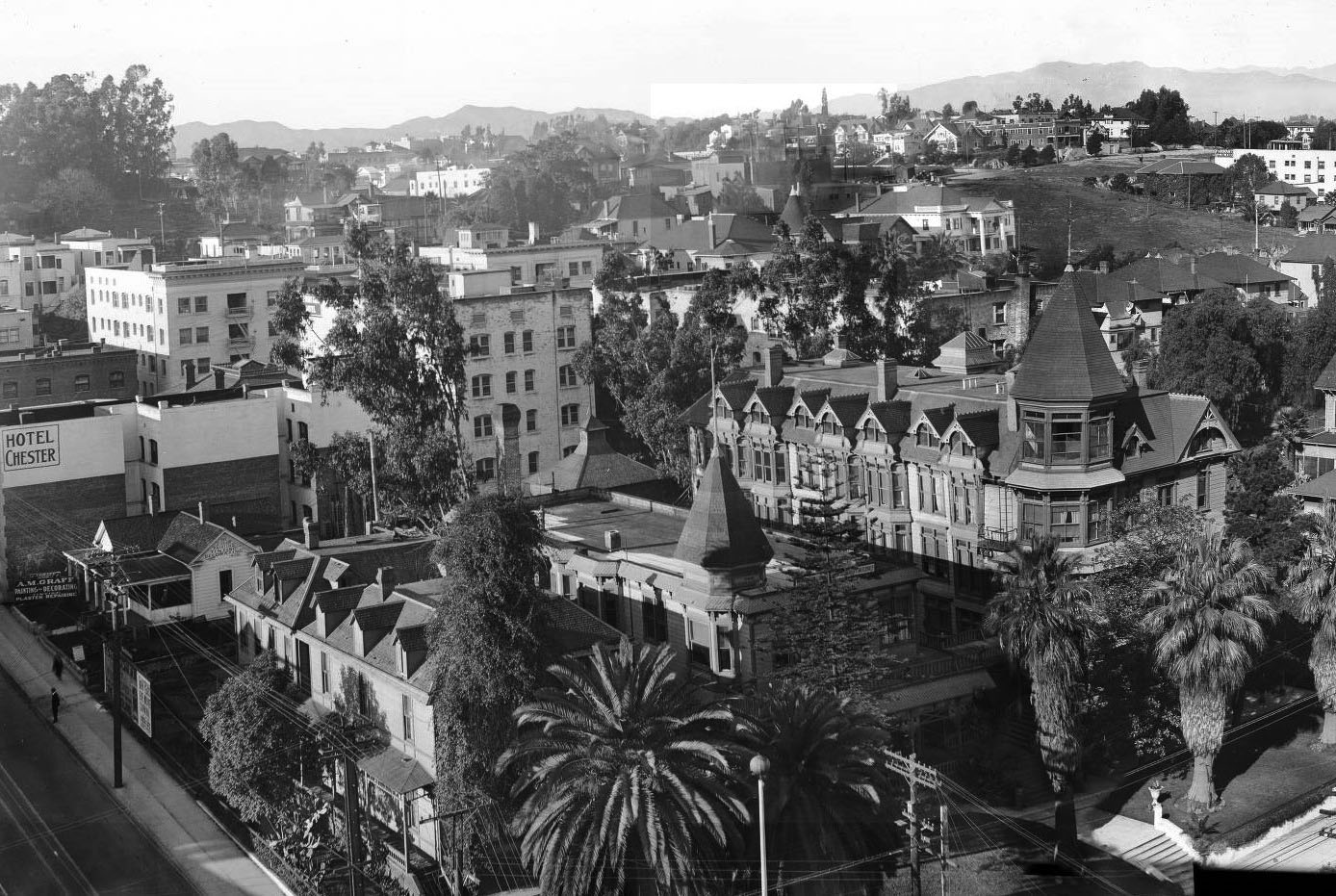 |
|
| (ca. 1916)* – Closer view of the Bellevue Terrace Hotel with 6th Street seen at lower left. |
Historical Notes In 1924, the Jonathan Club would be built on the NW corner of Figueroa and Sixth streets, where the Bellevue Terrace Hotel stood since circa 1890. |
 |
|
| (2024)* - The Jonathan Club, built in 1925, now occupies the northwest corner of Figueroa and 6th Streets, the former site of the Bellevue Terrace Hotel. |
Historical Notes Designed by Charles F. Whittlesey in the Renaissance Revival style, the Jonathan Club has served as a private social club on this site for nearly a century. It directly replaced the Bellevue Terrace Hotel, making this corner home to only two major buildings in over 140 years. |
Then and Now
 |
|
| (1890 vs. 2024)* - The northwest corner of Figueroa and 6th Streets, shown in 1890 with the Bellevue Terrace Hotel and in 2024 with the Jonathan Club. Photo comparison by Jack Feldman. |
Historical Notes From the Victorian elegance of the Bellevue Terrace Hotel to the enduring presence of the Jonathan Club, this corner’s history reflects downtown Los Angeles’s transformation—while remarkably maintaining continuous use as a prominent hospitality and social site. |
* * * * * |
Temple Street Cable Railway
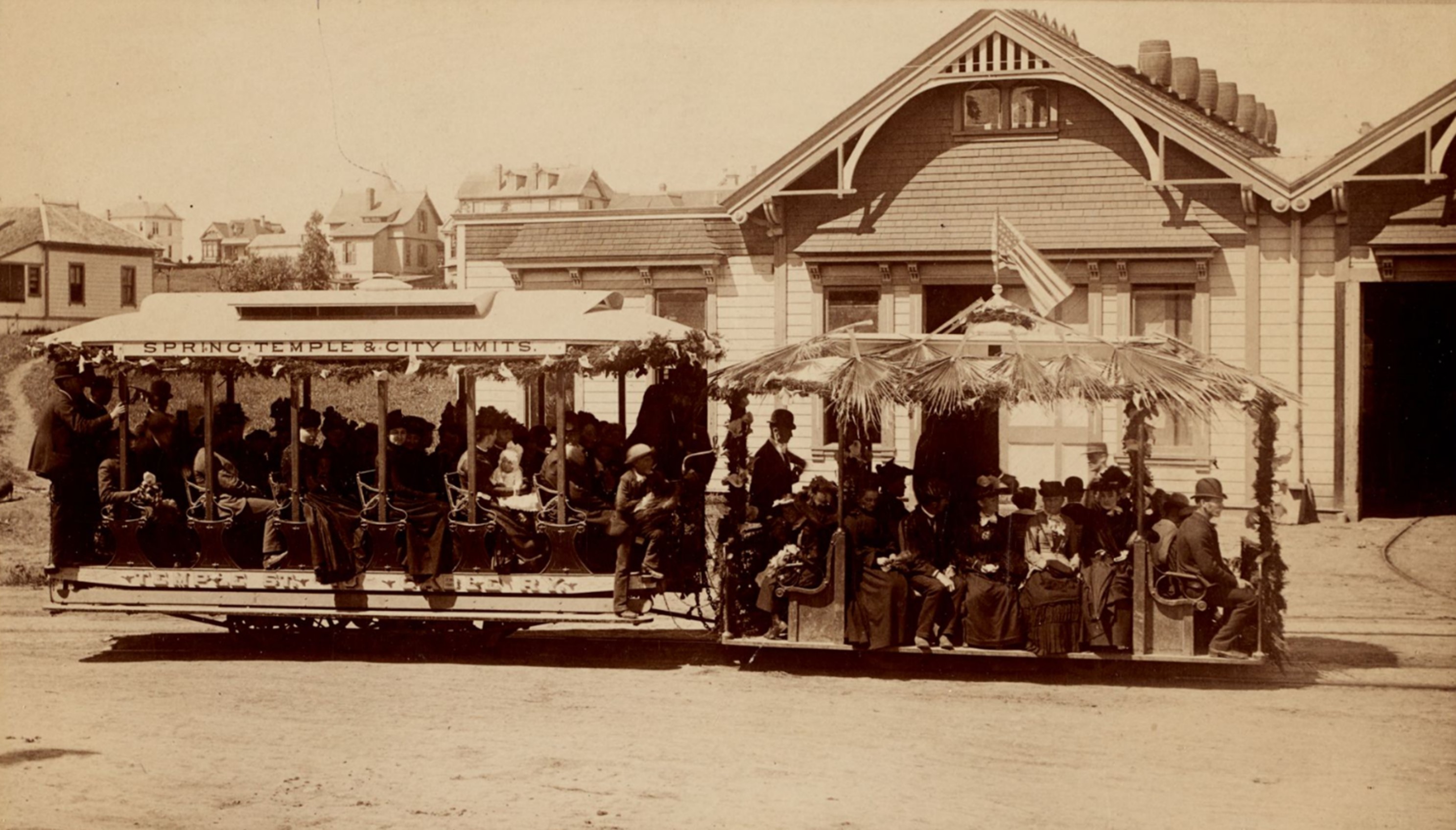 |
|
| (1891)* - Passengers aboard a Temple Street Cable Railway streetcar, labeled 'Spring, Temple & City Limits' across the top and 'Temple St. Cable Ry.' at the bottom, near downtown Los Angeles. The streetcar is stopped in front of the powerhouse, located at the northwest corner of Temple Street and East Edgeware Road in Angelino Heights. Photo from the Ernest Marquez Collection. |
Historical Notes The Temple Street Cable Railway, inaugurated on July 14, 1886, was Los Angeles' second cable car line. It extended from Spring Street downtown, climbing westward to Temple Street before continuing to Beaudry Avenue, serving the growing neighborhoods on the hills overlooking the city. Powered by a steam engine-driven cable system, the line helped shape the development of the western part of Los Angeles, providing a vital link between the downtown area and what was then considered the outskirts. |
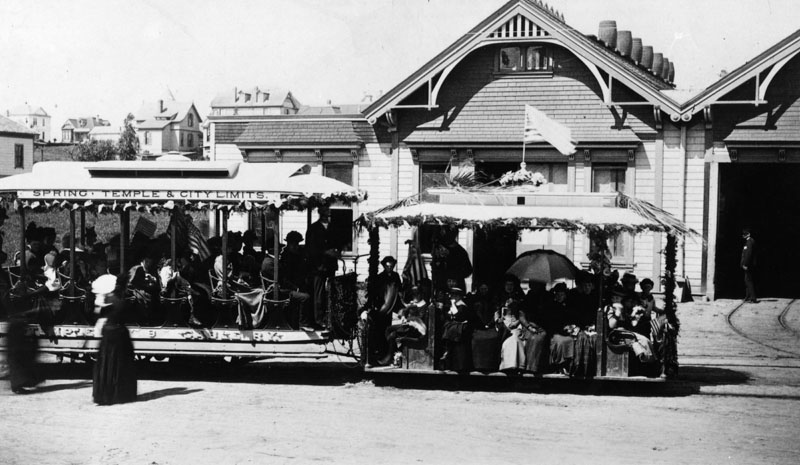 |
|
| (1891)* - Passengers aboard a Temple Street Cable Railway streetcar, labeled 'Spring, Temple & City Limits' across the top and 'Temple St. Cable Ry.' at the bottom, near downtown Los Angeles. The streetcar is stopped in front of the powerhouse, located at the northwest corner of Temple Street and East Edgeware Road in Angelino Heights. Photo from the Ernest Marquez Collection. |
Historical Notes Temple Street Cable Railway, opened on July 14, 1886. Backed by land speculator Prudent Beaudry, who first developed Bunker Hill in the late 1860s, the Temple Street line extended 8,725 feet between Spring Street and Belmont Avenue. There, the streetcar line fueled the growth of Angeleno Heights (today spelled "Angelino Heights"), an early suburb promoted by Beaudry and his brother Victor. "Have a house in the hills!" encouraged the Beaudrys' marketing materials, which advertised the subdivision's street railway link. "Stop paying rent in the Valley!" The company was sold under foreclosure in 1898. Henry E. Huntington acquired it in 1902 and included it in the Pacific Electric Railway after he converted it to electricity. In 1910, the line was transferred to the Los Angeles Railway. The A line, which ran on Temple Street in he 1930's, was one of the first in Los Angeles to be converted to buses. |
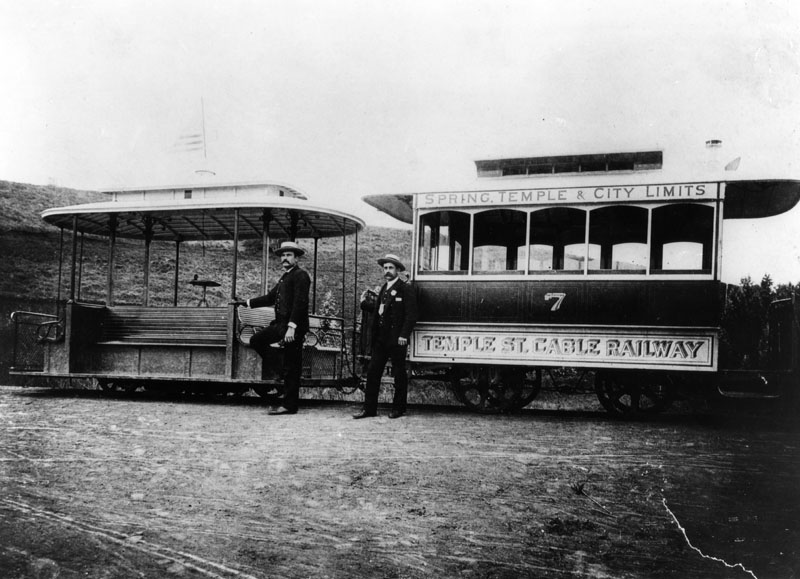 |
|
| (1889)^^ - A streetcar of the Temple Street Cable Railway is stopped near Temple and Hoover Streets in Los Angeles. |
Historical Notes Running from Spring Street to Edgeware Road, and later extended to Hoover Street, the 1.7-mile route used cable car technology. In early Los Angeles, there were a total of three cable railways: 1. Second Street Cable Railway (1885) – The first cable railway in Los Angeles, running from downtown westward along Second Street. 2. Temple Street Cable Railway (1886) – The second cable railway, serving the area along Temple Street and promoting development in Angelino Heights. 3. Los Angeles Cable Railway (1889) – The third and final cable line, which operated in the Boyle Heights neighborhood on the east side of the Los Angeles River. These three systems were relatively short-lived, as electric streetcars eventually replaced them due to the high cost and maintenance challenges of cable car operations. |
* * * * * |
Angeleno Heights (aka Angelino Heights)
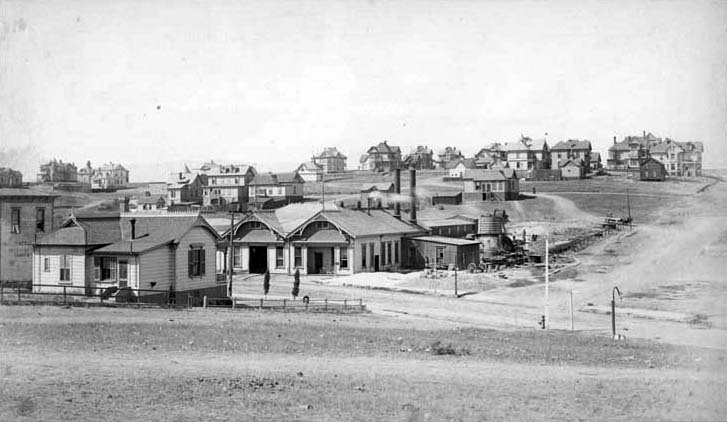 |
|
| (ca. 1890)* - View of Angelino Heights looking north at the corner of Temple Street and East Edgeware Road. The two buildings on the northwest corner belonged to the Temple Street Cable Railway. The front building with tracks running into its entry is the cable car barn. The building in the rear with the smokestacks is the powerhouse. |
Historical Notes Originally spelled Angeleno Heights, Angelino Heights is second only to Bunker Hill as the oldest district in Los Angeles. Founded in 1886, it was originally connected to the downtown mainline (which ran east to west on Temple Street) by the Temple Street Cable Railway and later by streetcars. |
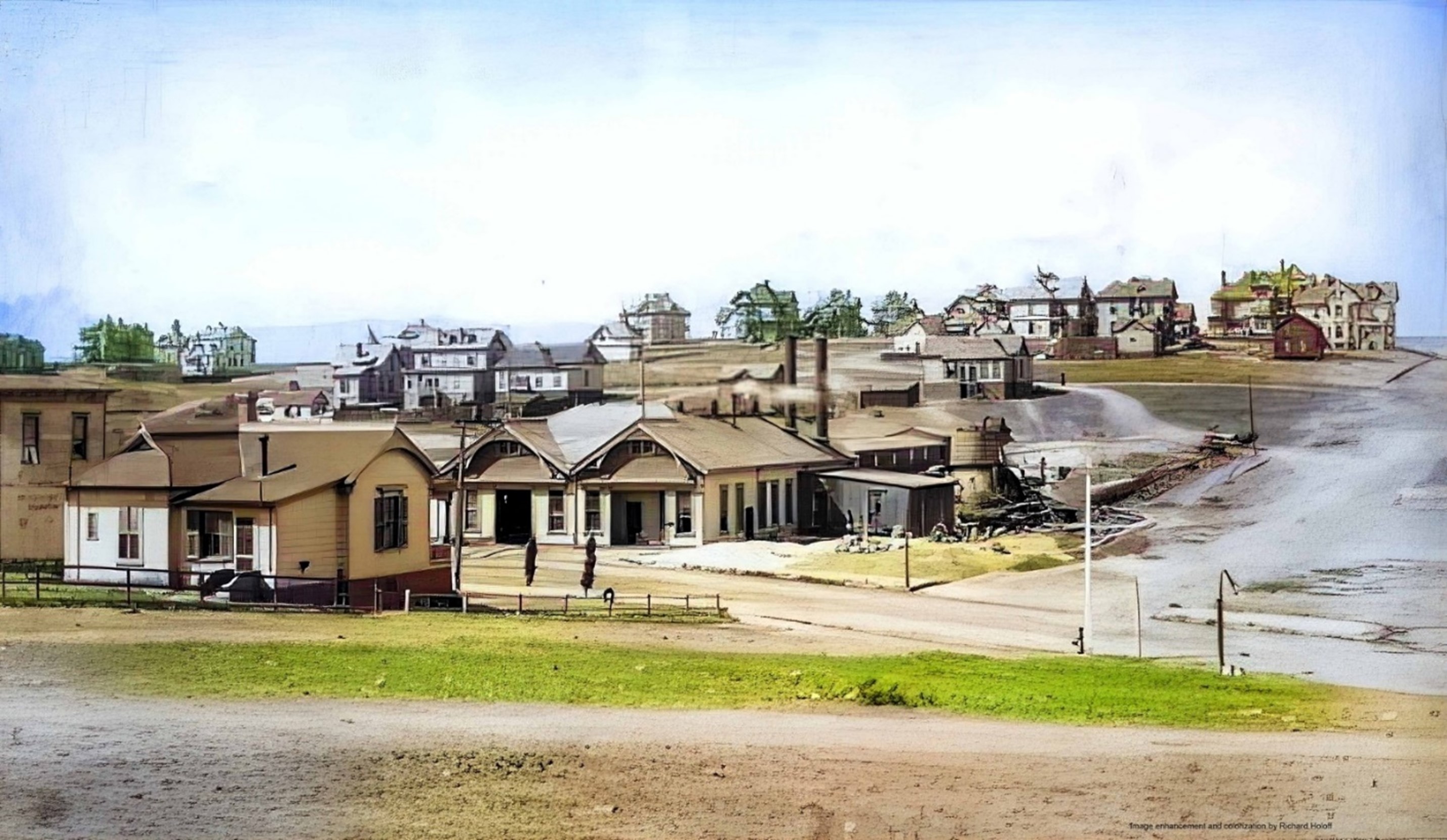 |
|
| (ca. 1890)* - View of Angelino Heights looking north at the corner of Temple Street and East Edgeware Road. The two buildings on the northwest corner belonged to the Temple Street Cable Railway. The front building with tracks running into its entry is the cable car barn. The building in the rear with the smokestacks is the powerhouse. Image enhancement and colorization by Richard Holoff. |
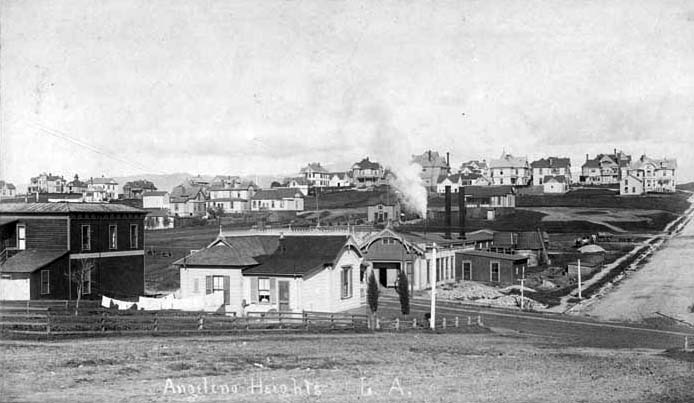 |
|
| (ca. 1890)* - View of Angelino Heights looking north. In the lower right is the intersection of Temple Street and East Edgeware Rd. Smoke is coming out of one of the stacks at the street cable car power plant. Homes cover the hillside in the background. |
Historical Notes In the late 1940s, a large swath of Angelino Heights was destroyed to build the Hollywood Freeway. The new freeway cut off Temple Street save an overpass at Edgeware Road. |
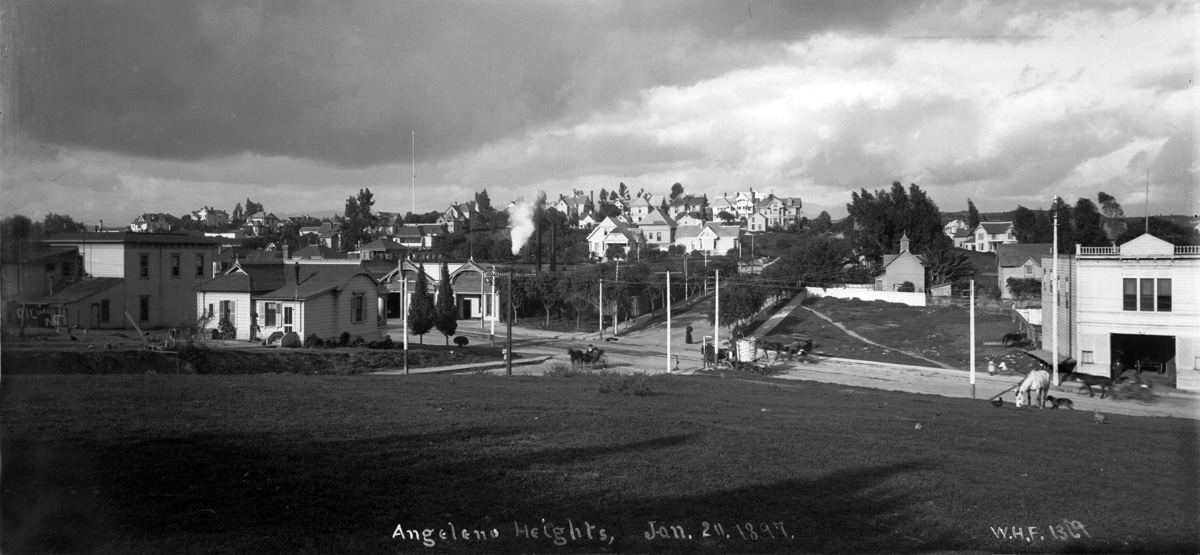 |
|
| (1897)^*# - Angeleno Heights looking north from Temple Street and Edgeware Road. The Temple Street Cable Railway power house is to the left of center. The top row of houses in the center are on Carroll Avenue and almost all are still there. |
Historical Notes In the last 20 years or so, most of the Victorian and Craftsman buildings in the Angelino Heights neighborhood have been restored. Angeleno Heights or Angelino Heights? Old tract maps, show the name spelled “Angeleno” with an “e” but the city’s Office of Historic Resources uses “Angelino” with an “i.” The neighborhood’s Wikipedia entry for Angelino Heights said the neighborhood’s name was originally spelled Angeleno. A history piece in L.A. Magazine title “CityDig: The Living History of Angelino Heights” goes on to spell the name both ways. |
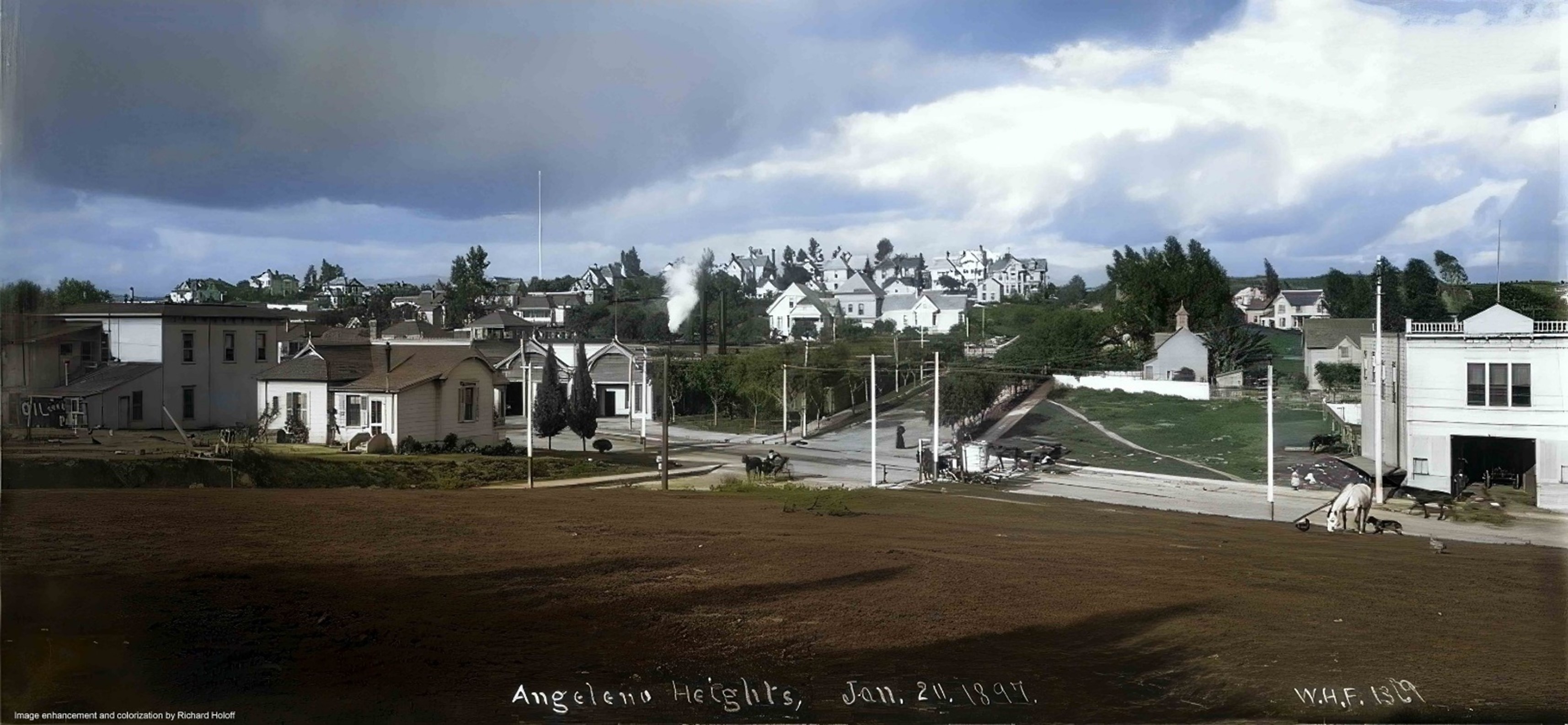 |
|
| (1897)^*# - Angeleno Heights looking north from Temple Street and Edgeware Road. The Temple Street Cable Railway power house is to the left of center. The top row of houses in the center are on Carroll Avenue and almost all are still there. Image enhancement and colorization by Richard Holoff |
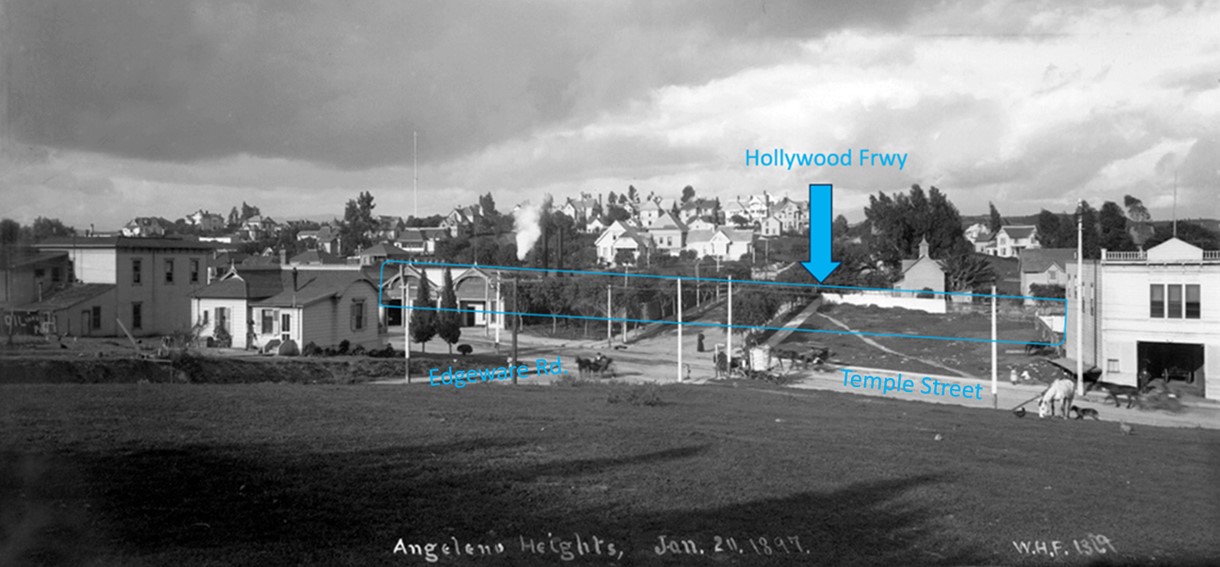 |
|
| (1897)^*# - Angeleno Heights looking north from Temple Street and Edgeware Road showing where the Hollywood Freeway is located today. |
Historical Notes In the late 1940s, a large swath of Angelino Heights was destroyed to build the Hollywood Freeway. The new freeway cut off Temple Street save an overpass at Edgeware Road. |
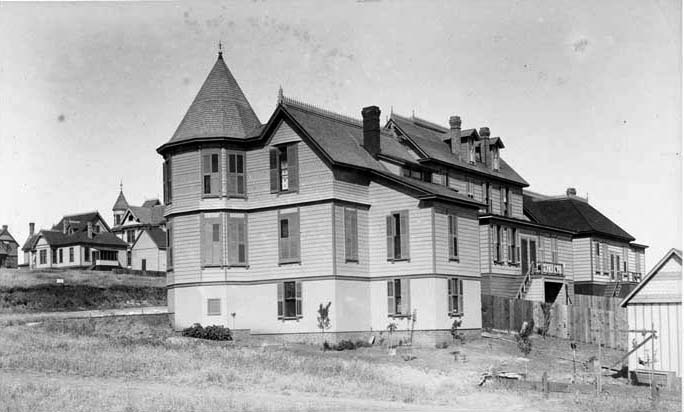 |
|
| (ca. 1890)* - Close-up view of the multi-story homes of Angelino Heights. |
Historical Notes Angelino Heights was the City of Los Angeles' first recognized historic district, or Historic Preservation Overlay Zone (HPOZ). Enacted in 1983 and spelled out in Angelino Heights' Preservation Plan, this zoning prohibits unsympathetic remodelling of historic houses and requires new construction to resemble original architecture in scale, massing and materials. Today, the district contains many notable examples of Victorian architecture, particularly of the Eastlake and Queen Anne styles, and though found throughout the neighborhood, they are especially concentrated on Carroll Avenue. Two of these residences served as the houses used for the TV shows Charmed and Journeyman, used in the shows as San Francisco Victorian residences, and because of the picturesque nature of the neighborhood, they have served as the backdrop for countless motion pictures from the earliest days of cinema to the present. Traveling around the neighborhood, one also discovers that many other styles of architecturally significant homes are to be found here, such as Craftsman, Bungalow, Mission Revival, Art Deco, and Colonial Revival, to name a few. Click HERE to see more in Early L.A. Buildings (1800s). |
* * * * * |
1890's Oil Boom
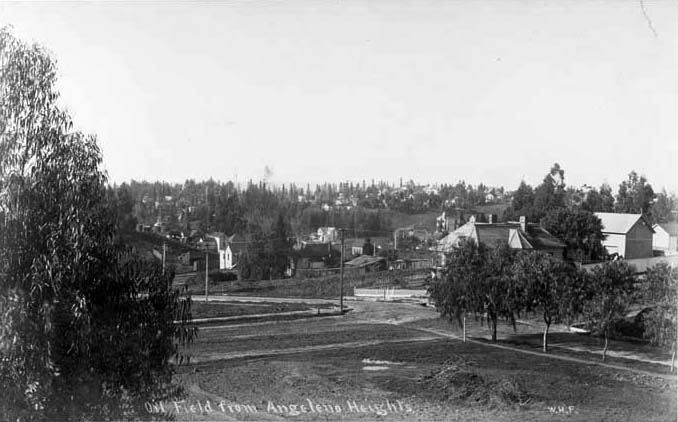 |
|
| (ca. 1890s)^ - View loking south from Angelino Heights. Oil derricks can be seen in the distance. |
Historical Notes In 1892, Edward Doheny struck oil south of Angelino Heights and Echo Park, triggering the city’s first oil boom. Soon, hundreds of wells were pumping away in a wide belt stretching roughly south of Temple Street. The wells created enormous wealth but also a stinky, sticky mess for those who lived nearby, including the residents of the newly built Victorian mansions of Angelino Heights.* |
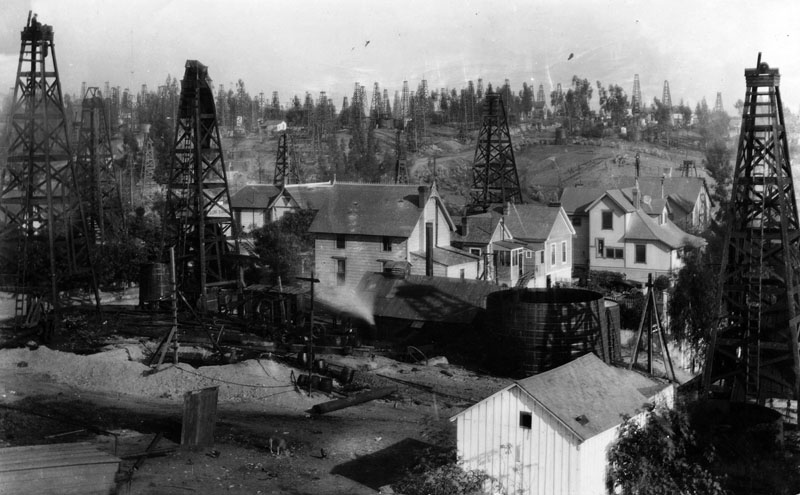 |
|
| (ca. 1890s)^ - Oil field east of 1st Street and Belmont Avenue in Los Angeles. |
Historical Notes Discovered in 1890, and made famous by Edward Doheny's successful well in 1892, the Los Angeles Oil Field was once the top producing oil field in California, accounting for more than half of the state's oil in 1895. In its peak year of 1901, approximately 200 separate oil companies were active on the field, which is now entirely built over by dense residential and commercial development. Some significant public facilities built directly on the area of former oilfield operations include Shriners Hospital for Children, St. Vincent Medical Center, Belmont High School, and the Edward R. Royball Learning Center. |
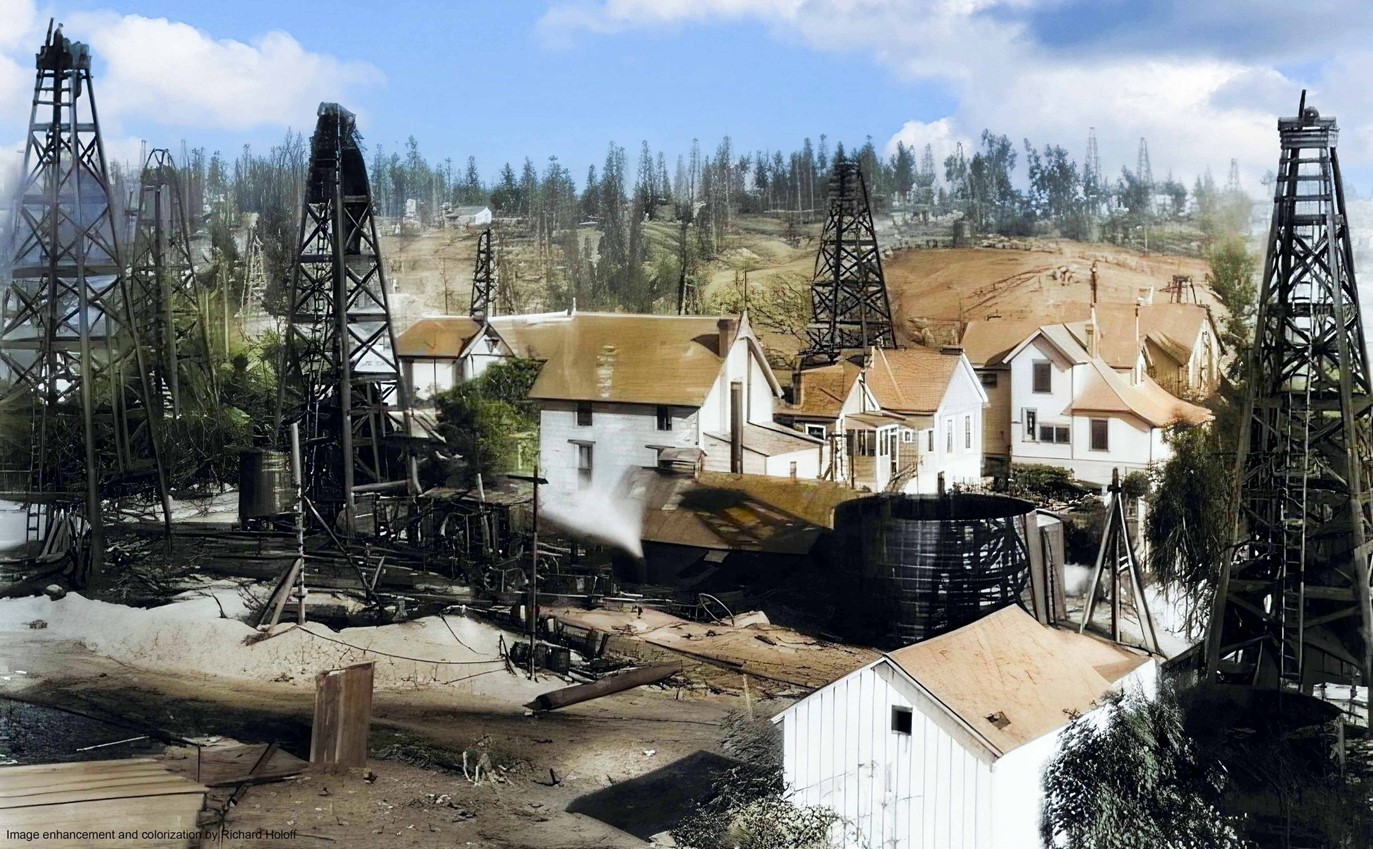 |
|
| (ca. 1890s)^ - Oil field east of 1st Street and Belmont Avenue in Los Angeles. Image enhancement and colorization by Richard Holoff. |
.jpg) |
|
| (1896)* - A 'forest' of oil derricks is interspersed with houses on Toluca Street between 1st Street and Temple Street near downtown Los Angeles. |
Historical Notes By 1897, the once-quiet Crown Hill neighborhood--by then bounded by Temple, Figueroa and 1st streets and Union Avenue--was overrun with promoters, drillers and more than 500 chugging and wheezing derricks. Gingerbread houses and neatly trimmed gardens were quickly transformed by homeowners and leasing companies attempting to turn backyards into pay dirt. Tent cities sprang up all over town, attracting prostitutes and bootleggers. Gambling houses and saloons were busy 24 hours a day. |
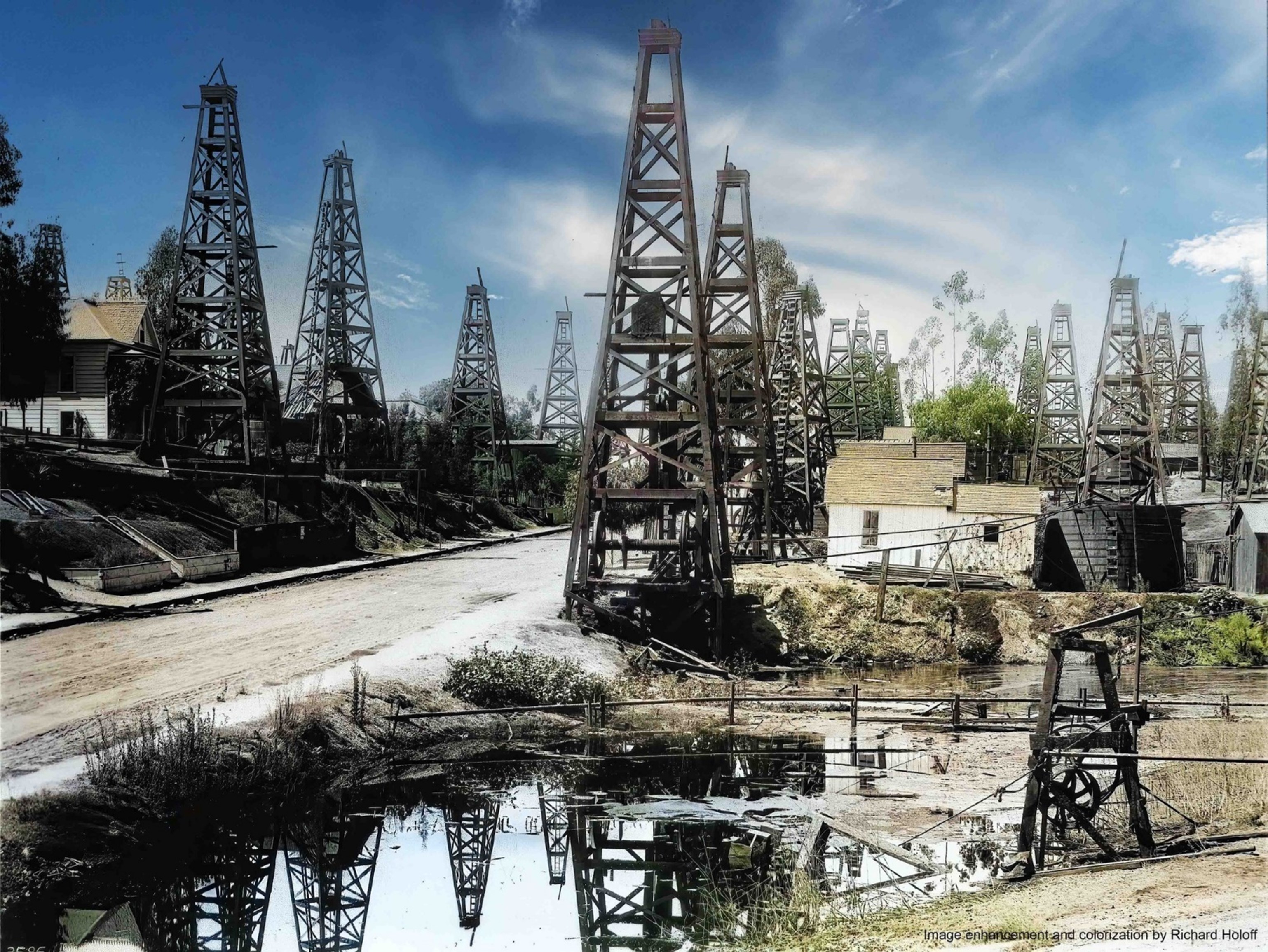 |
|
| (1896)* - A 'forest' of oil derricks is interspersed with houses on Toluca Street between 1st Street and Temple Street near downtown Los Angeles. Image enhancement and colorization by Richard Holoff. |
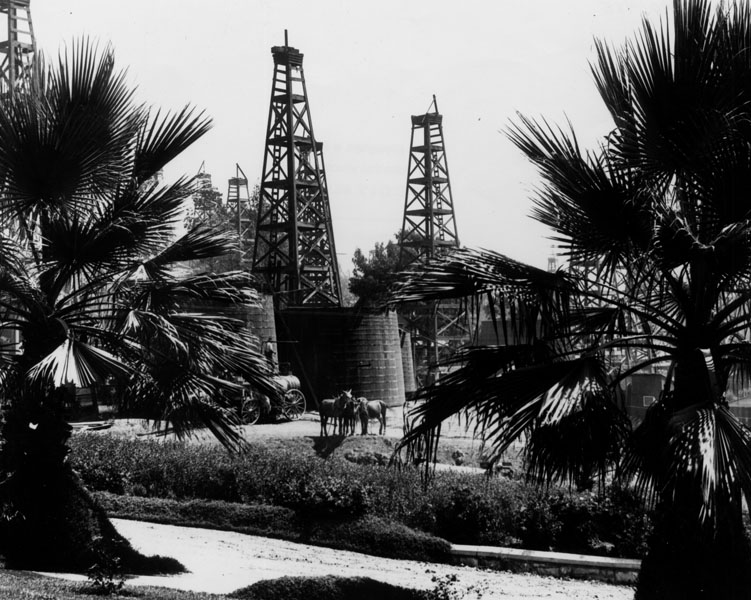 |
|
| (ca. 1890s)^ - Oil field east from the corner of 1st Street and Belmont Avenue. |
Historical Notes The price of oil peaked at $1.80 a barrel before hitting bottom at 15 cents in 1903. There was so much cheap oil that to reduce the tremendous surplus, the city began spraying it on unpaved roads to hold down the dust. |
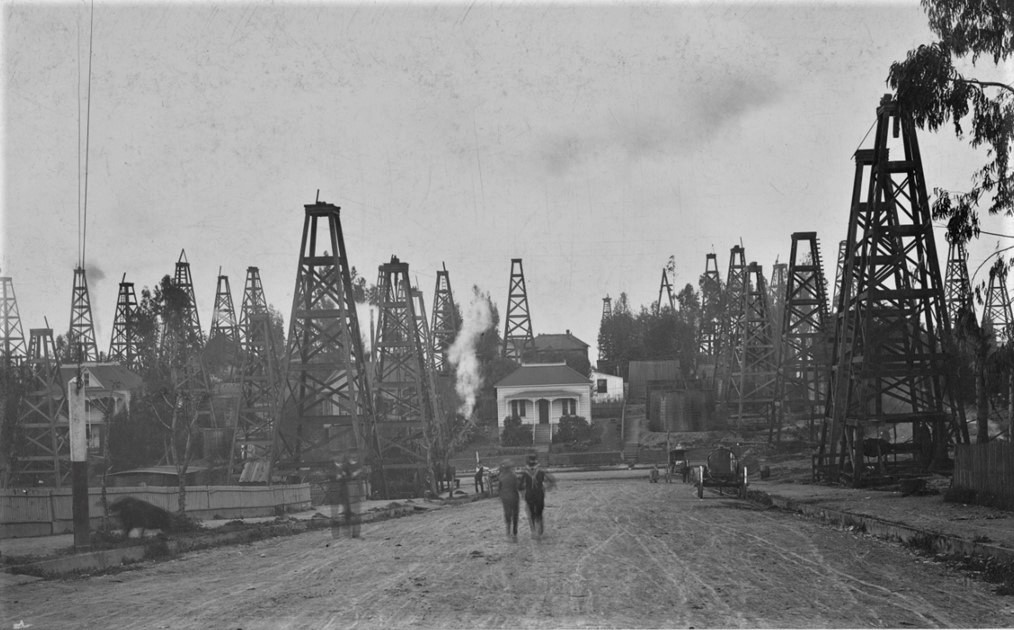 |
|
| (ca. 1908)*– View looking south on E. Edgeware Road from Angelina Street toward Court Street. The distinctive white house at the T-intersection is 1274 W. Court Street. |
Historical Notes About twenty-five oil wells along Court Street, interspersed with dwellings, make up the City Field. Almost overnight, a residential district was transformed into an oil field. 1274 W. Court Street is still there looking essentially unchanged after nearly a hundred and twenty years. |
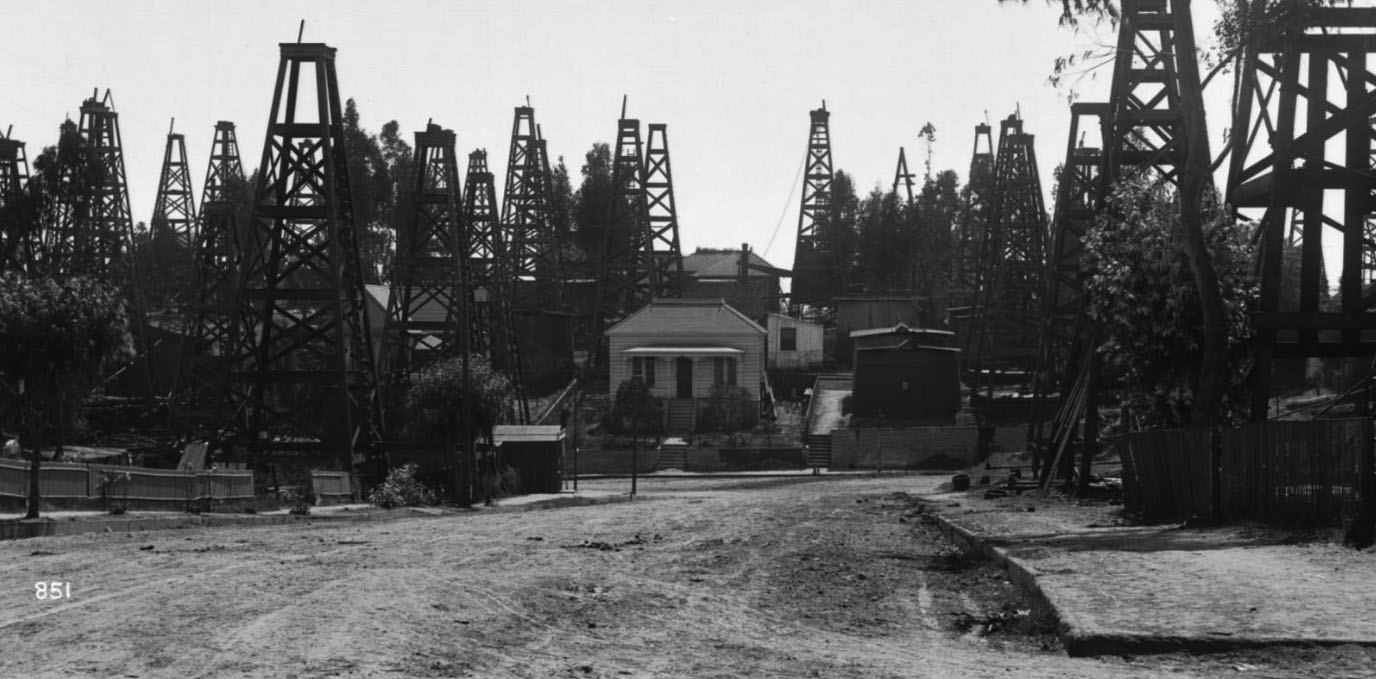 |
|
| (ca. 1908)* – Panoramic view looking south on E. Edgeware Road from Angelina Street. Court Street crossing is at the bottom of the hill. The distinctive white house at the T-intersection is 1274 W. Court Street, with 1305 W. Colton Street visible directly behind it. About twenty-five oil wells along Court Street, interspersed with dwellings, make up the City Field. Almost overnight, a residential district was transformed into an oil field. 1274 W. Court Street is still there looking essentially unchanged after nearly a hundred and fifteen years. |
Then and Now
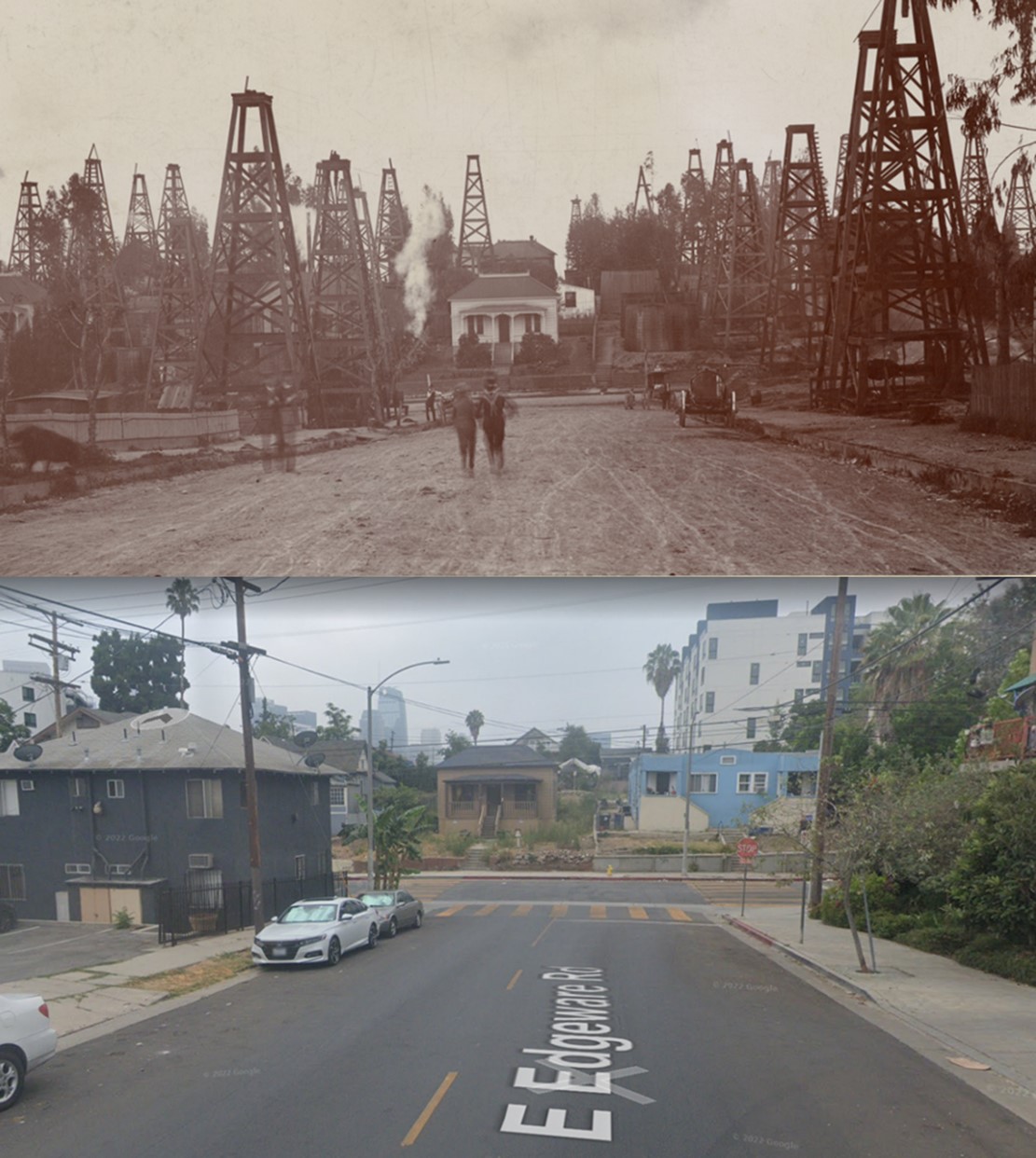 |
|
| (1908 vs 2022)* – Panoramic view looking south on E. Edgeware Road from Angelina Street. Court Street crossing is at the bottom of the hill. The distinctive white house at the T-intersection is 1274 W. Court Street, with 1305 W. Colton Street visible directly behind it. Photo comparison by Jack Feldman. |
Then and Now
.jpg) |
|
| (1902 vs 2022)* – Panoramic view looking south on E. Edgeware Road from Angelina Street. Court Street crossing is at the bottom of the hill. The distinctive white house at the T-intersection is 1274 W. Court Street, with 1305 W. Colton Street visible directly behind it. Photo comparison by Jack Feldman. |
.jpg) |
|
| (1906)^*# - Los Angeles oil fields map of the wells just west of downtown in 1906. The filled in circles represent producing wells, non-filled circles represent non-producing wells (Source: Library of Congress). |
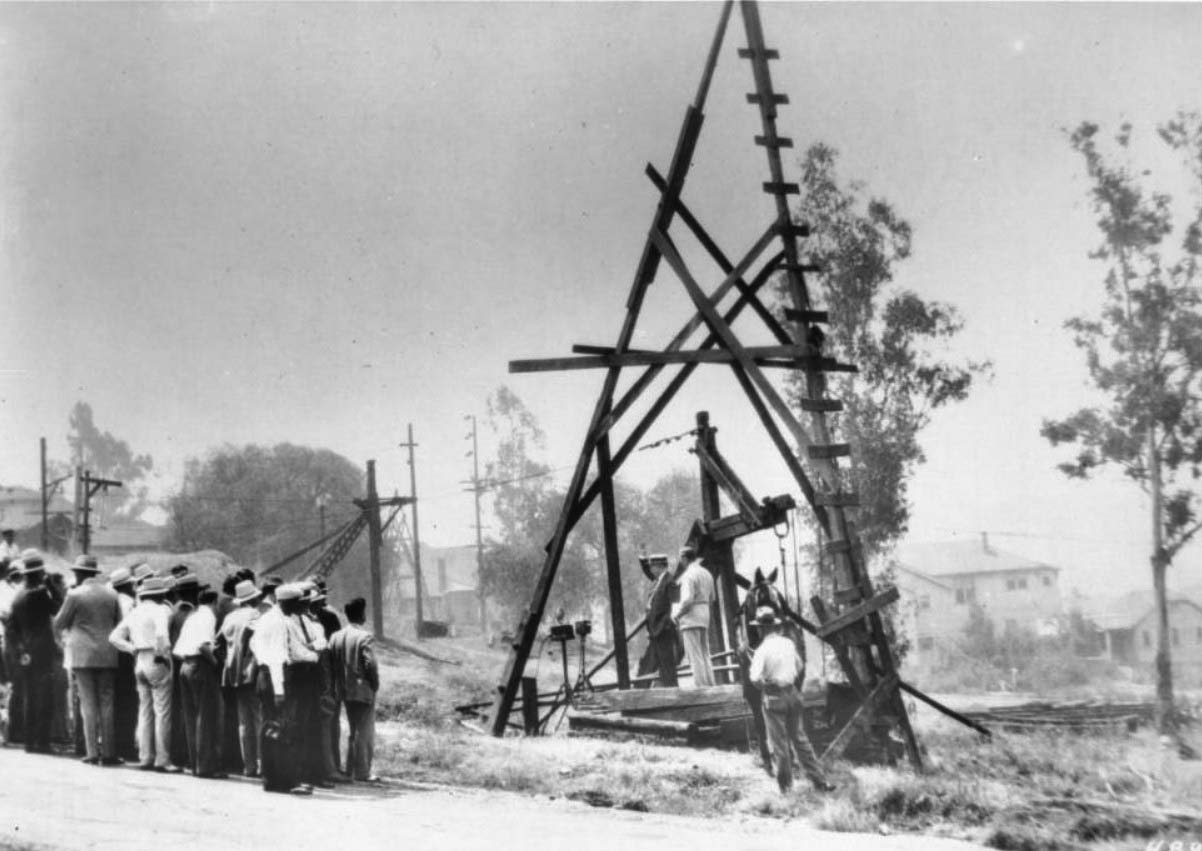 |
|
| (1930)* - Photograph of Edward L. Doheny at the site dedication ceremony for his discovery oil. Doheny, wearing a straw hat, waving, and standing under a tall triangular wooden scaffold or derrick, discovered oil in 1892 near Second Street and Glendale Boulevard (south side of Court Street, east of Patton, 2½ blocks east of Glendale Boulevard). A group of about twenty-five men clustered on the adjacent dirt road, look on. |
Historical Notes Edward Laurence Doheny (1856 - 1935) was a Californian oil tycoon who, in 1892, drilled the first successful oil well in the Los Angeles City Oil Field. His success set off a petroleum boom in Southern California, and made him a fortune when, in 1902, he sold his properties. He began highly profitable oil operations in Tampico, Mexico, drilling the first well in the nation in 1901. He expanded operations during the Mexican Revolution, and opened large new oil fields in Mexico's "golden belt" inland from Tampico. His holdings developed as the Pan American Petroleum & Transport Company, one of the largest oil companies in the world in the 1920s. In the 1920s, Doheny was implicated in the Teapot Dome Scandal and accused of offering a $100,000 bribe to United States Secretary of the Interior Albert Fall. Doheny was twice acquitted of offering the bribe, but Fall was convicted of accepting it. Doheny and his second wife and widow, Carrie Estelle, were noted philanthropists in Los Angeles, especially regarding Catholic schools and charities. The character J. Arnold Ross in Upton Sinclair's 1927 novel Oil! (the inspiration for the 2007 film There Will Be Blood) is loosely based on Doheny. |
Click HERE to see more on Los Angeles Oil Field |
* * * * * |
Please Support Our CauseWater and Power Associates, Inc. is a non-profit, public service organization dedicated to preserving historical records and photos. Your generosity allows us to continue to disseminate knowledge of the rich and diverse multicultural history of the greater Los Angeles area; to serve as a resource of historical information; and to assist in the preservation of the city's historic records.
|
More Historical Early Views
Newest Additions
Early LA Buildings and City Views
History of Water and Electricity in Los Angeles
* * * * * |
References and Credits
* DWP - LA Public Library Image Archive
^ LA Public Library Image Archive
*#Publications of the Historical Society of Southern California, Volume 9: Eternity Street
*#^Historic Hotels of Los Angeles and Hollywood (USC - California Historic Society):; Belmont Hotel
***Los Angeles Historic - Cultural Monuments Listing
*v*OnBunkerHill.org: Second Street Cable Railway
*^*California Historical Landmarks Listing (Los Angeles)
*^#Public Art in LA: Campo Santo
^^^LA Times: The Gush of Oil Was Music to 'Queen's' Ears
^*#Noirish Los Angeles - forum.skyscraperpage.com; Sunset and San Fernando Hotels; Belmont Hotel View; 1st Electric Trolley
*##Metro.net - Los Angeles Transit History
^##California State Library Image Archive
###Denver Public Library Image Archive
#^*Flickr.com: Michael Ryerson
#**Historic Los Angeles Theaters: Child's Opera House
#*^LA Conservancy: Boyle Hotel
#^^Historical Buildings - boyleheightsbeat.com
+^^Kansas Historic Society: Atchison, Topeka, and Santa Fe Railway Company
+++Mt. Lowe Preservation Society
*#*KCET - Inventing LA: Port of Los Angeles; Belmont Hotel View; A Brief History of Palm Trees; How LA Lost One of its Earliest Parks; Rediscovering Downtown L.A.'s Lost Neighborhood of Bunker Hill; Fort St. to Broadway
**#The Cable-Car-Guy.com: The Los Angeles Railway; Temple Street Cable Railway
**^History Matters: Calle de los Negros, 1880s
^^*LA Fire Department Historical Archive; Belmont Hotel Fire
****Theeastsiderla.com: Angelino Heights Oil Boom
^^#^The George A. Eslinger Street Lighting Photo Gallery
*##^The Street Railway History of Los Angeles - erha.org
^##*Pacific Coast Architecture Database (PCAD): Bryson-Bonebrake Block
^#^*Nathan Masters: Los Angeles From the Air, 1887 vs. 2013
^^^*Rails West: City Street Railways
^*^* KCET: LA's First Streetcars
^*^^San Fernando Valley Historical Society/Facebook.com: Burbank Villa Hotel
^*#*Panoramonview.org: Paorama of the Siege of Paris
^^^#LA Creek Freak: Arroyo de los Reyes
*^^*Los Angeles Past: Requena/Market St.
*^^#Boyle Heights History Blog: Los Angeles Cable Railway Construction
*^*#Paradise Leased: Arcadia Hotel
^^**LMU Digital Collection: Arcadia Hotel
*#*#Santa Monica Beach Stories
^#^# San Fernando Valley Relics: The Palms of San Fernando
#*^*The River Project: Taylor Yard
#^**Facebook.com: West San Fernando Valley Then And Now
#^*^Calisphere: University of California Image Archive
#^^^Southland.gizmodo.com: LA Once Had Cable Cars
##^^Flickr.com: Views of Los Angeles
^**^Wikipedia Images: Early L.A. Oil Wells
*^ Wikipedia: Arcadia Bandini de Stearns Baker; Bunker Hill; Prudent Beaudry; Jonathan Temple; Los Angeles High School; Joseph Widney; Pershing Square; Port of Los Angeles; Belmont High School; Hollenbeck Park; Ducommun; Isaias W. Hellman; Abel Stearns; Sawtelle, Los Angeles; Sawtelle Veterans Home; Arcade Station; Alhambra; Fort Moore; History of Santa Monica; History of Los Angeles; Burbank; Belmont High School; Mt. Lowe Railway; Los Angeles City Oil Field; History of Los Angeles Population Growth; Garvanza, Los Angeles; Highland Park; Compton; Harrison Gray Otis; Los Angeles City Hall; Angelino Heights; Boyle Heights; Boyle Hotel - Cummings Block; History of Transportation in California; Mount Lowe Railway
< Back
Menu
- Home
- Mission
- Museum
- Major Efforts
- Recent Newsletters
- Historical Op Ed Pieces
- Board Officers and Directors
- Mulholland/McCarthy Service Awards
- Positions on Owens Valley and the City of Los Angeles Issues
- Legislative Positions on
Water Issues
- Legislative Positions on
Energy Issues
- Membership
- Contact Us
- Search Index